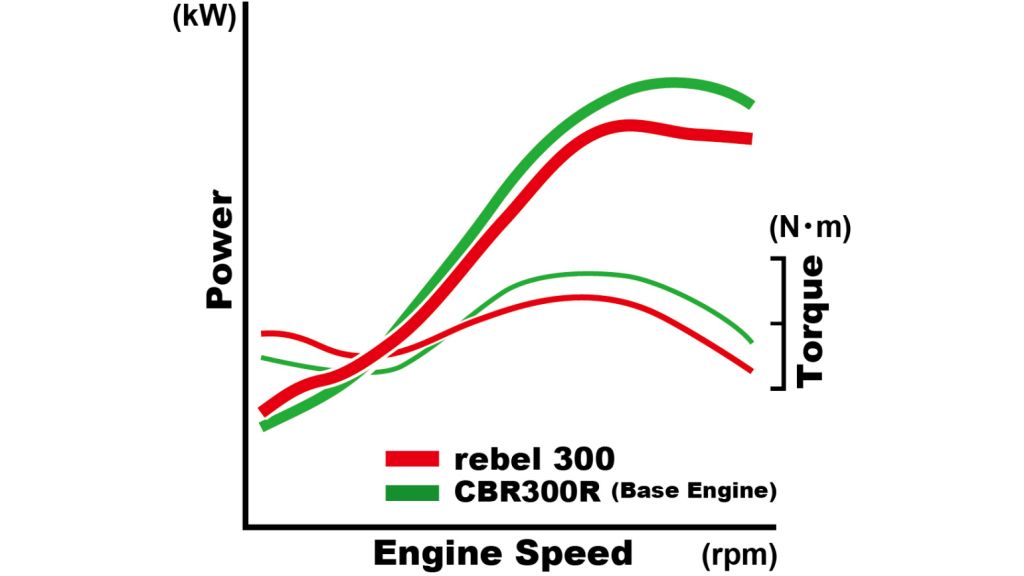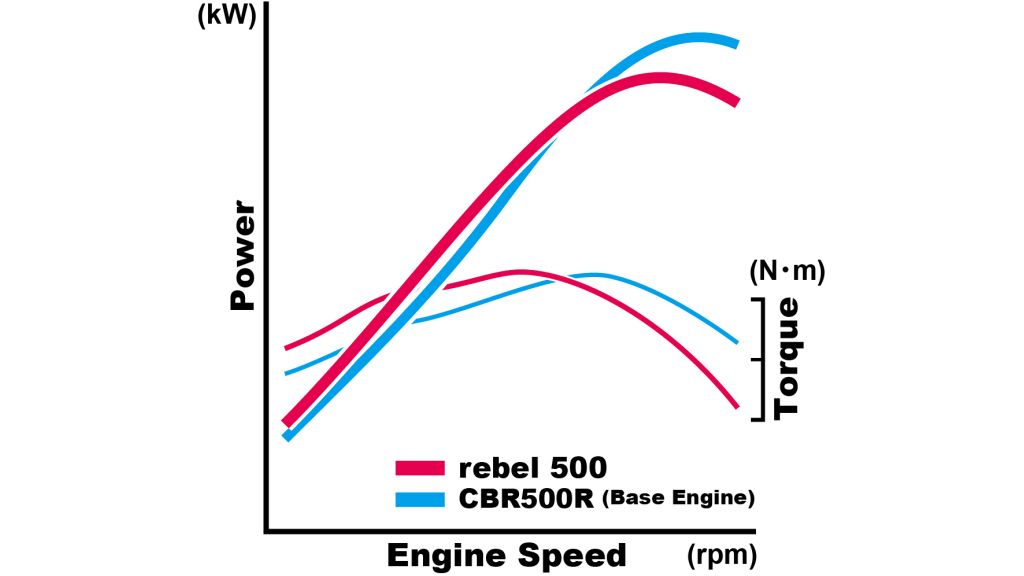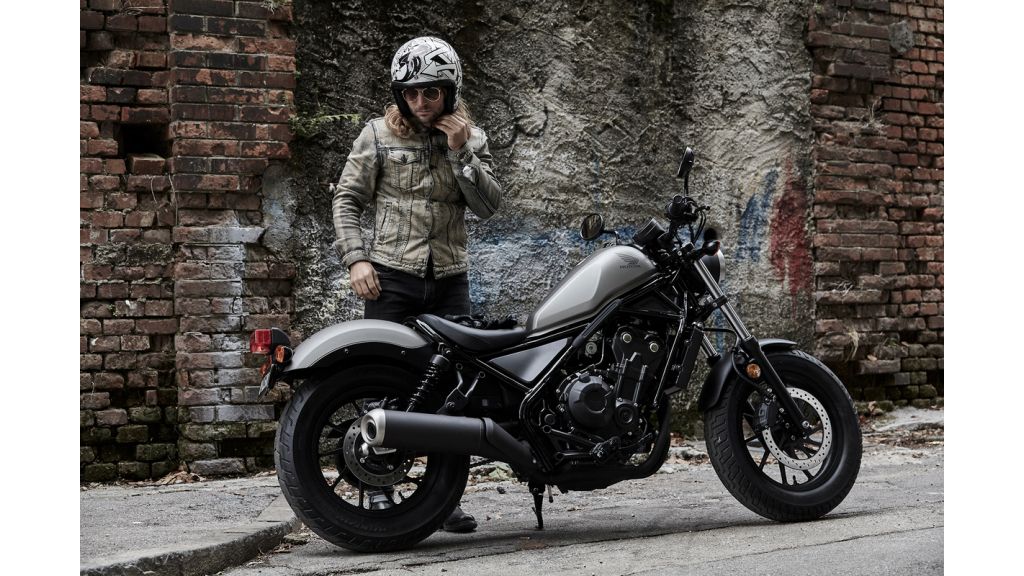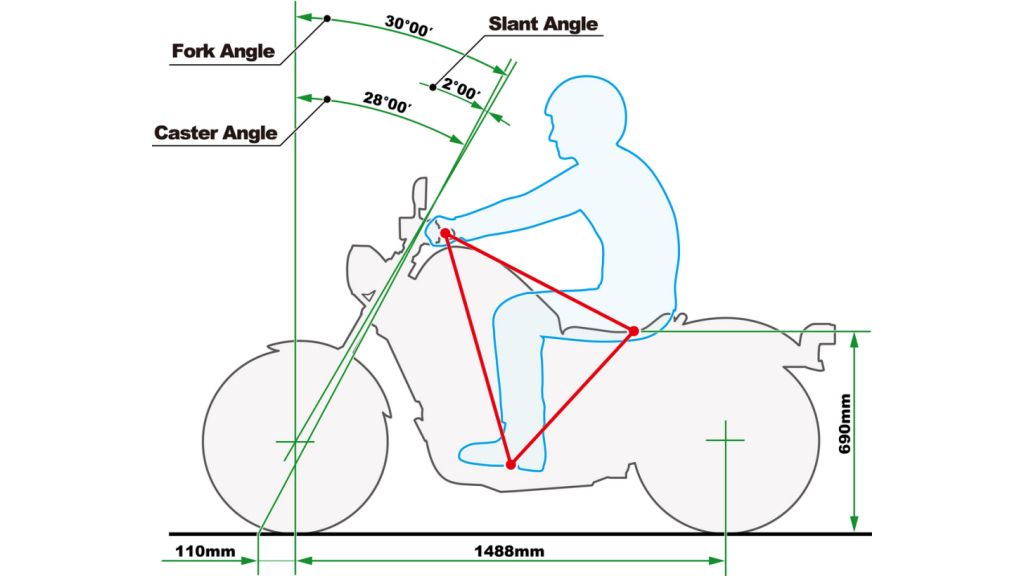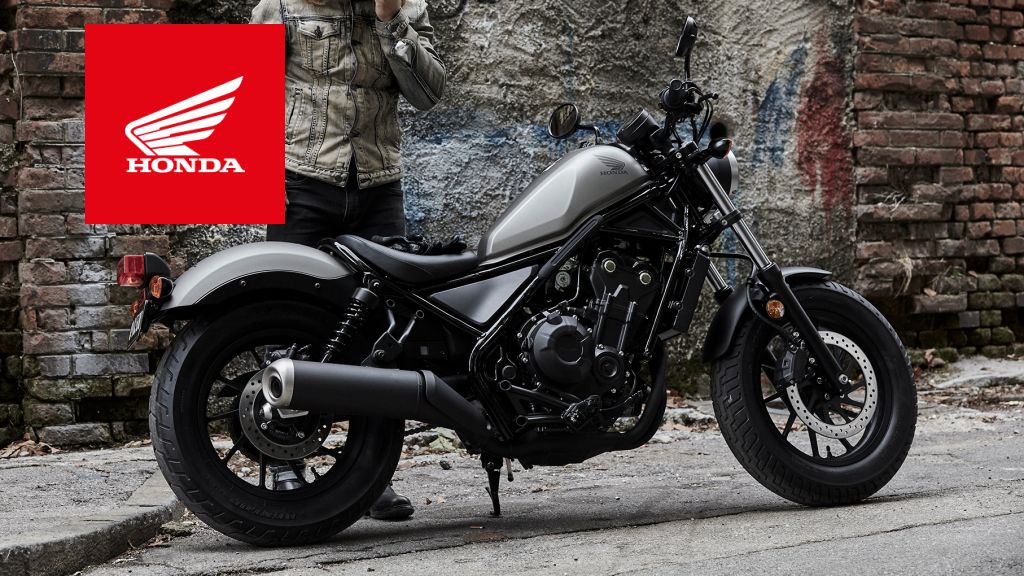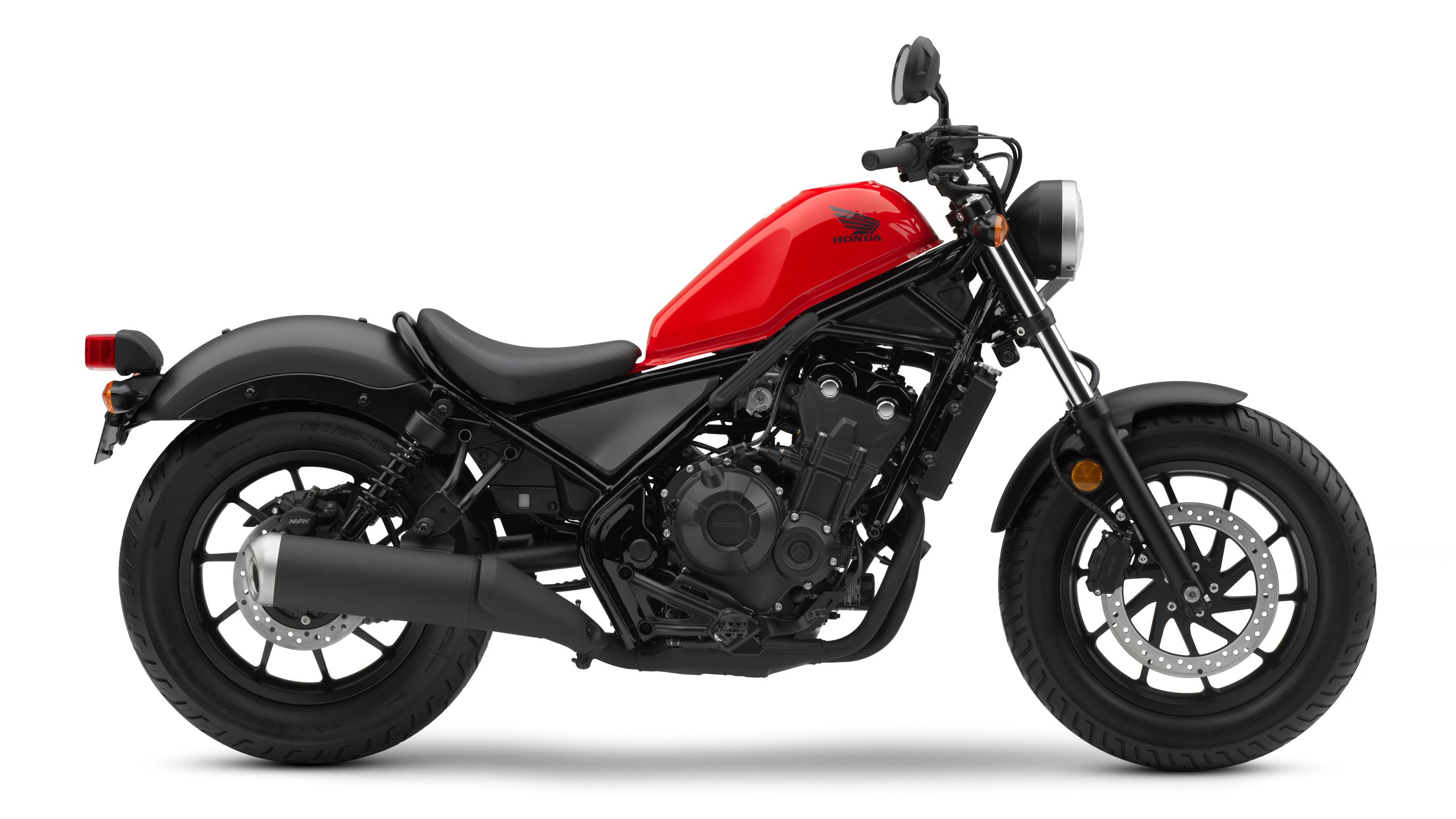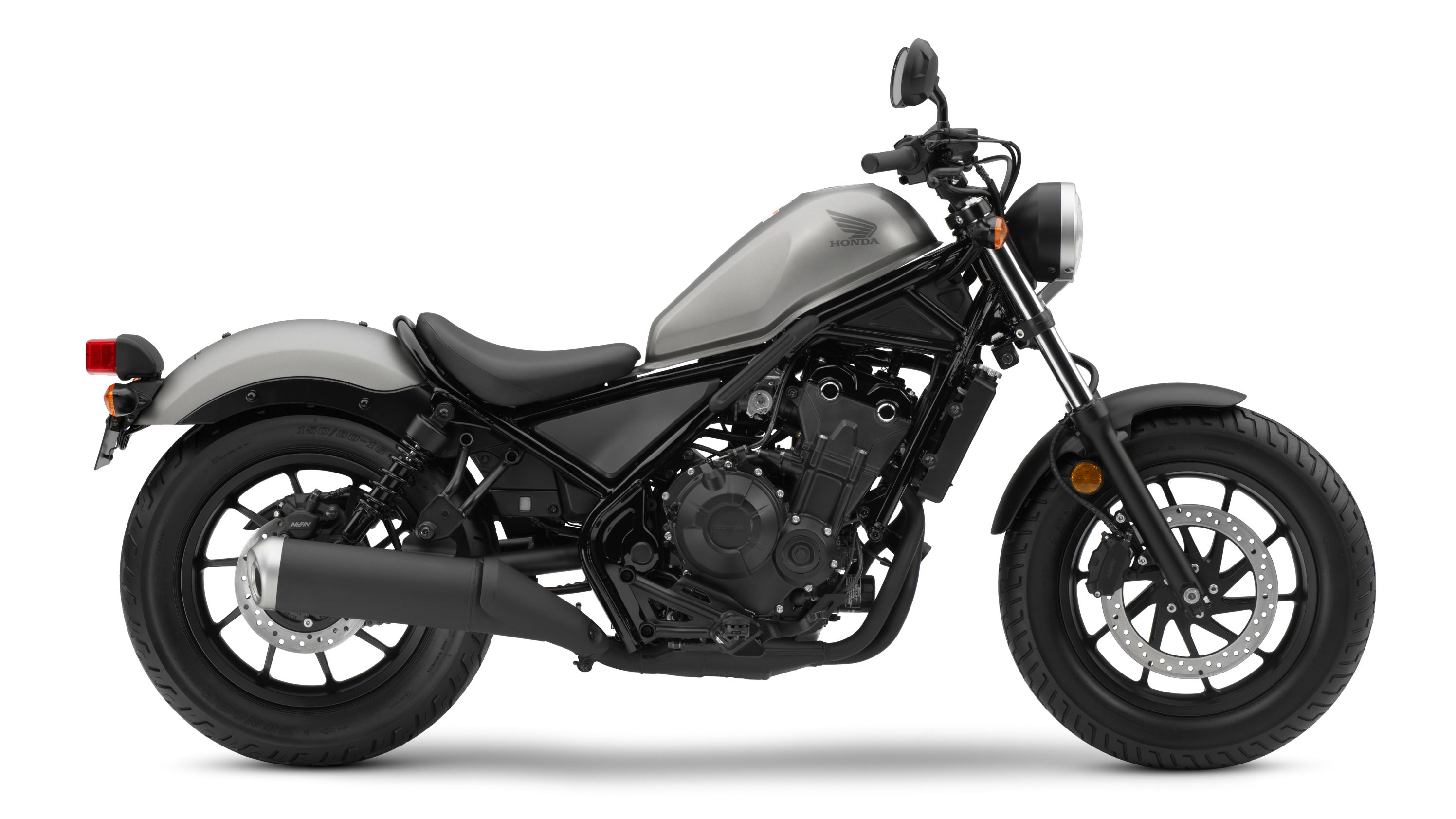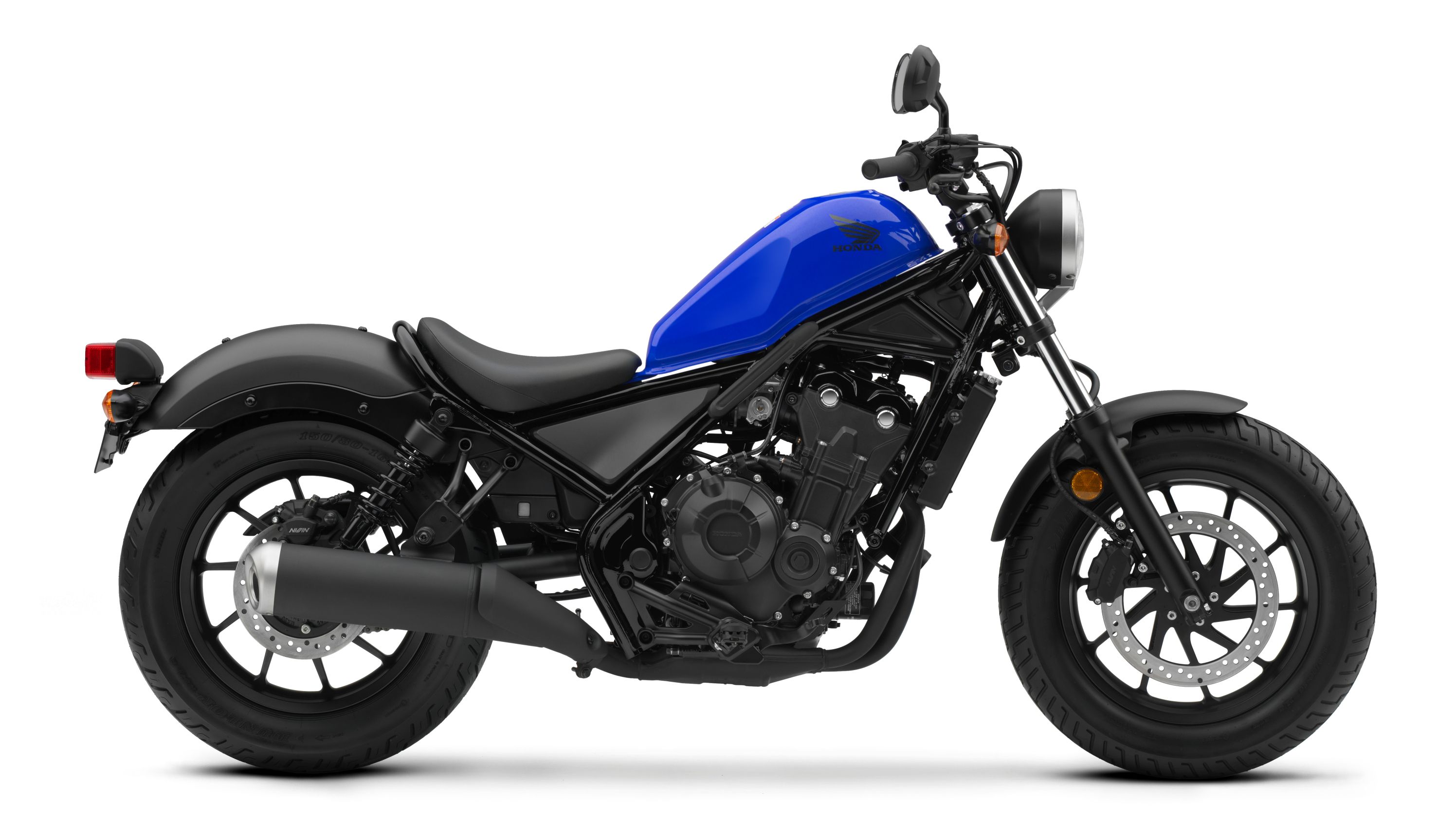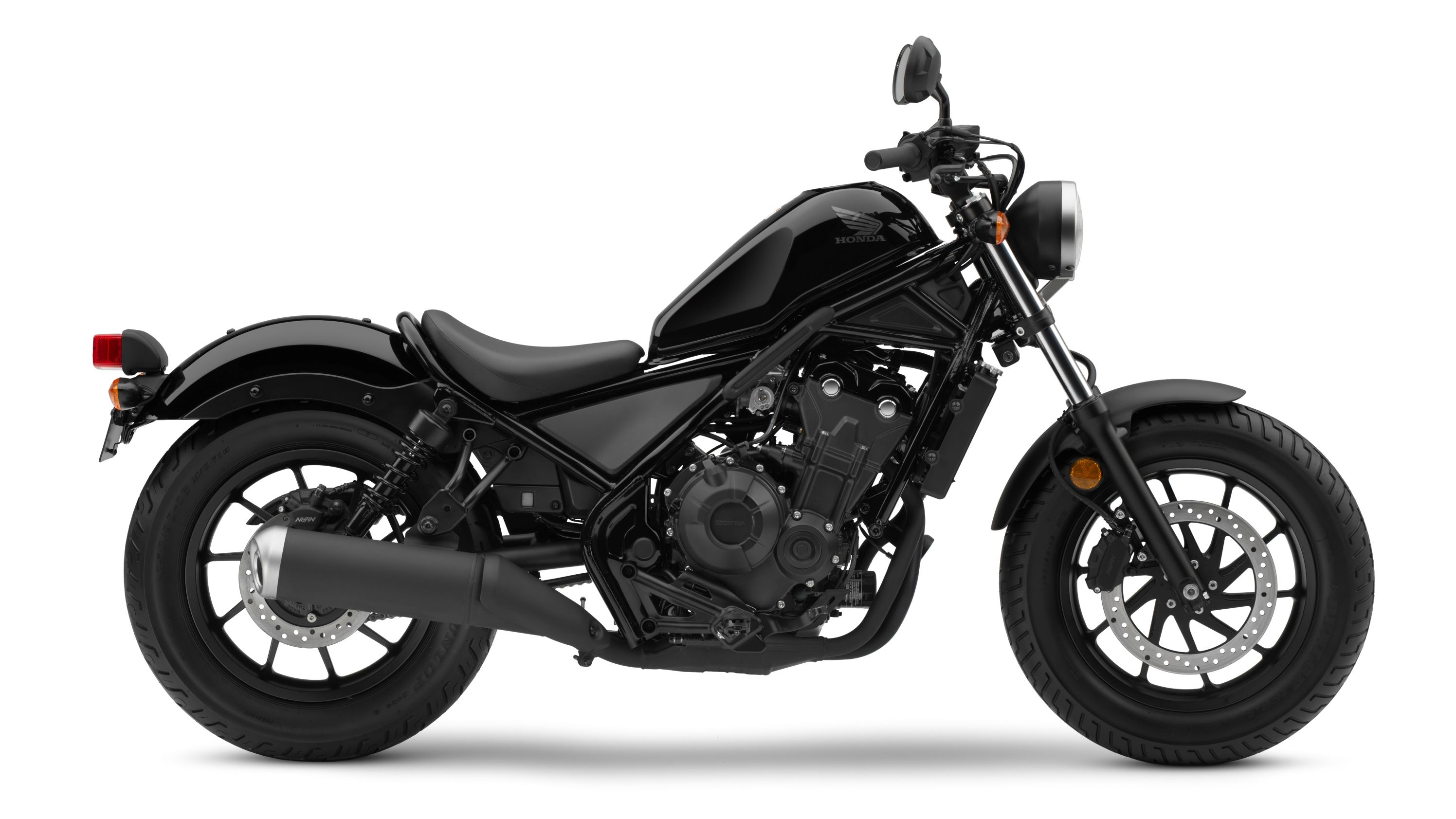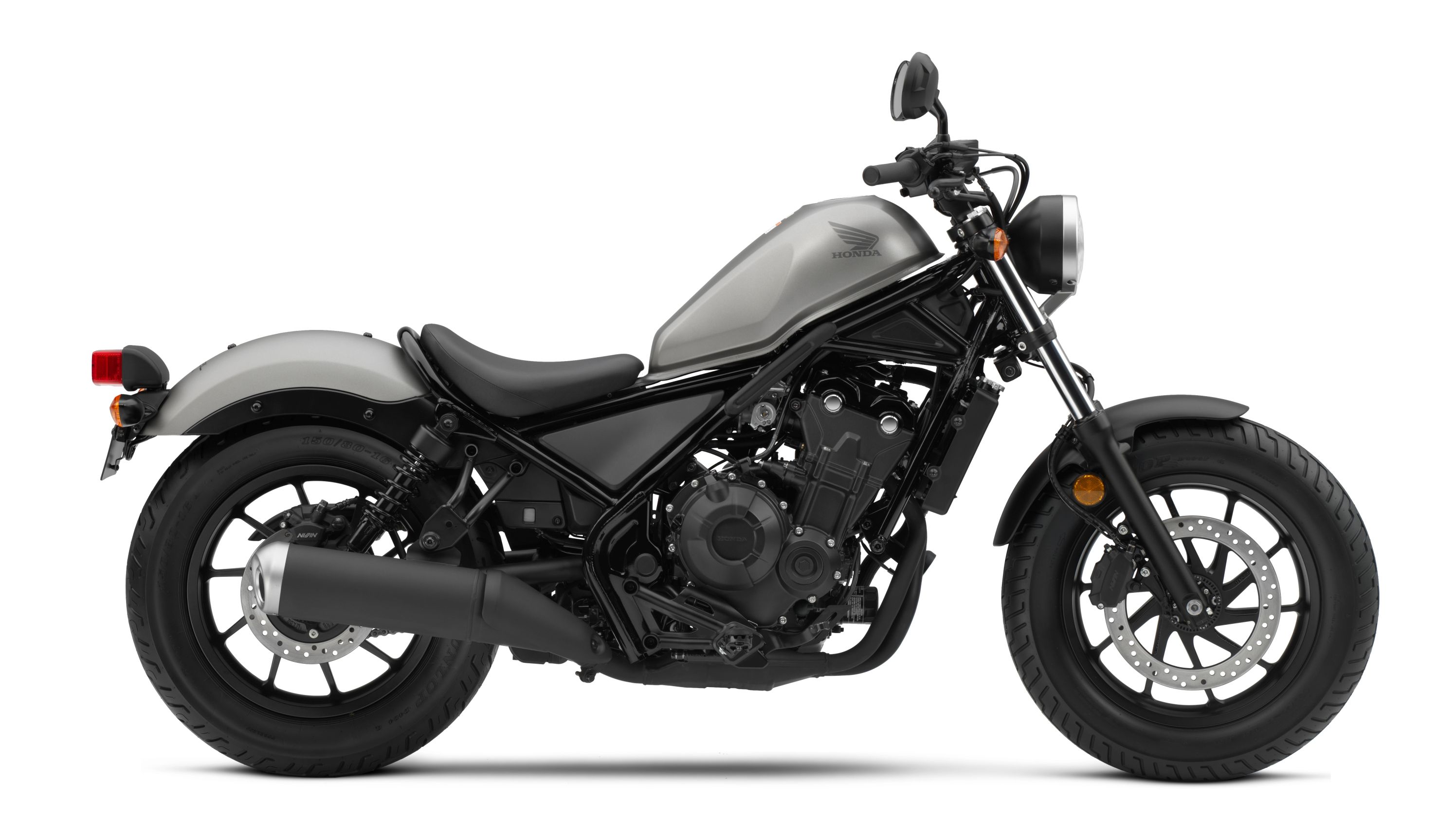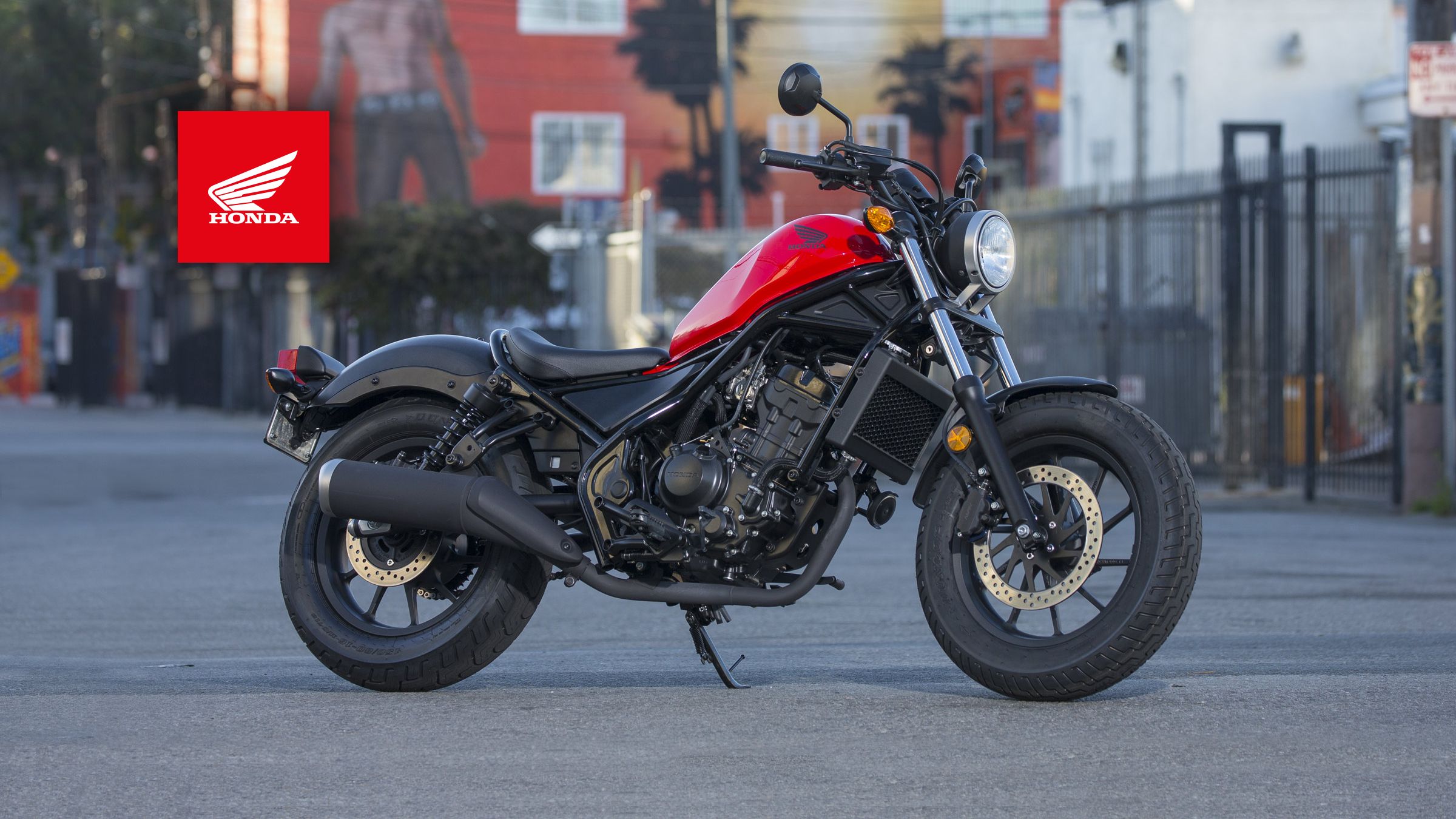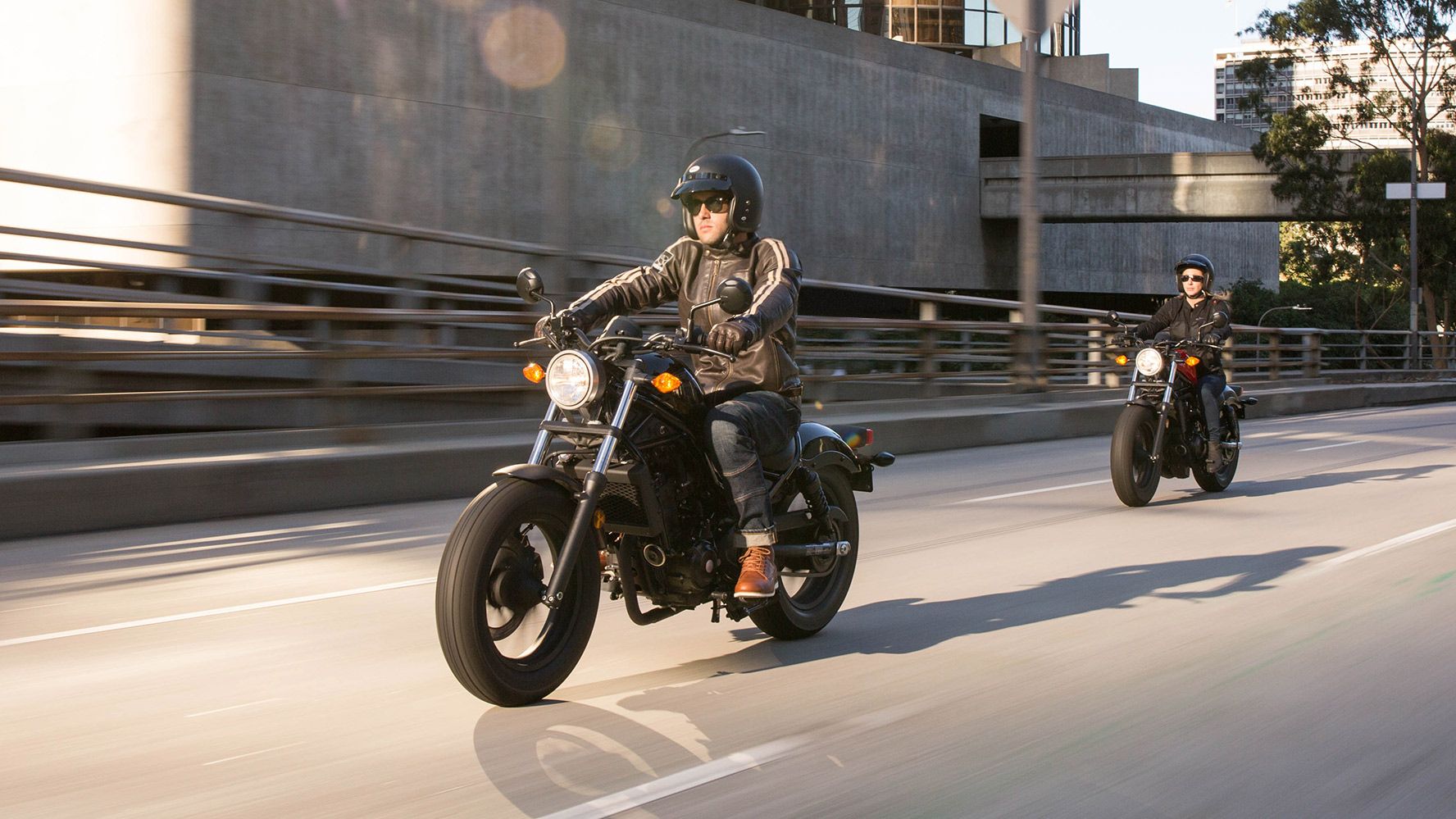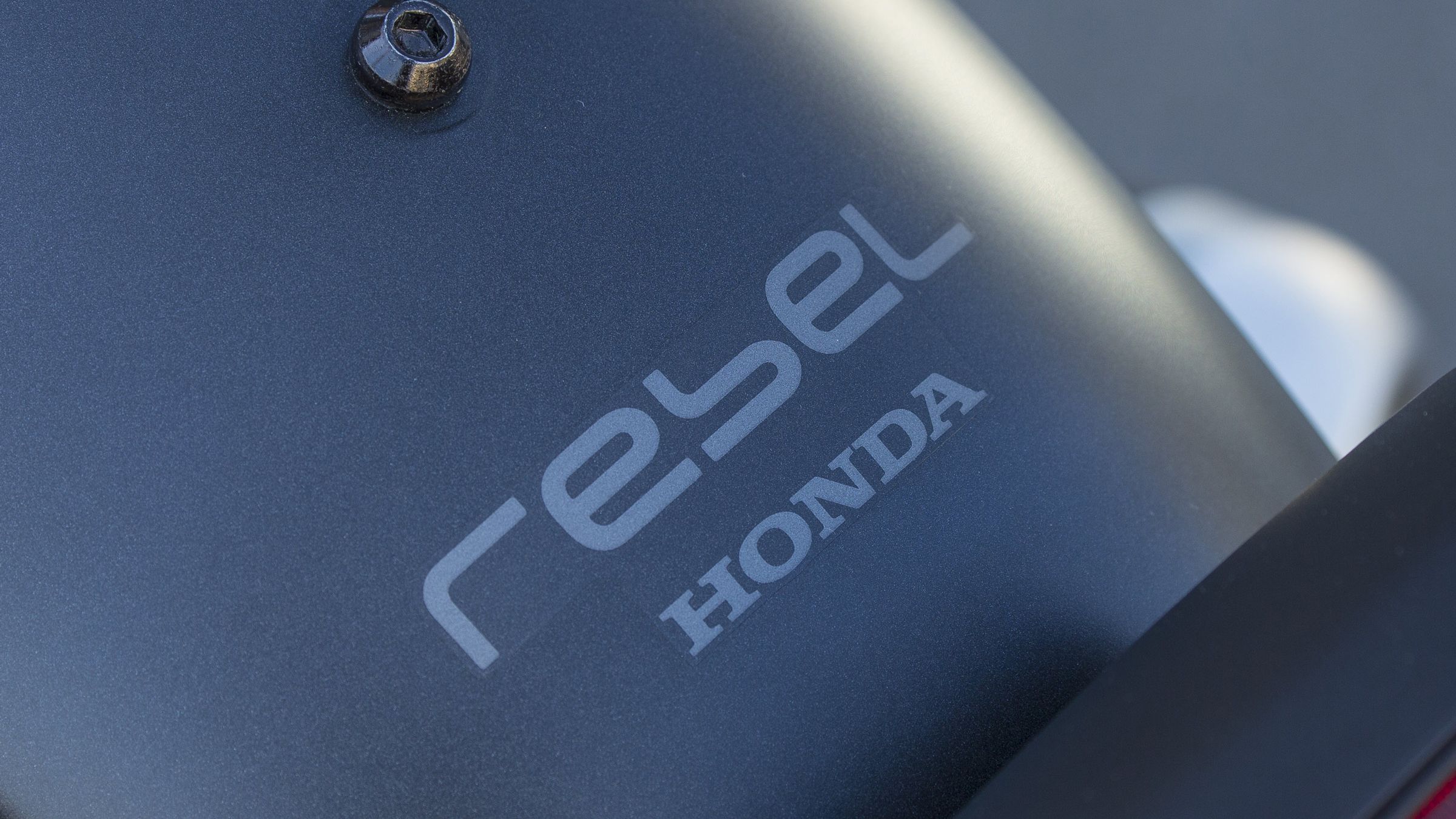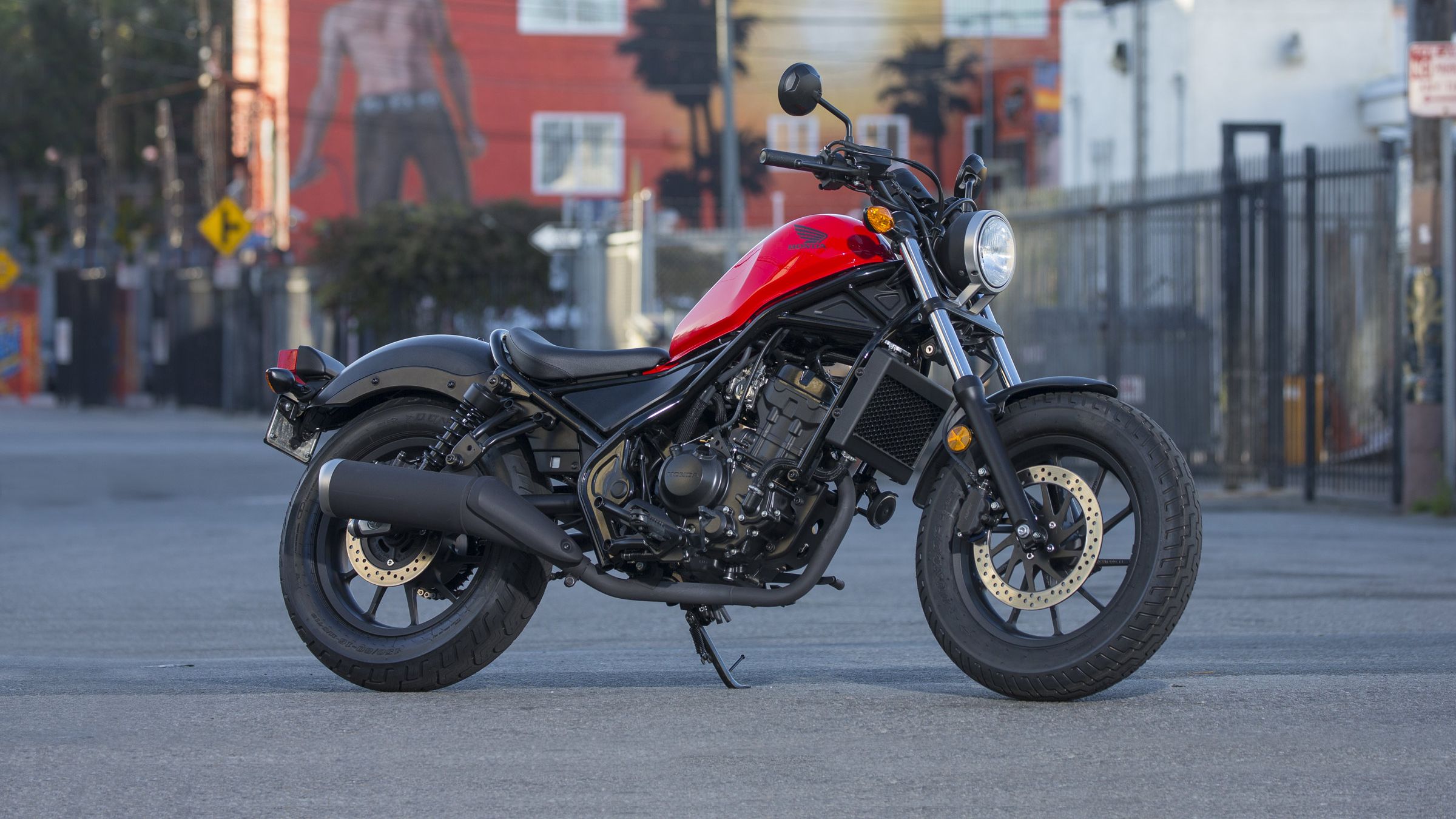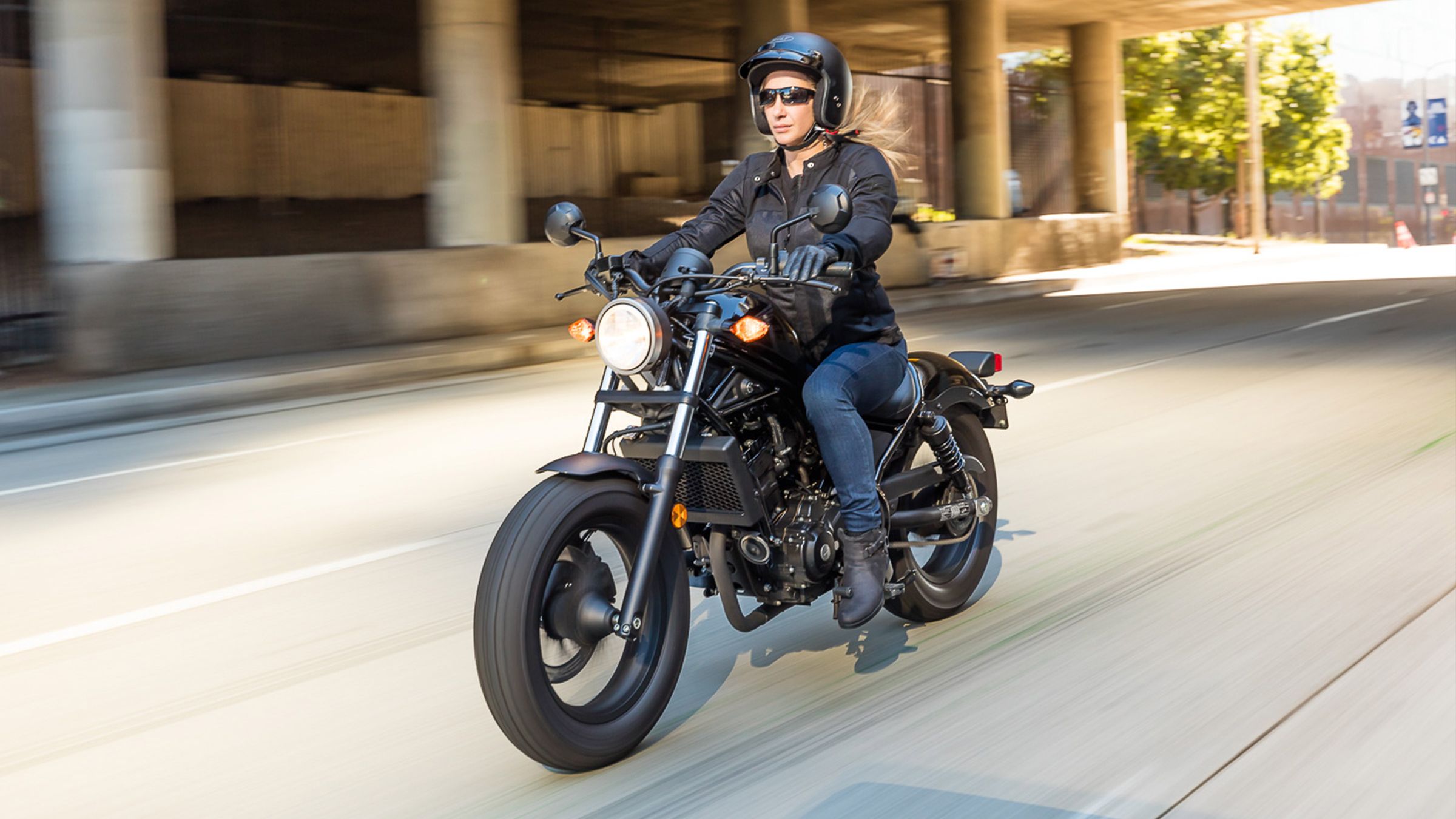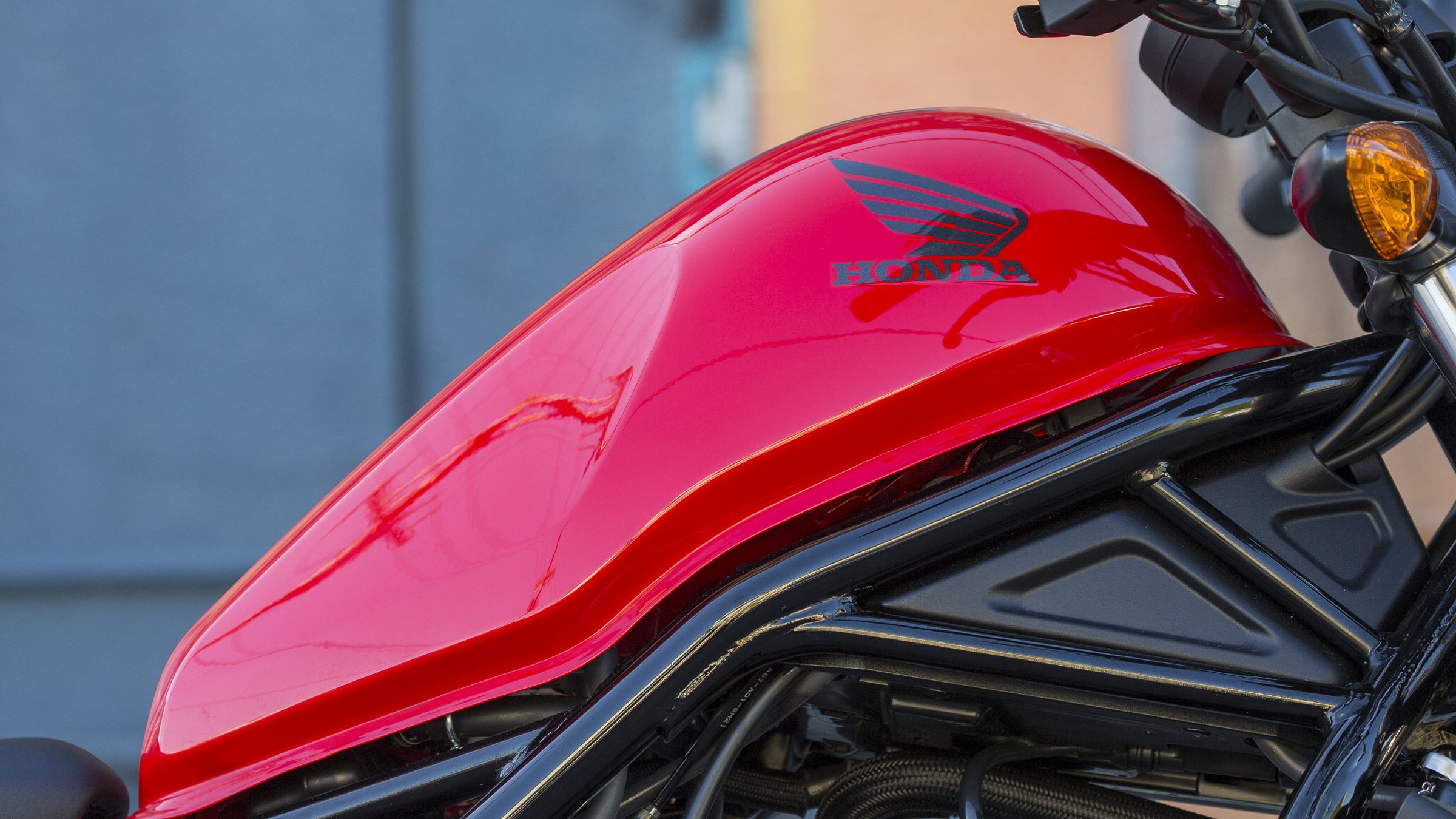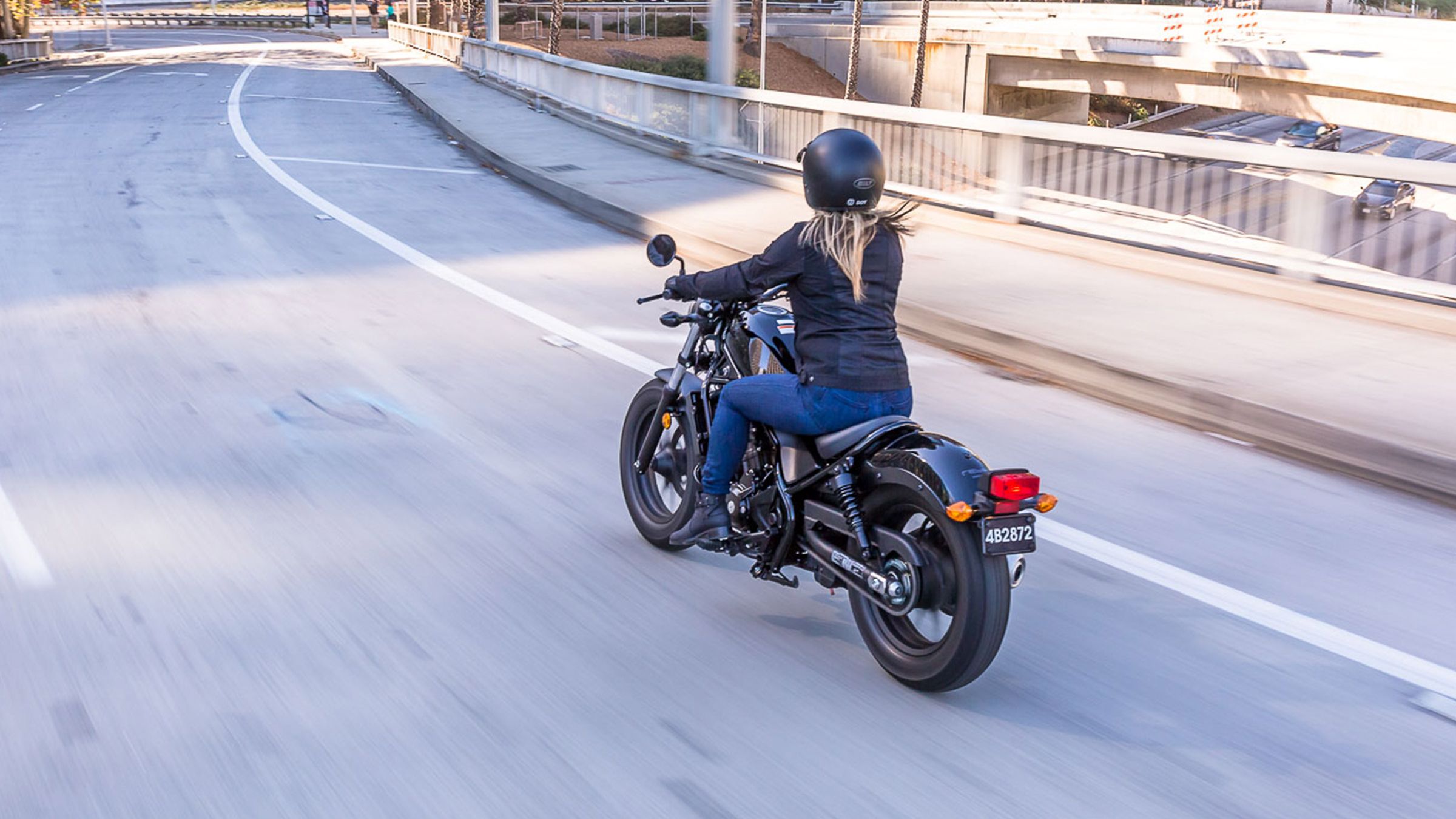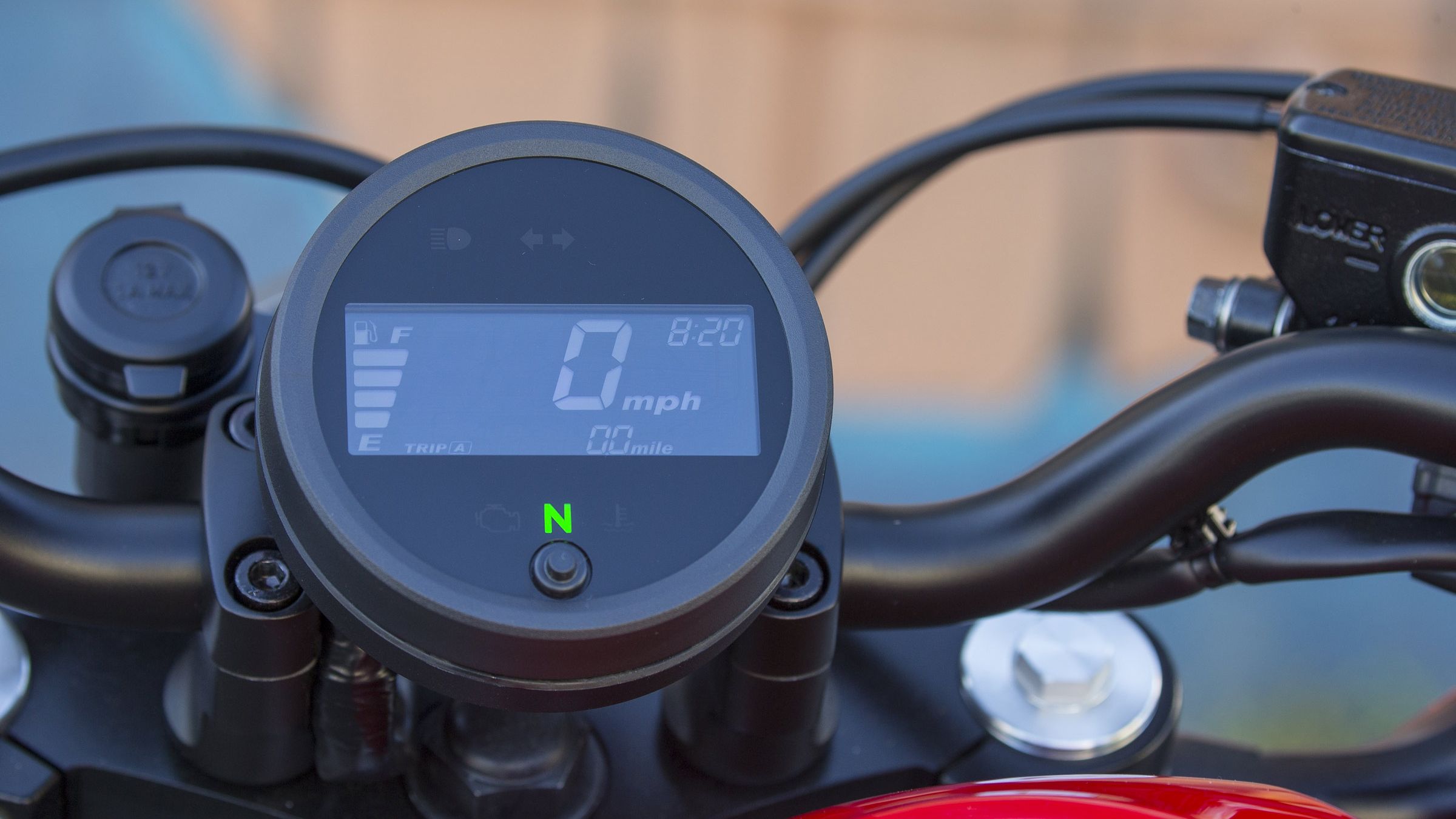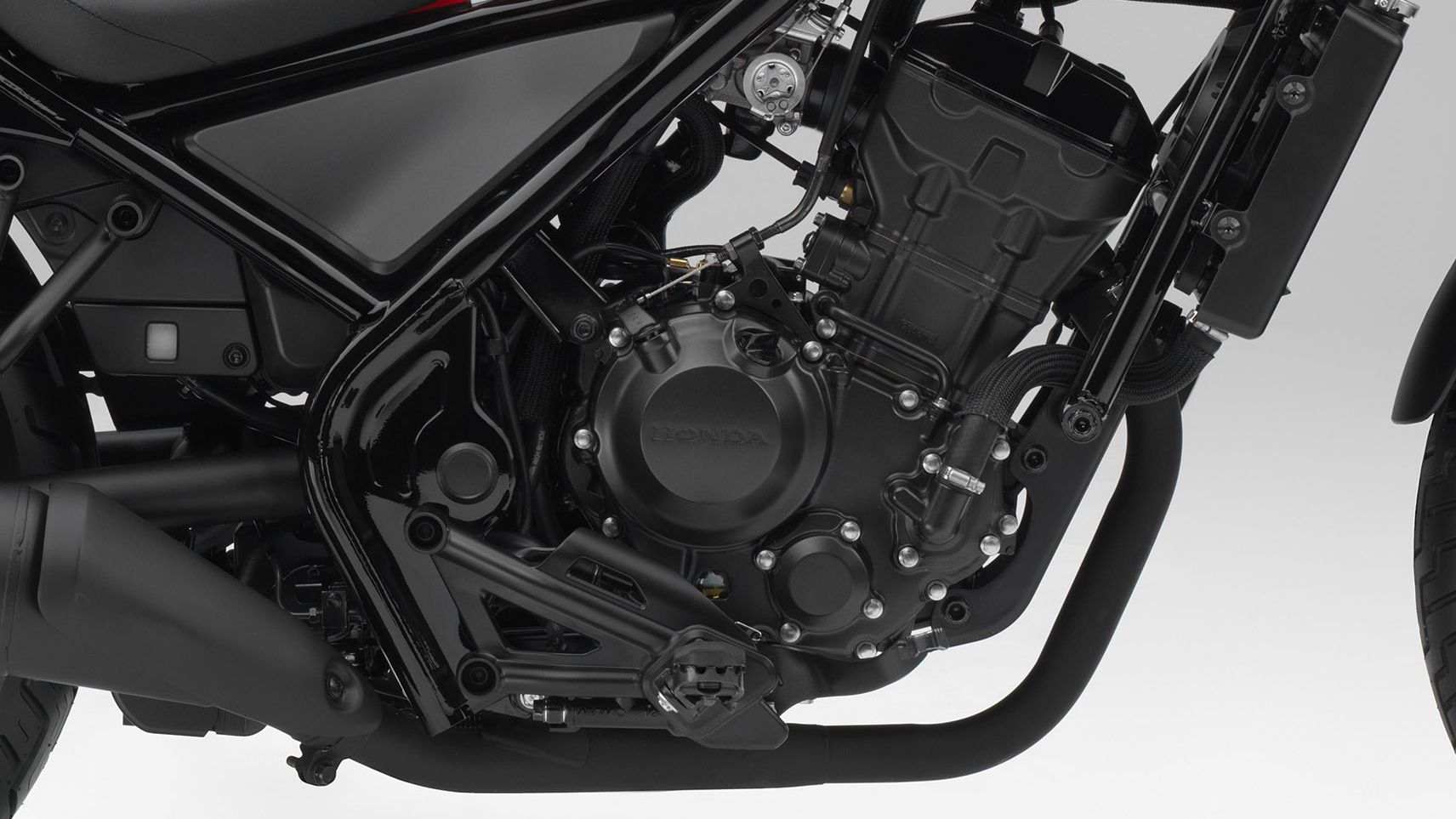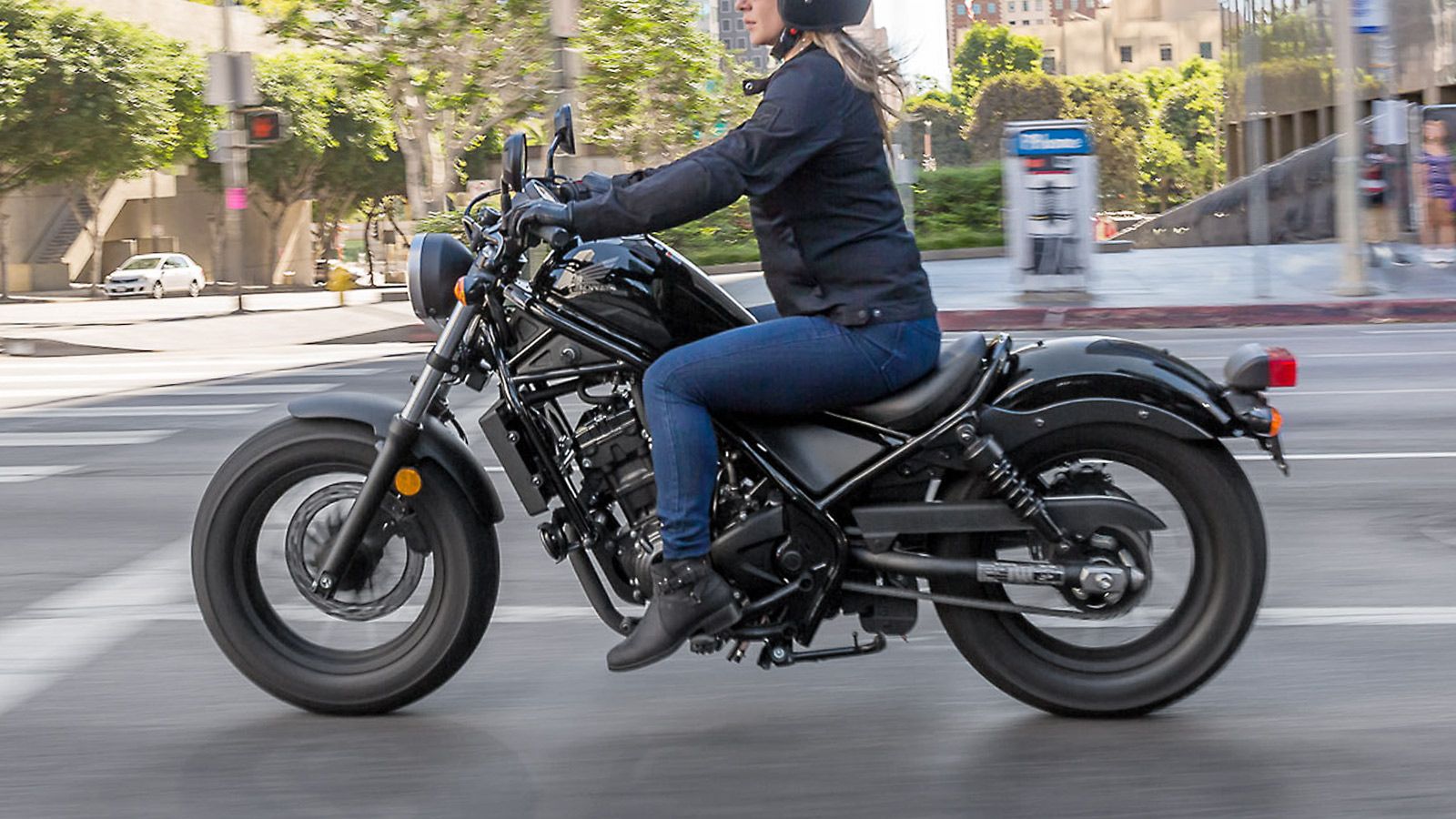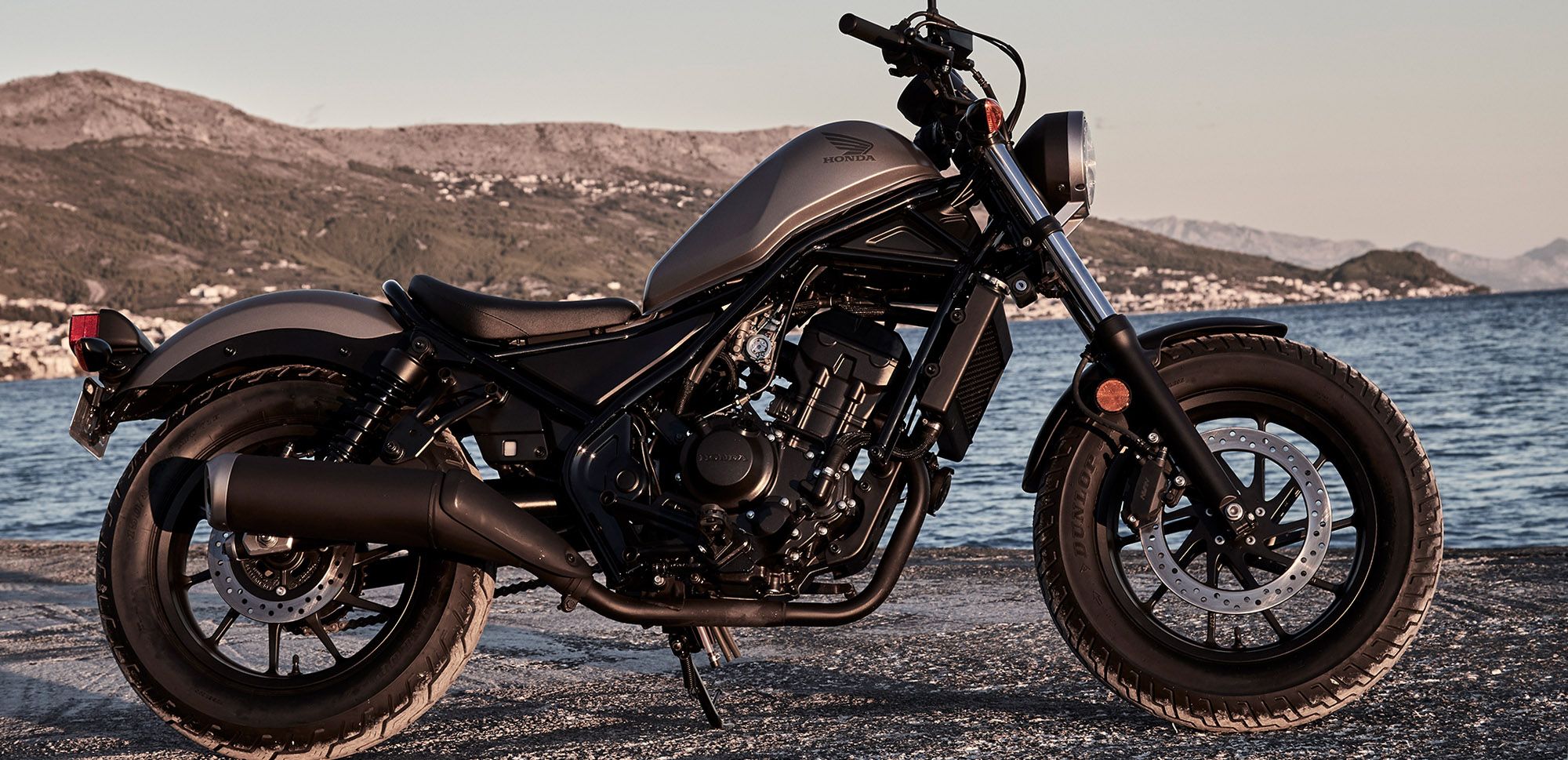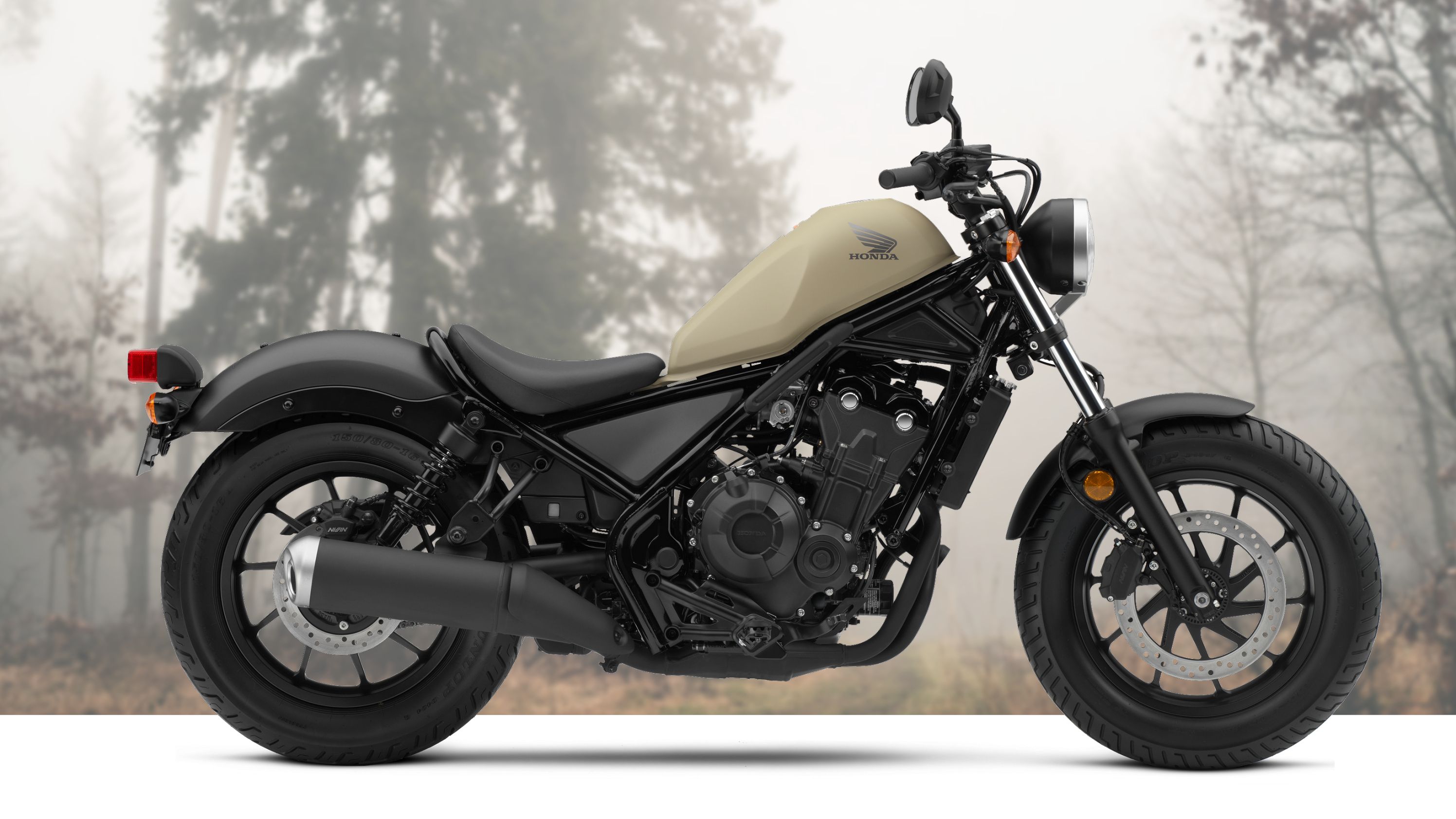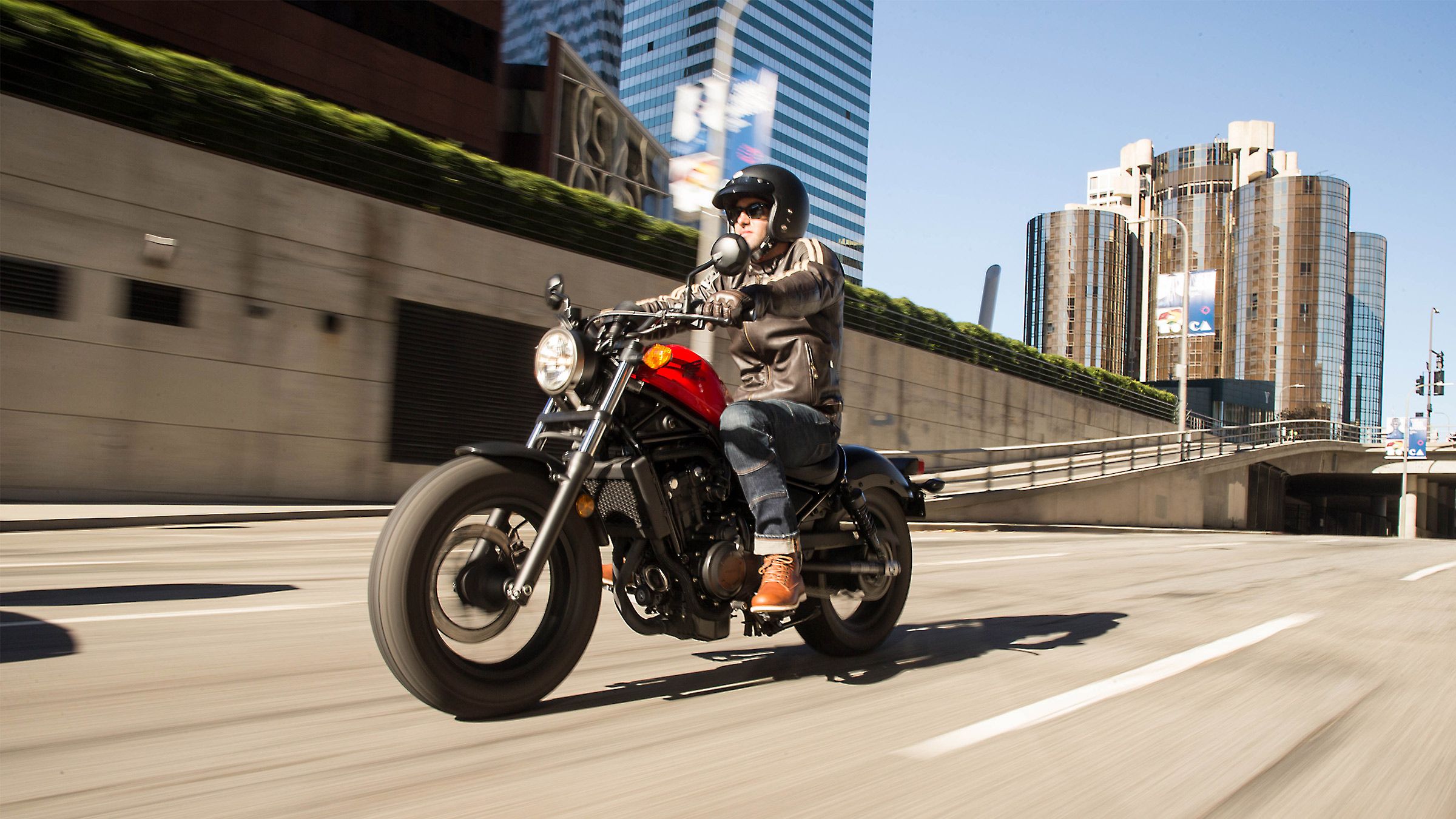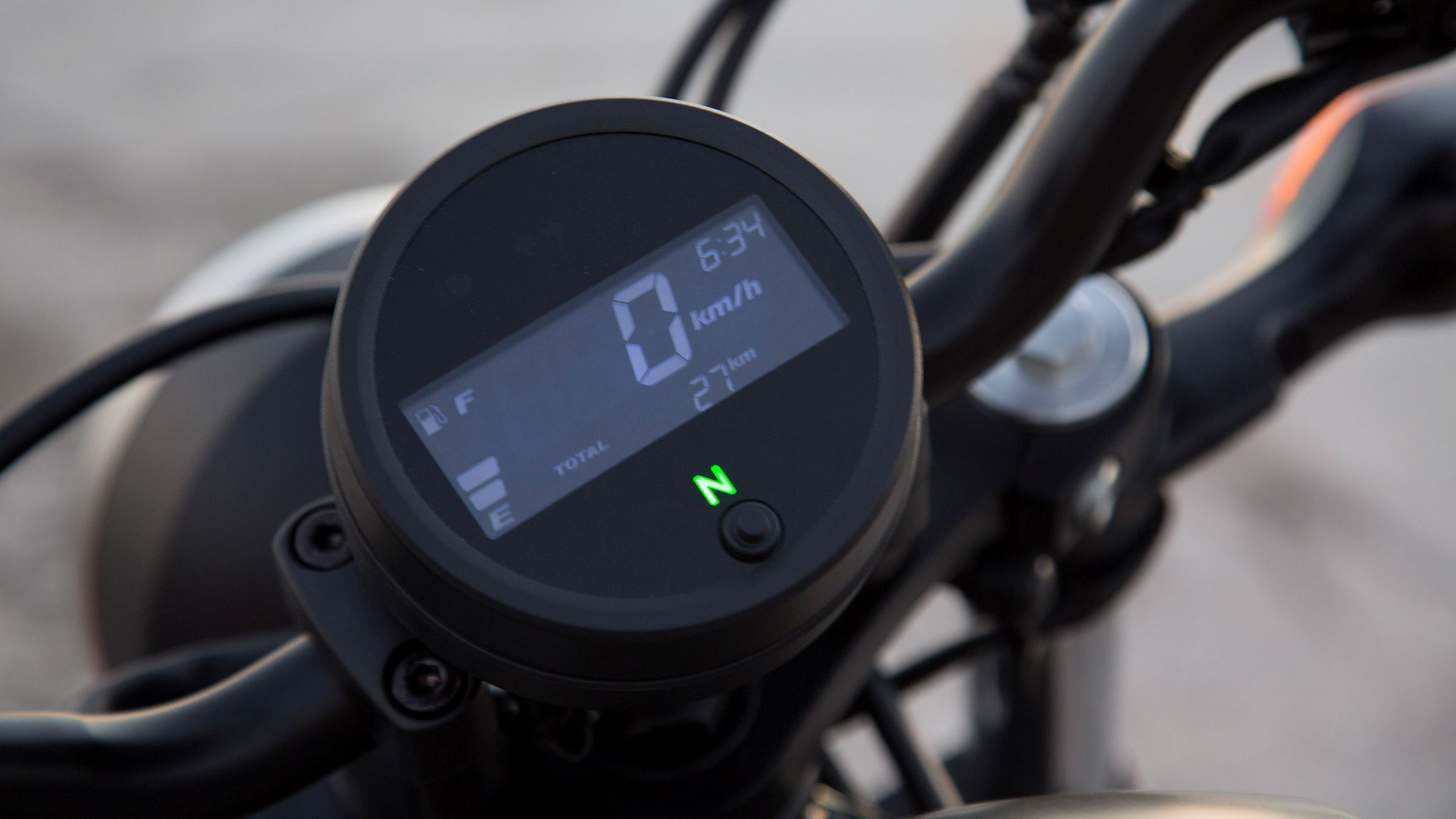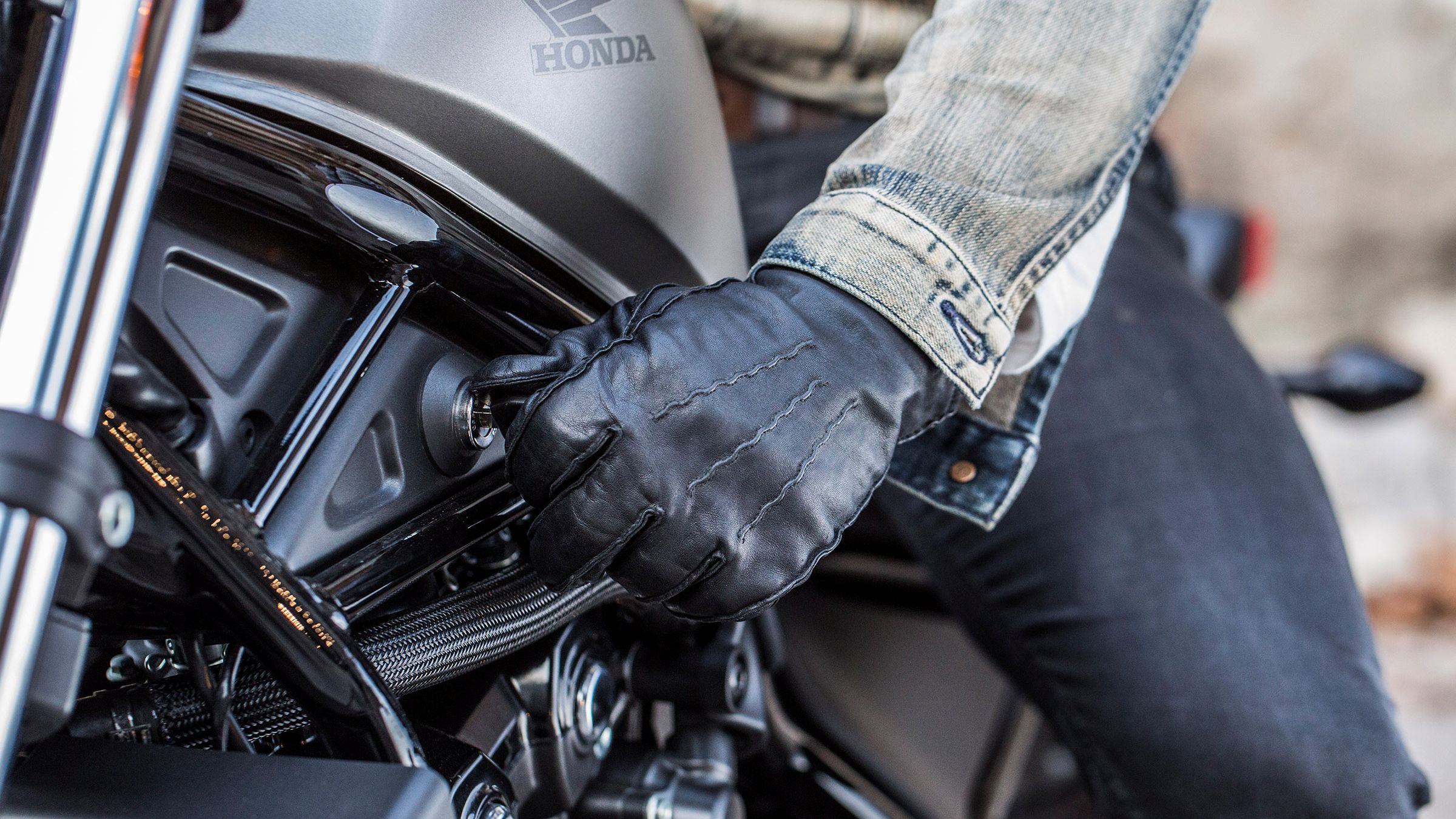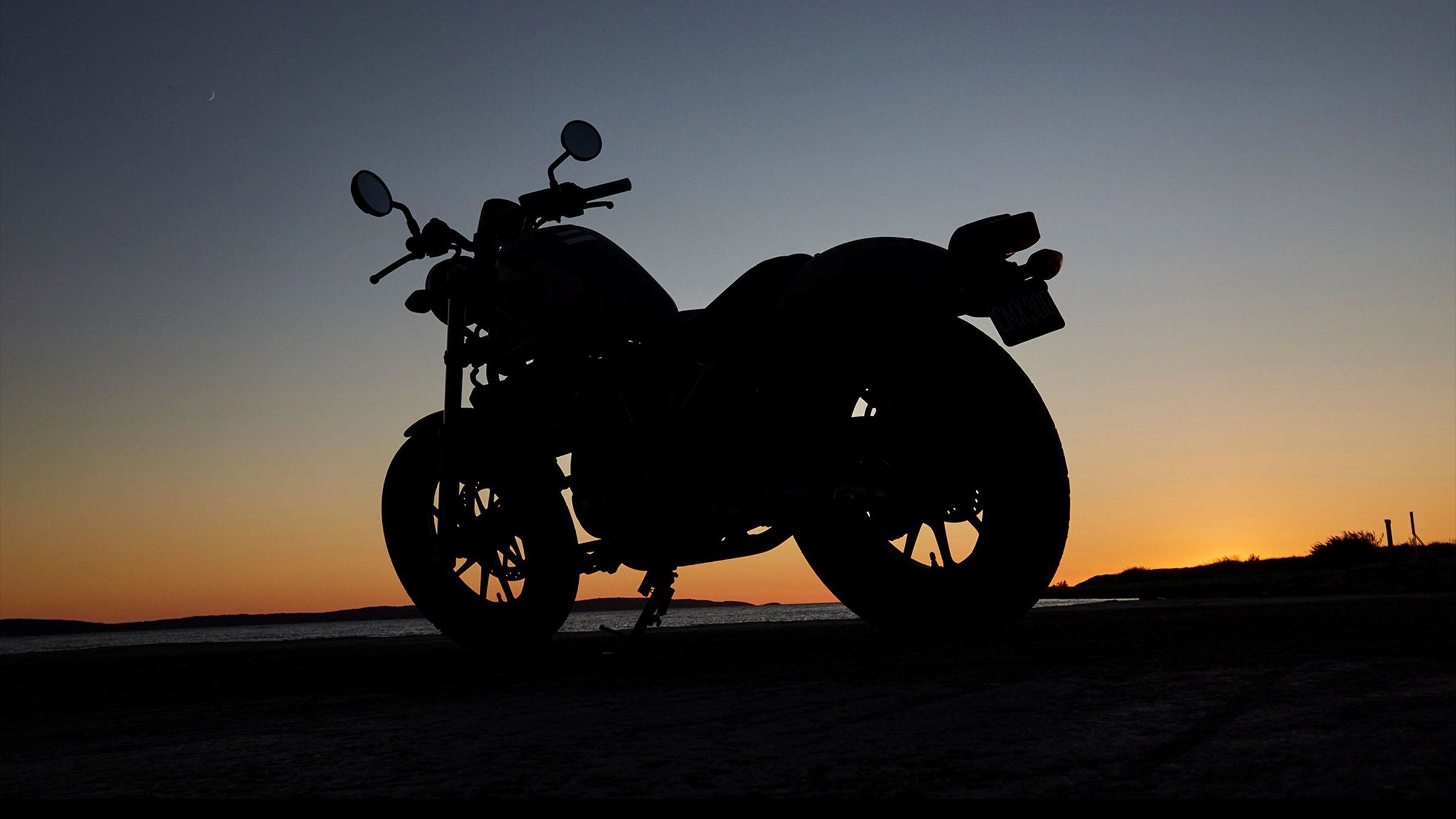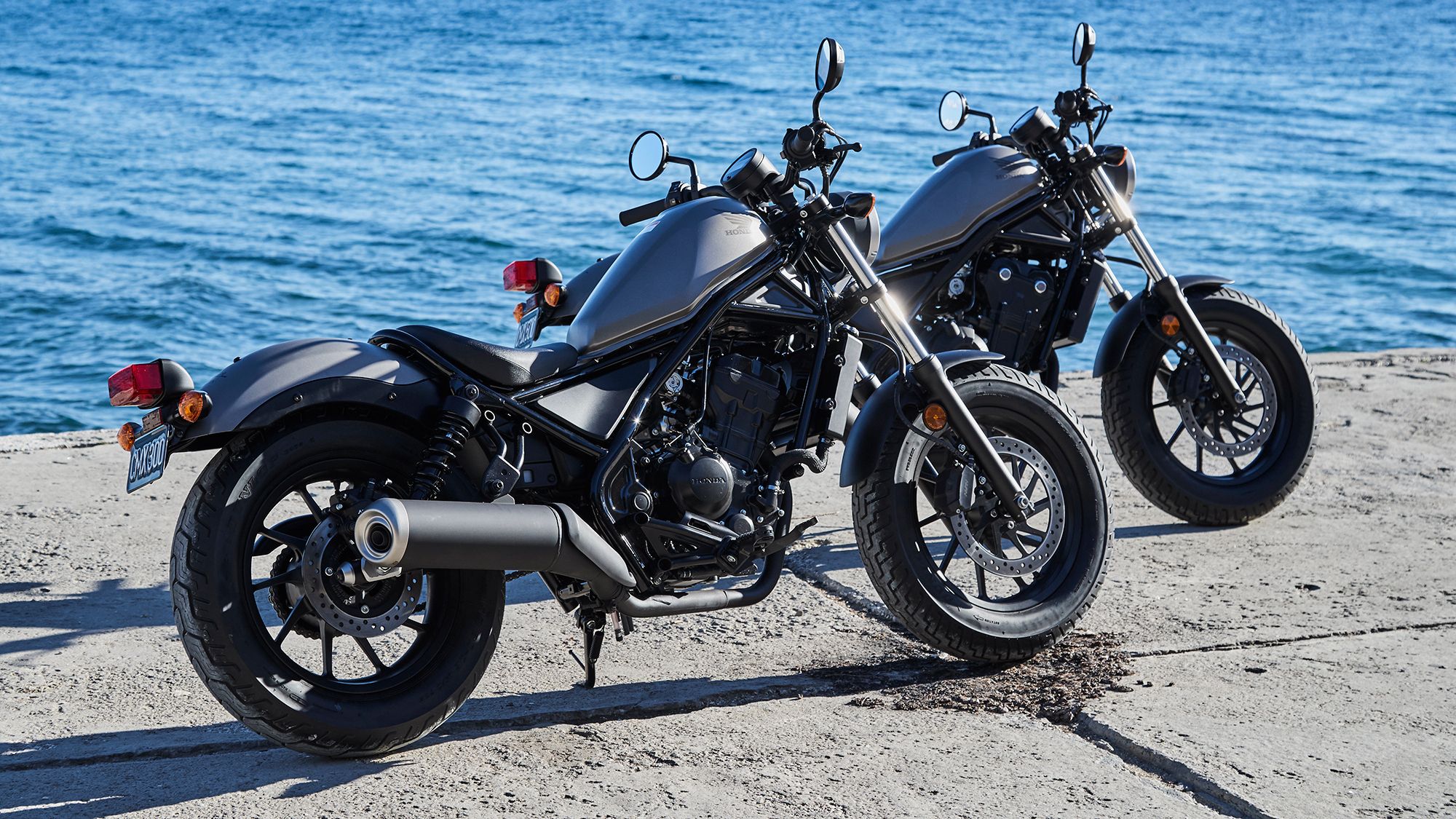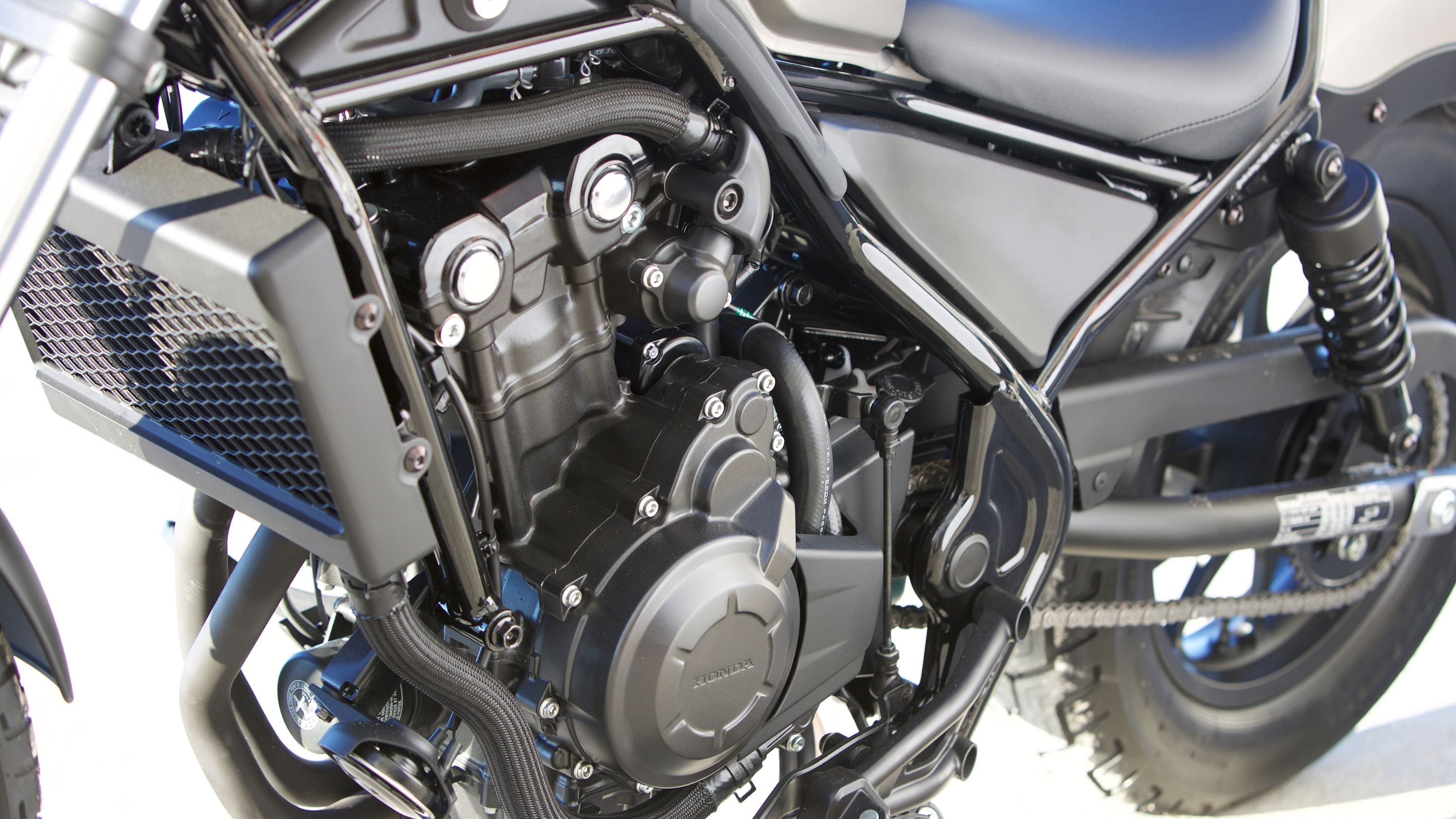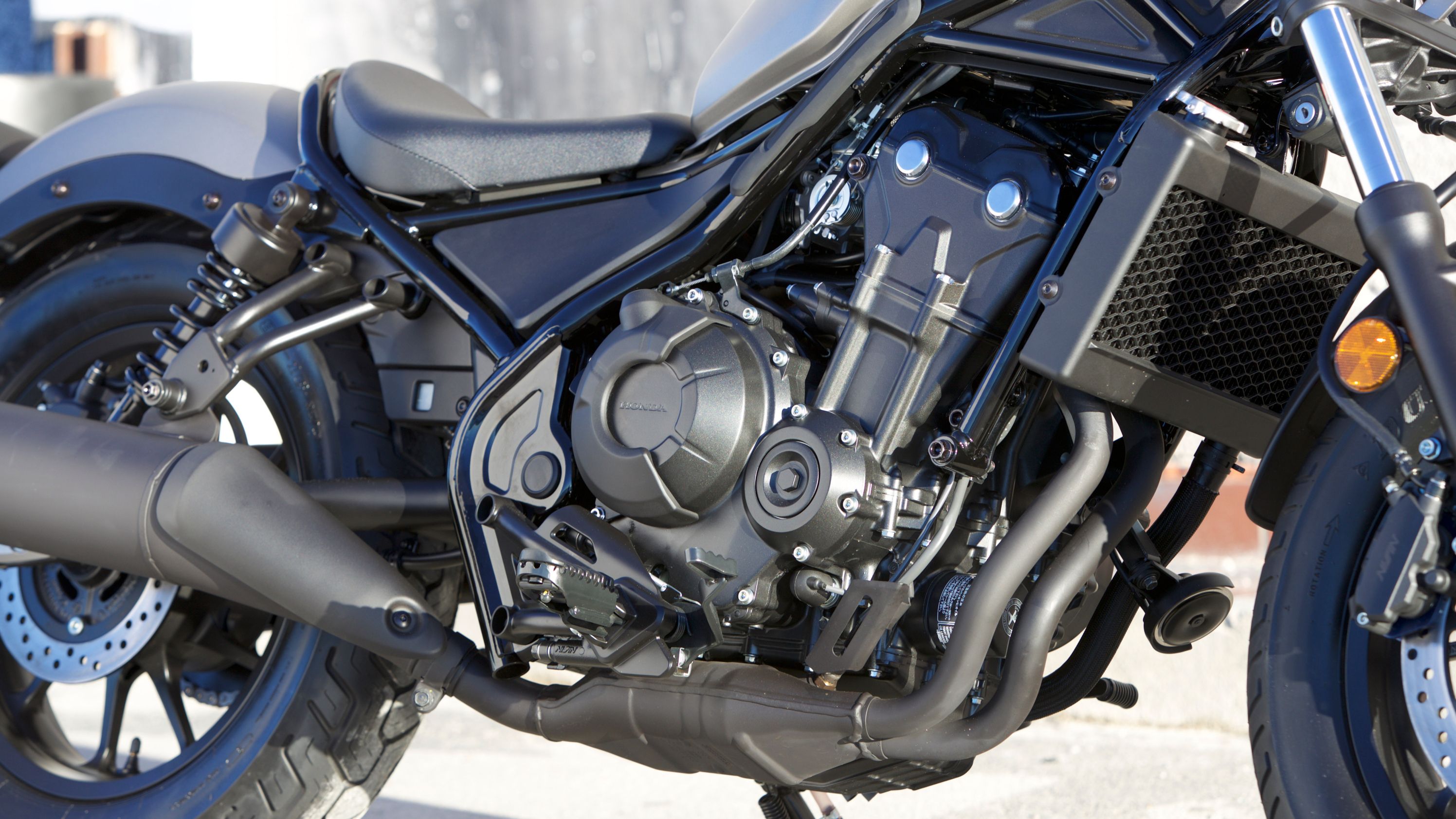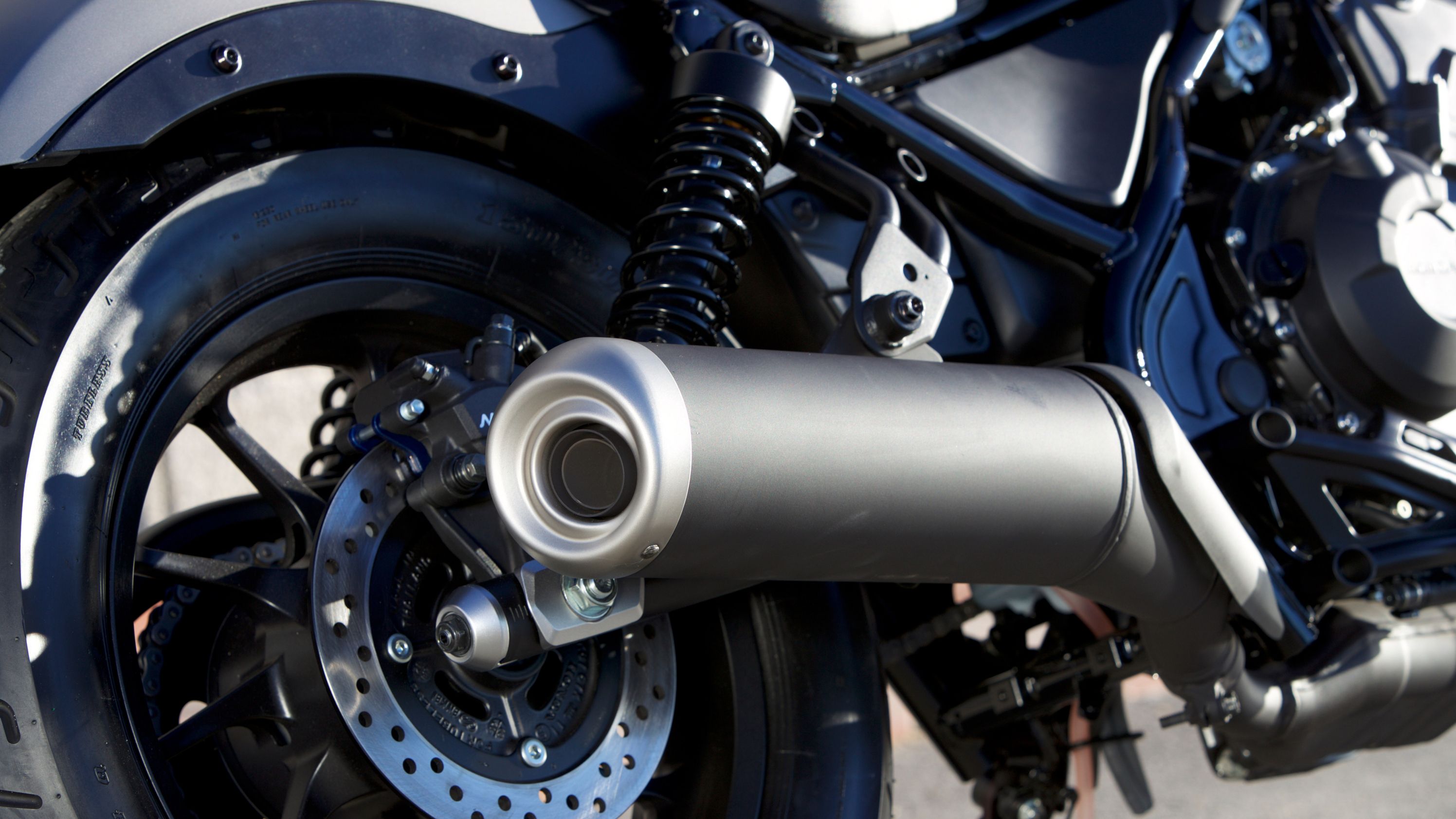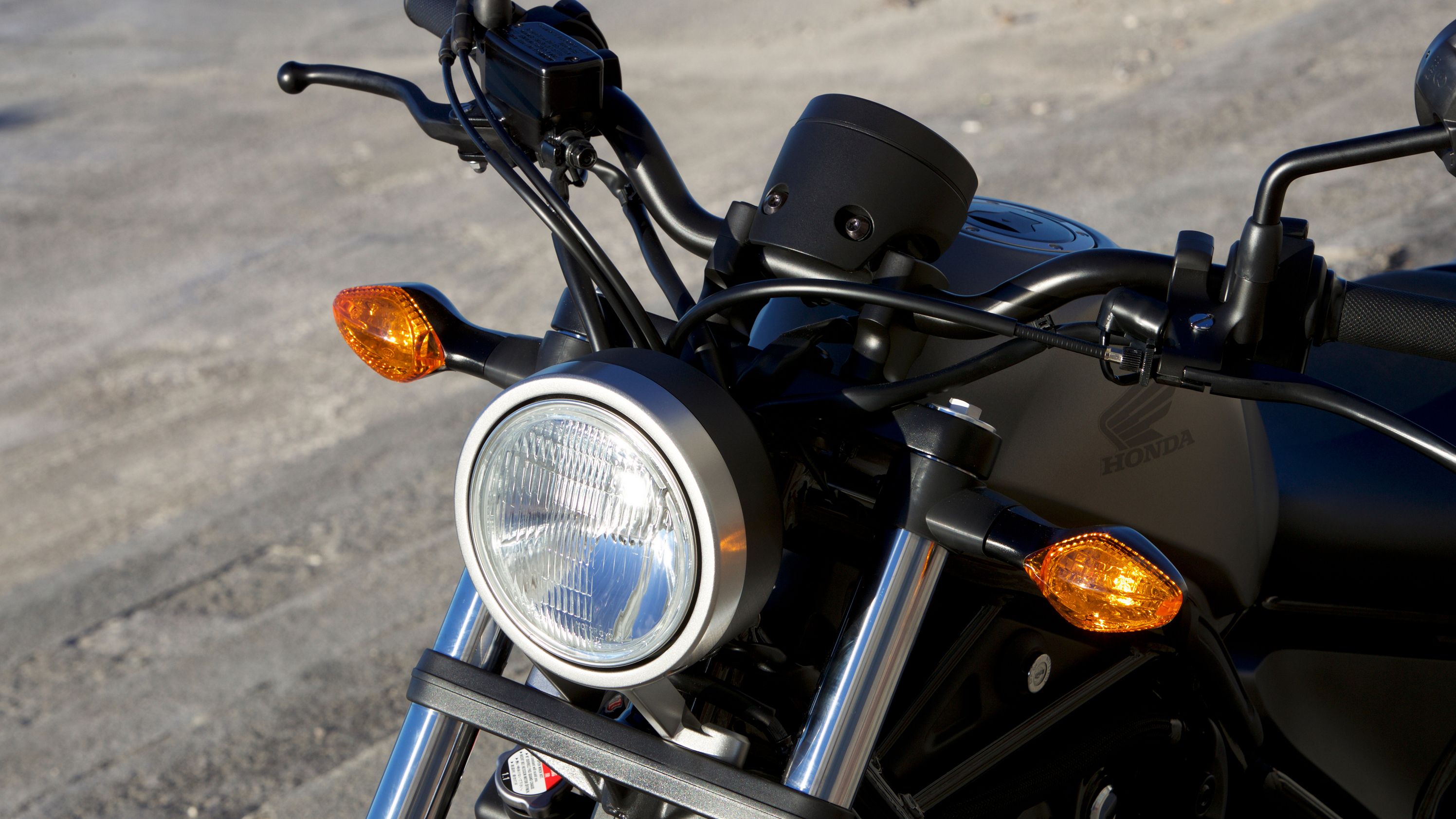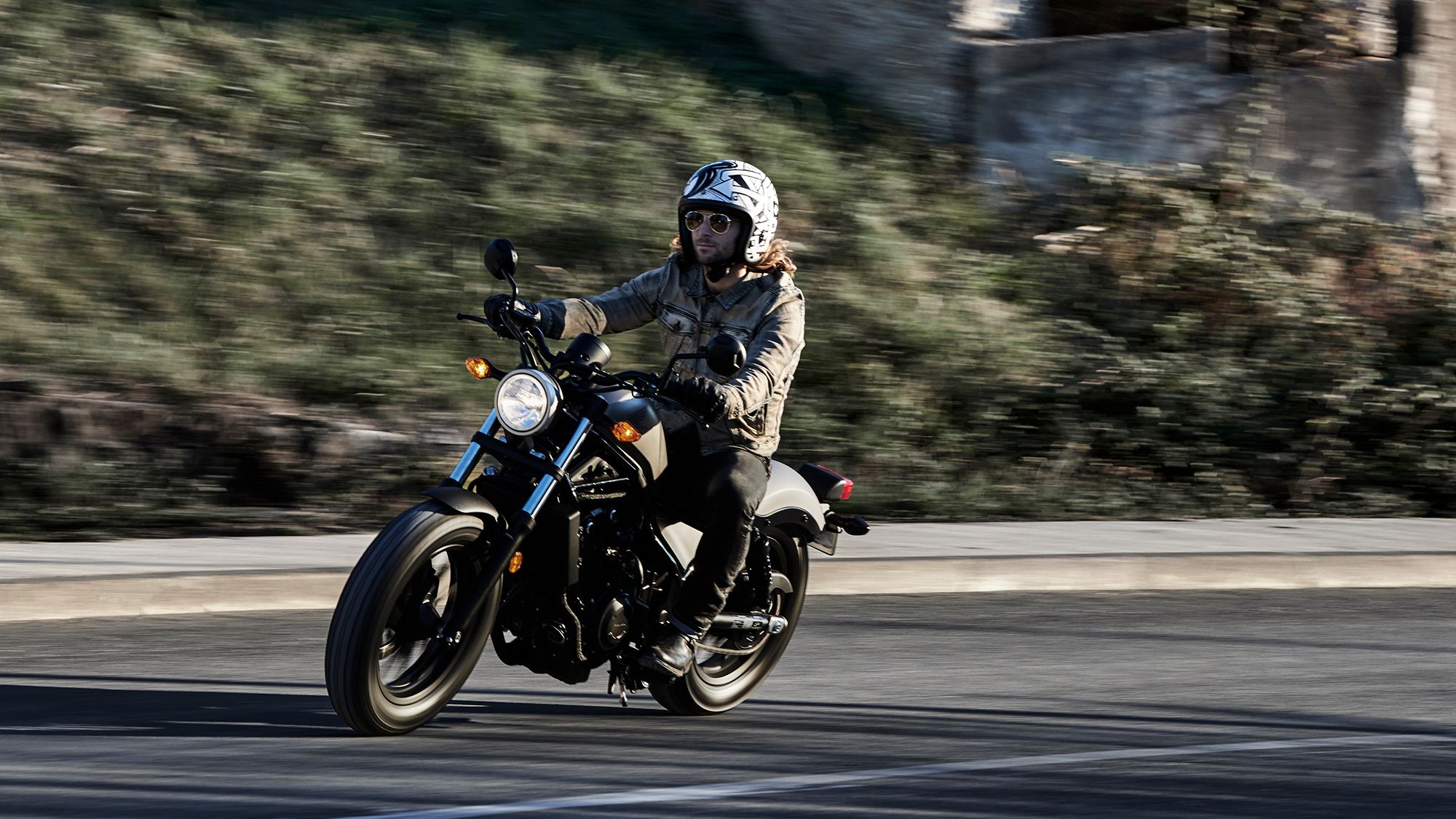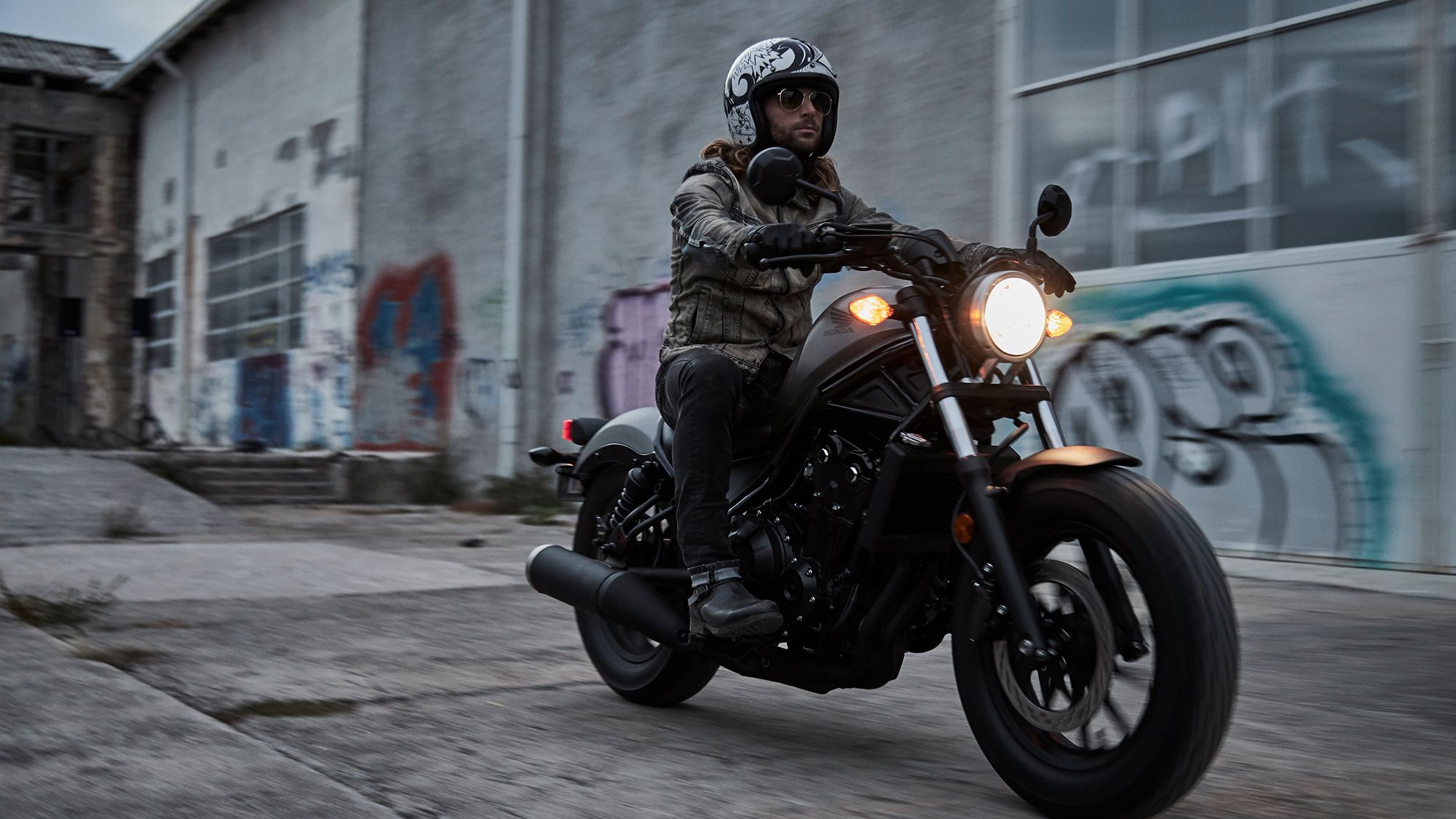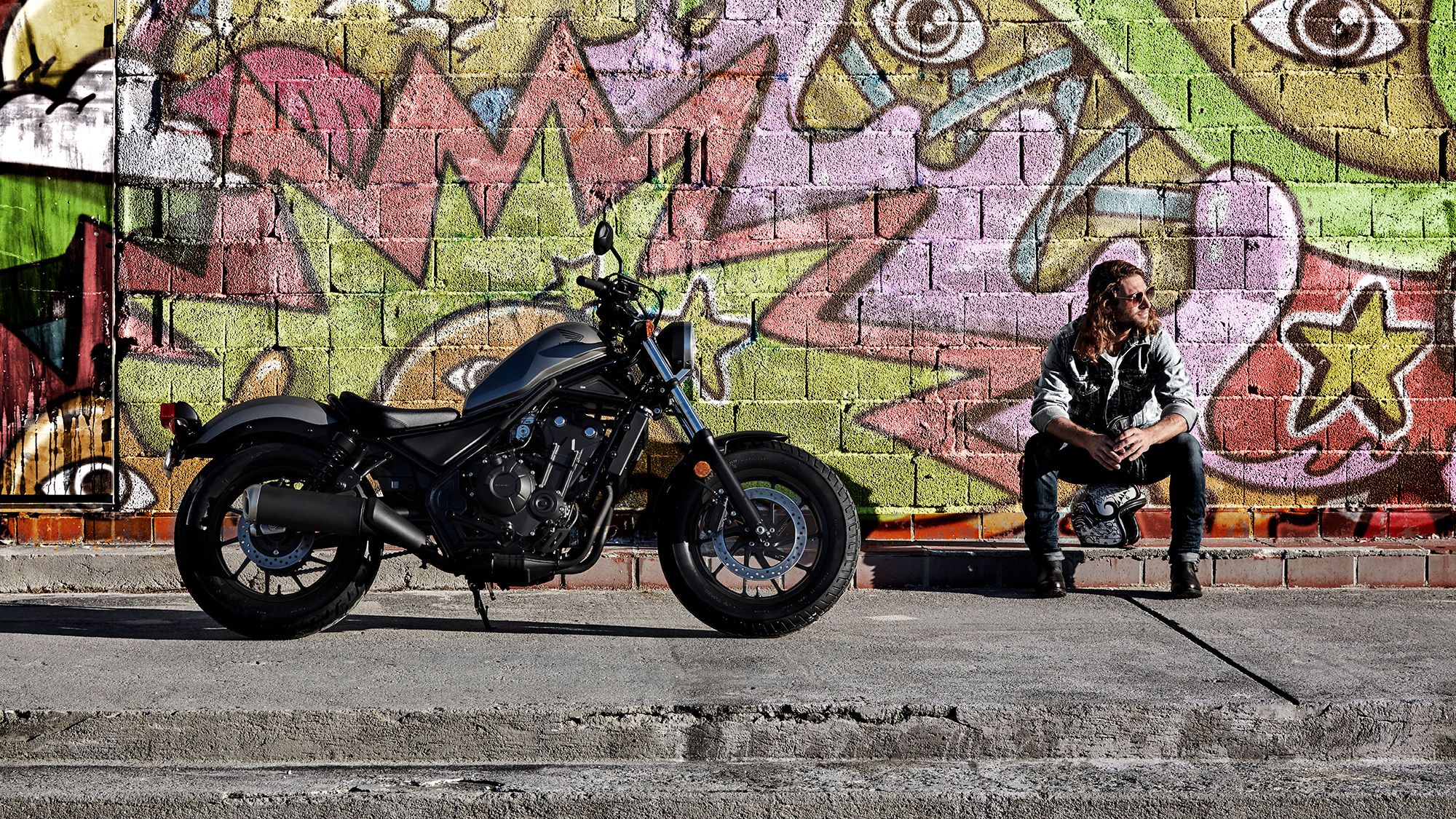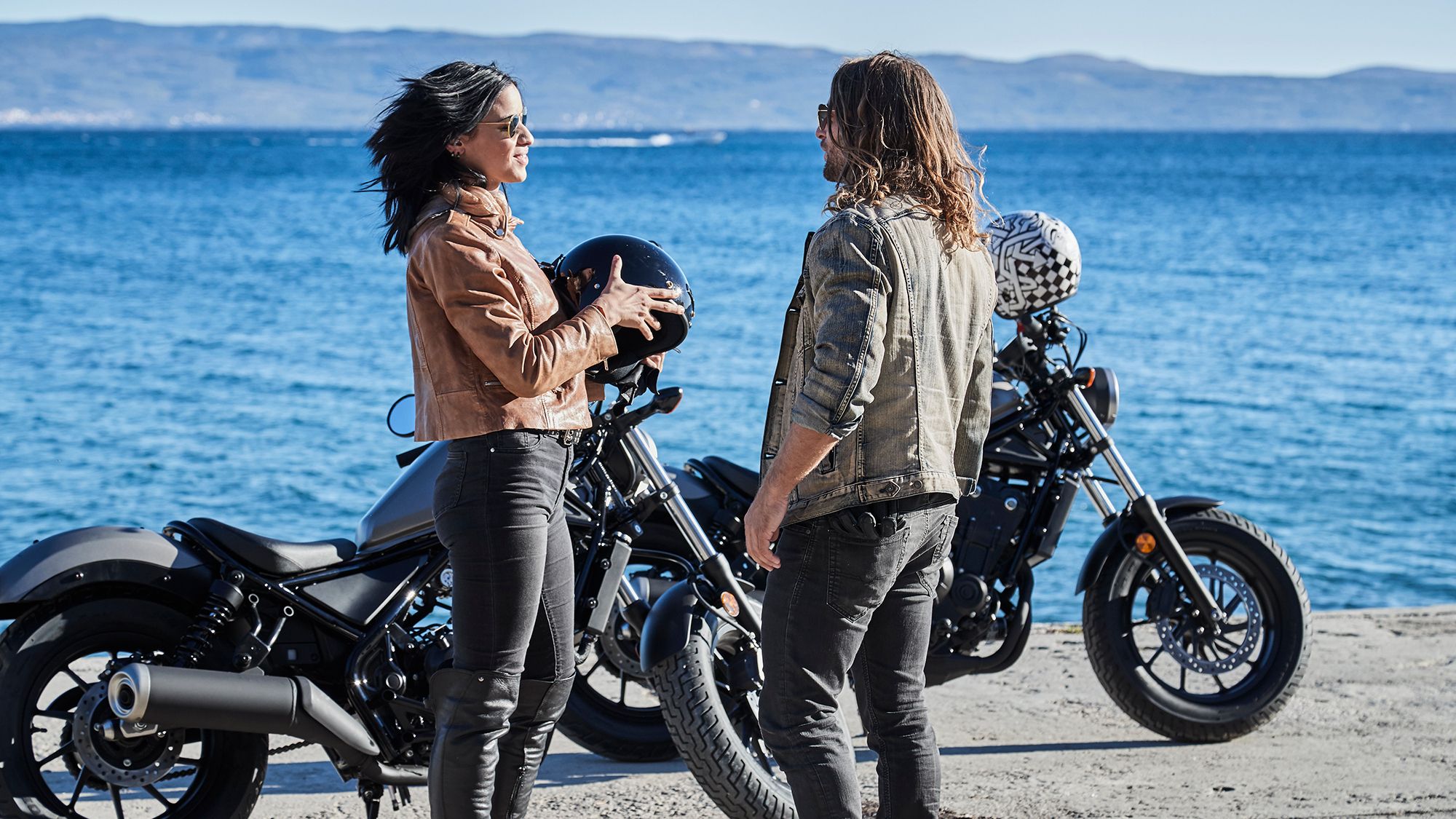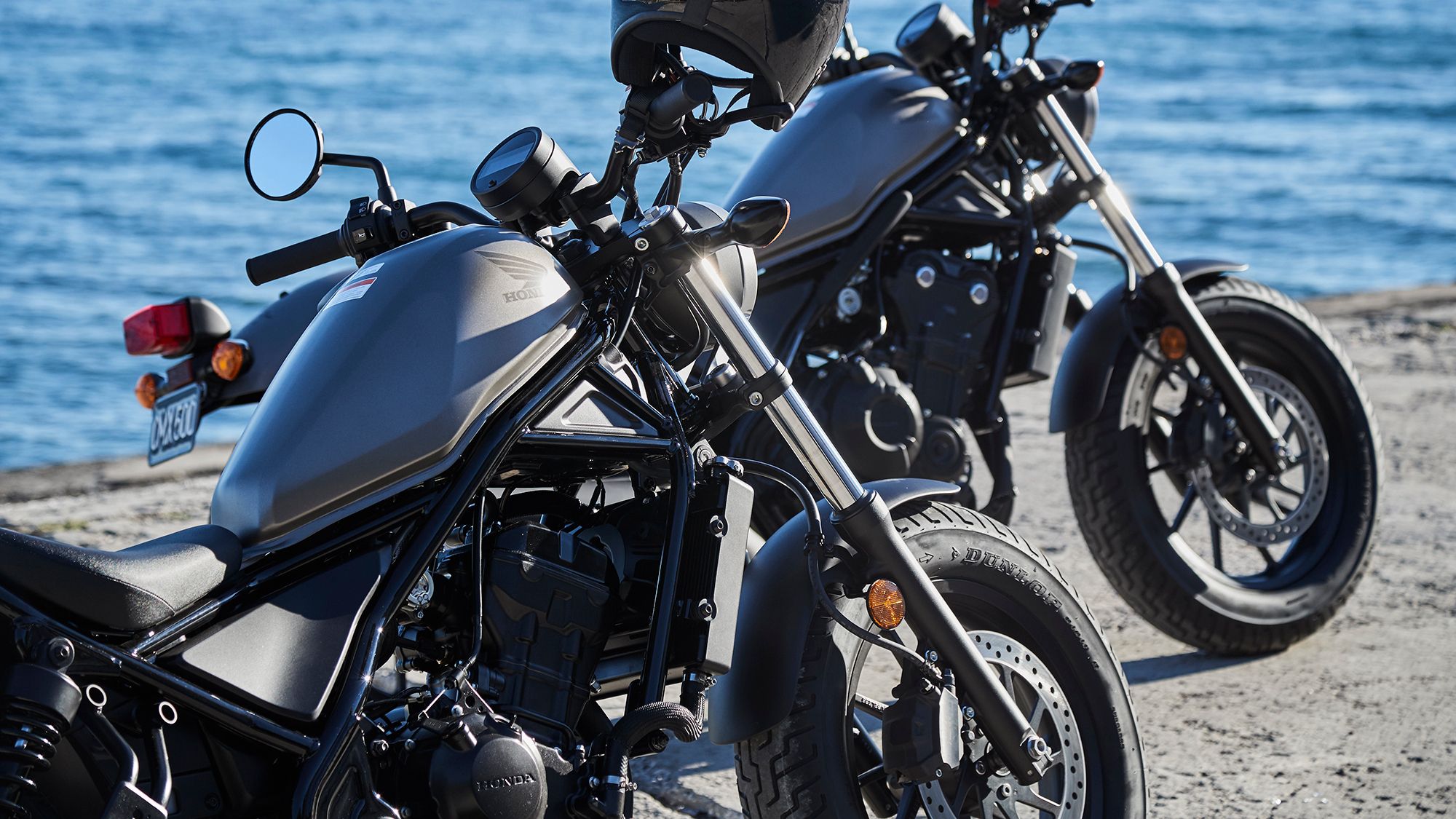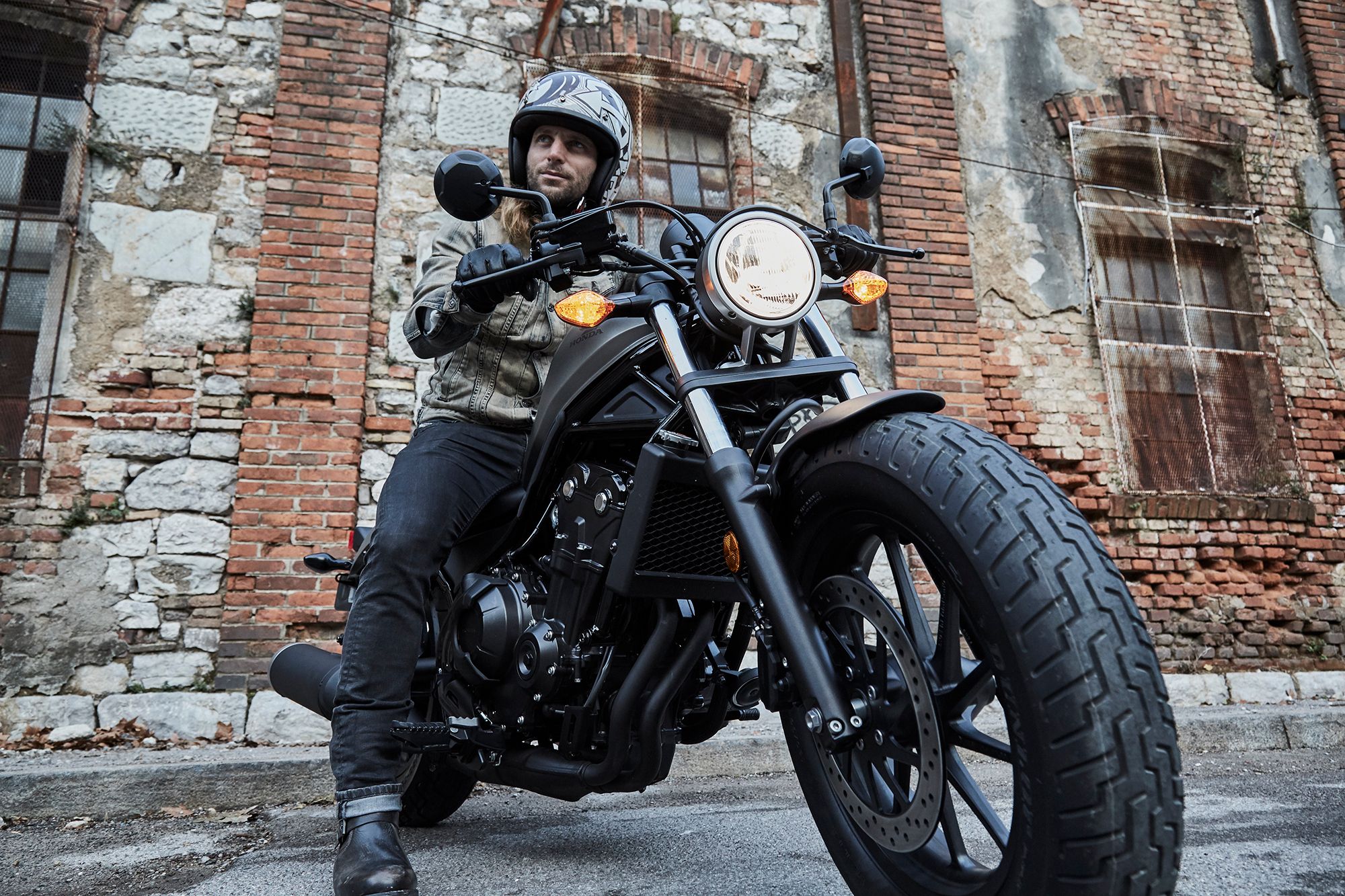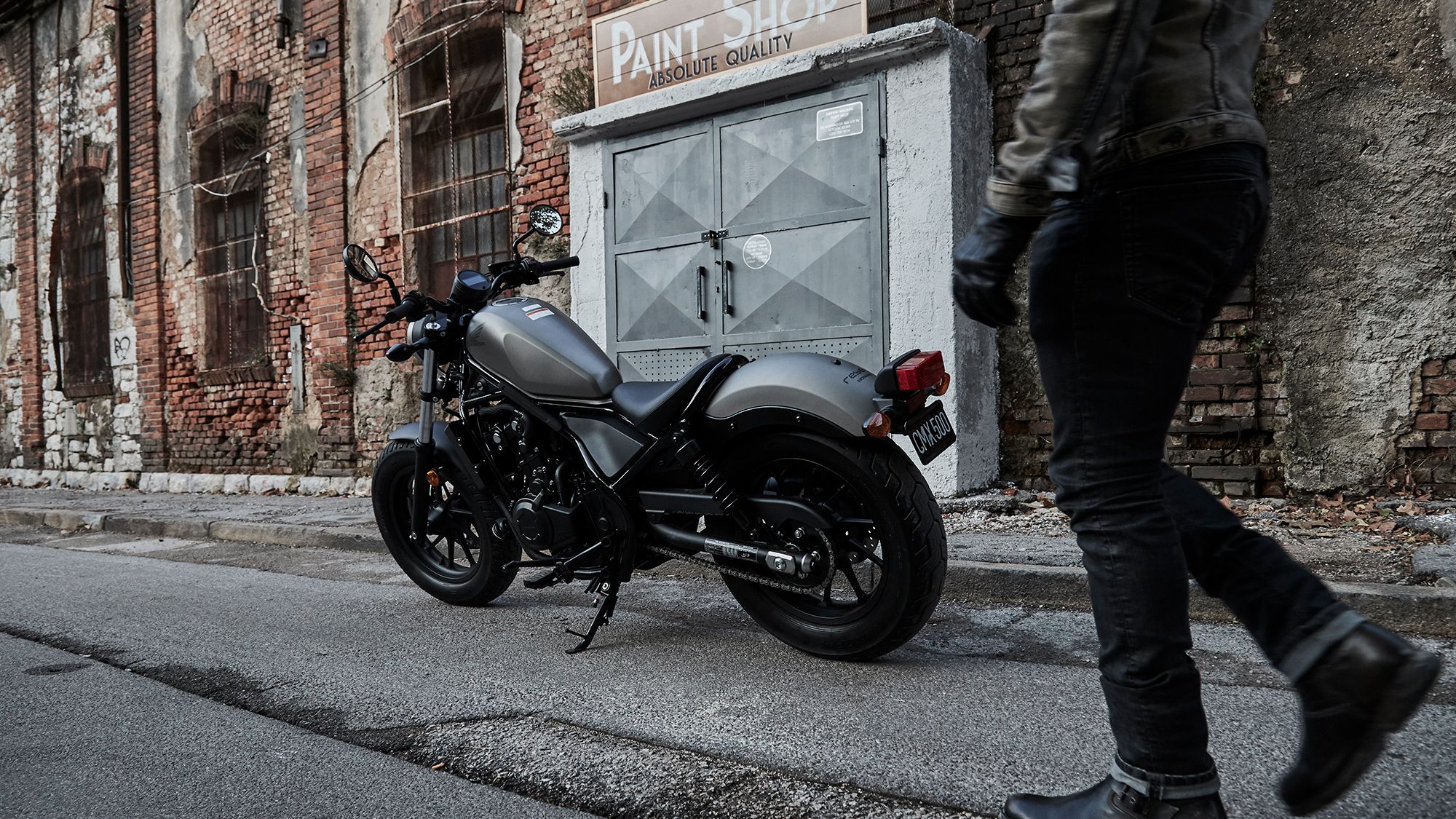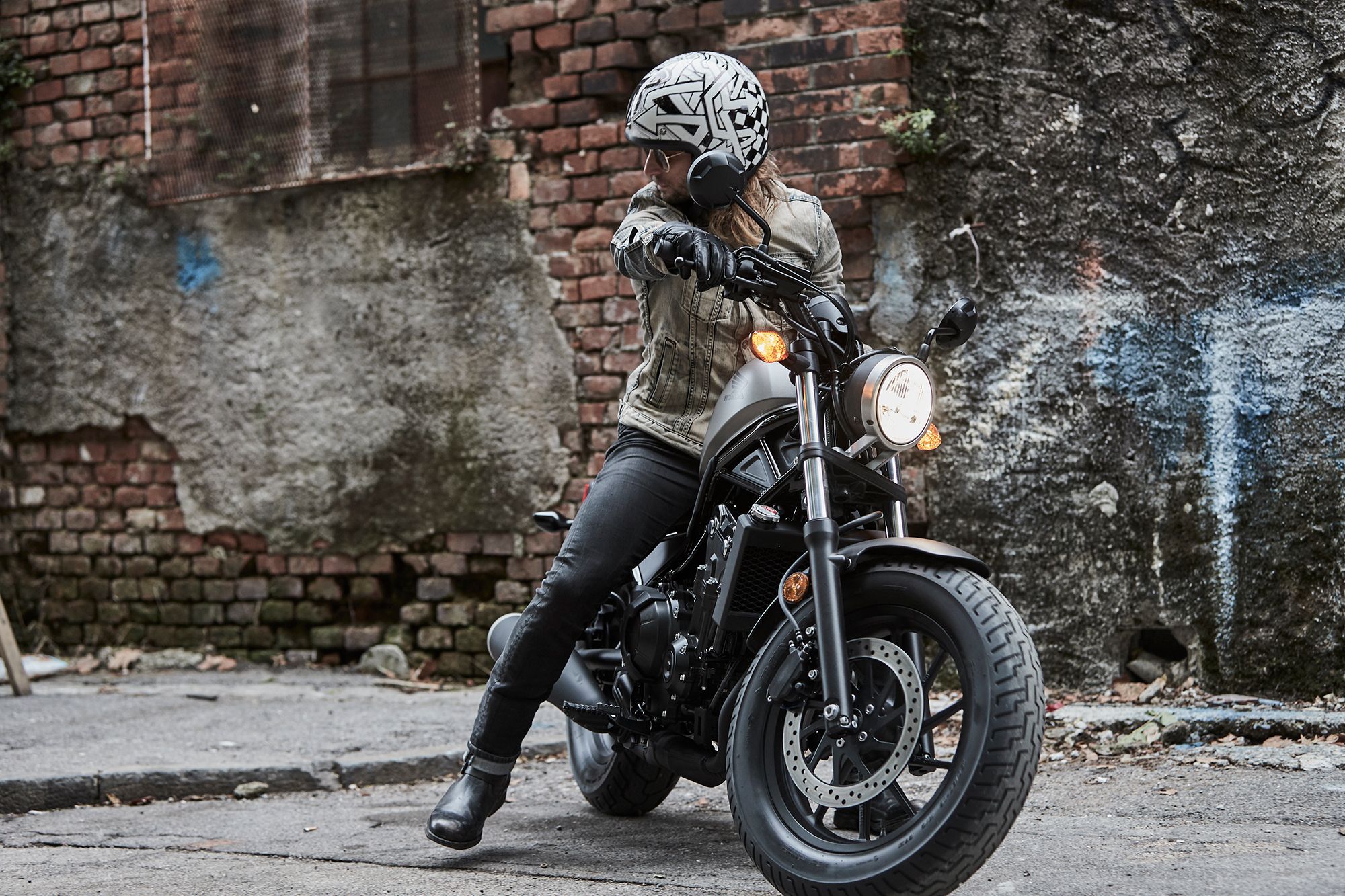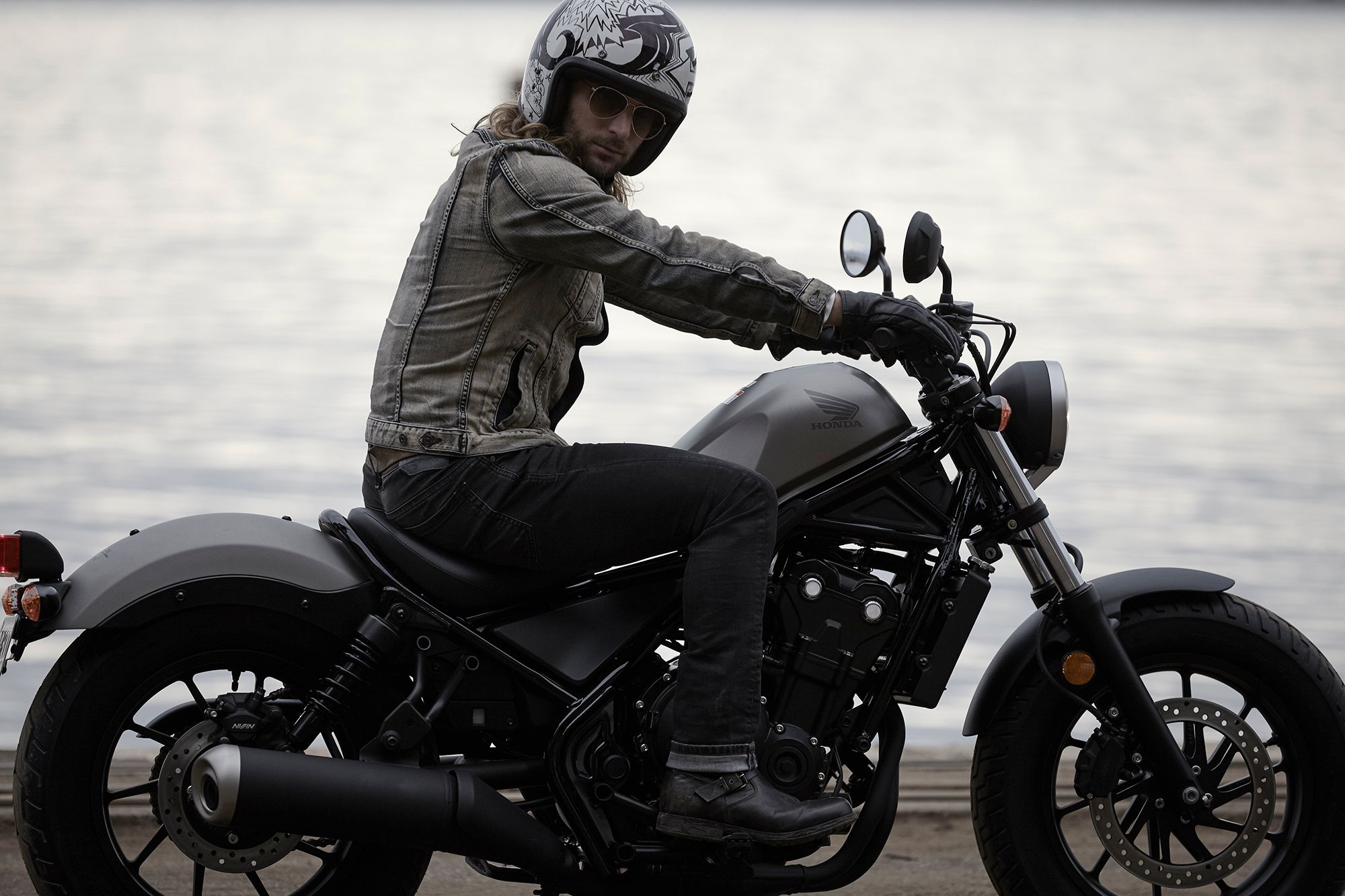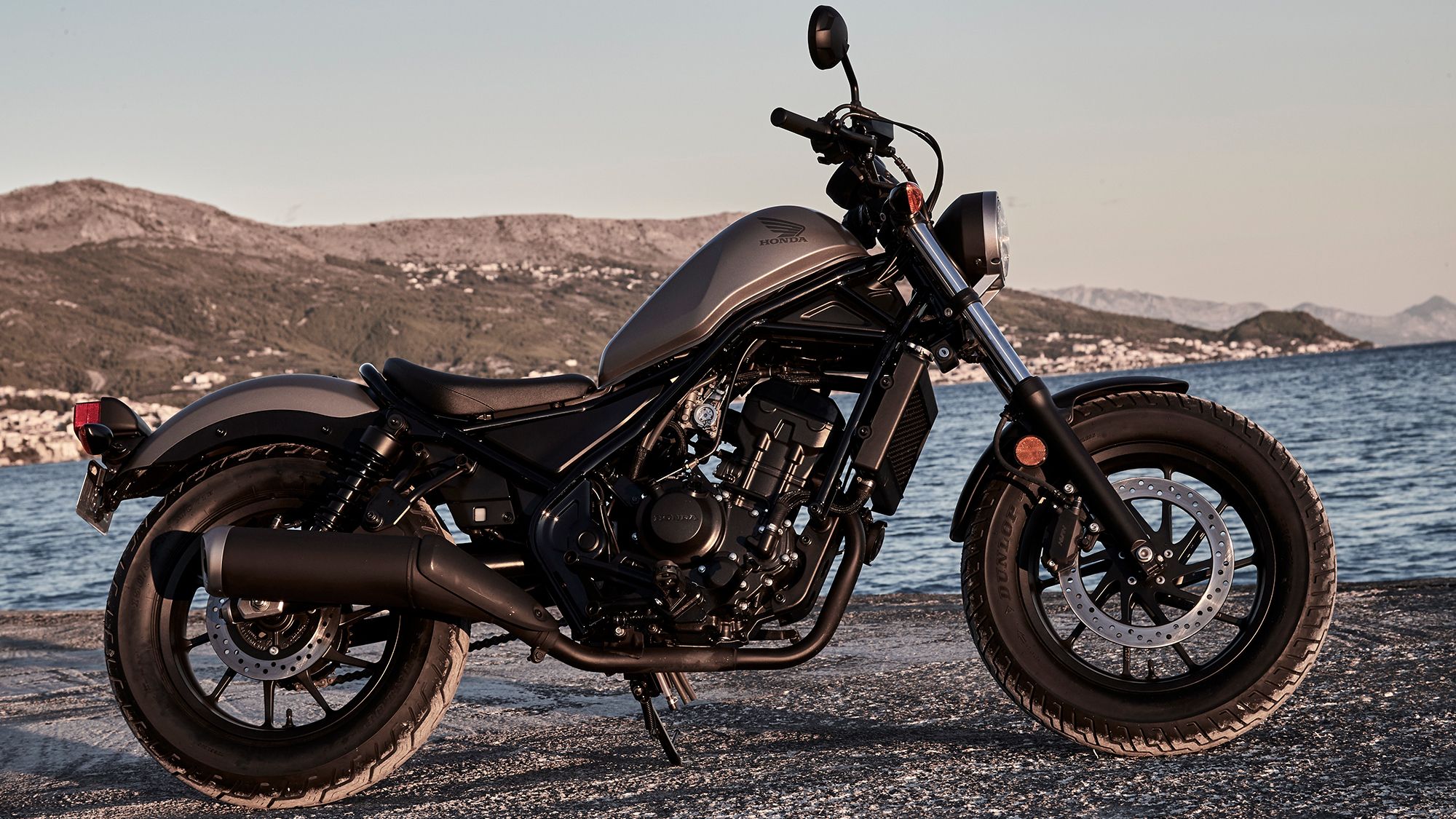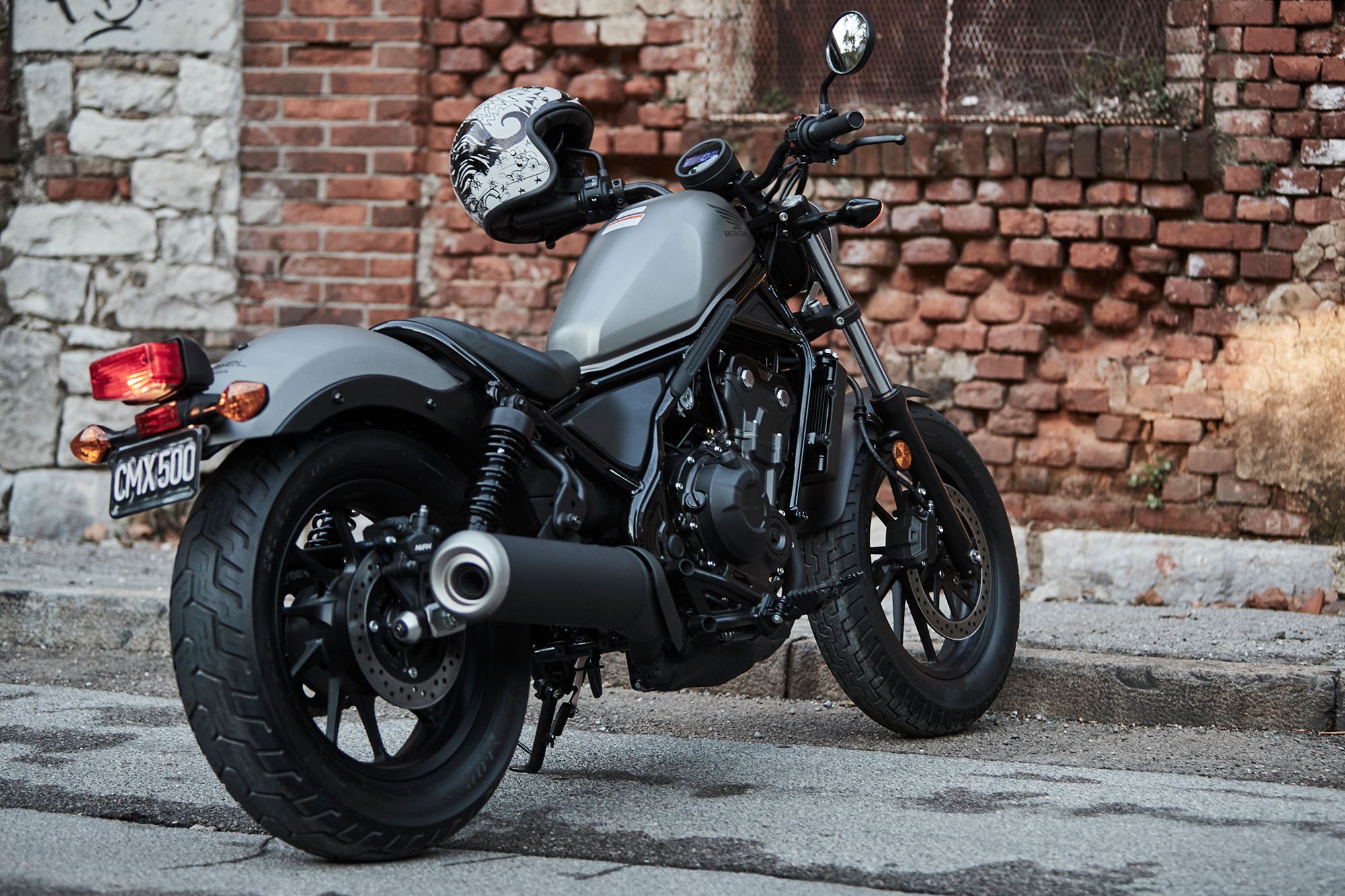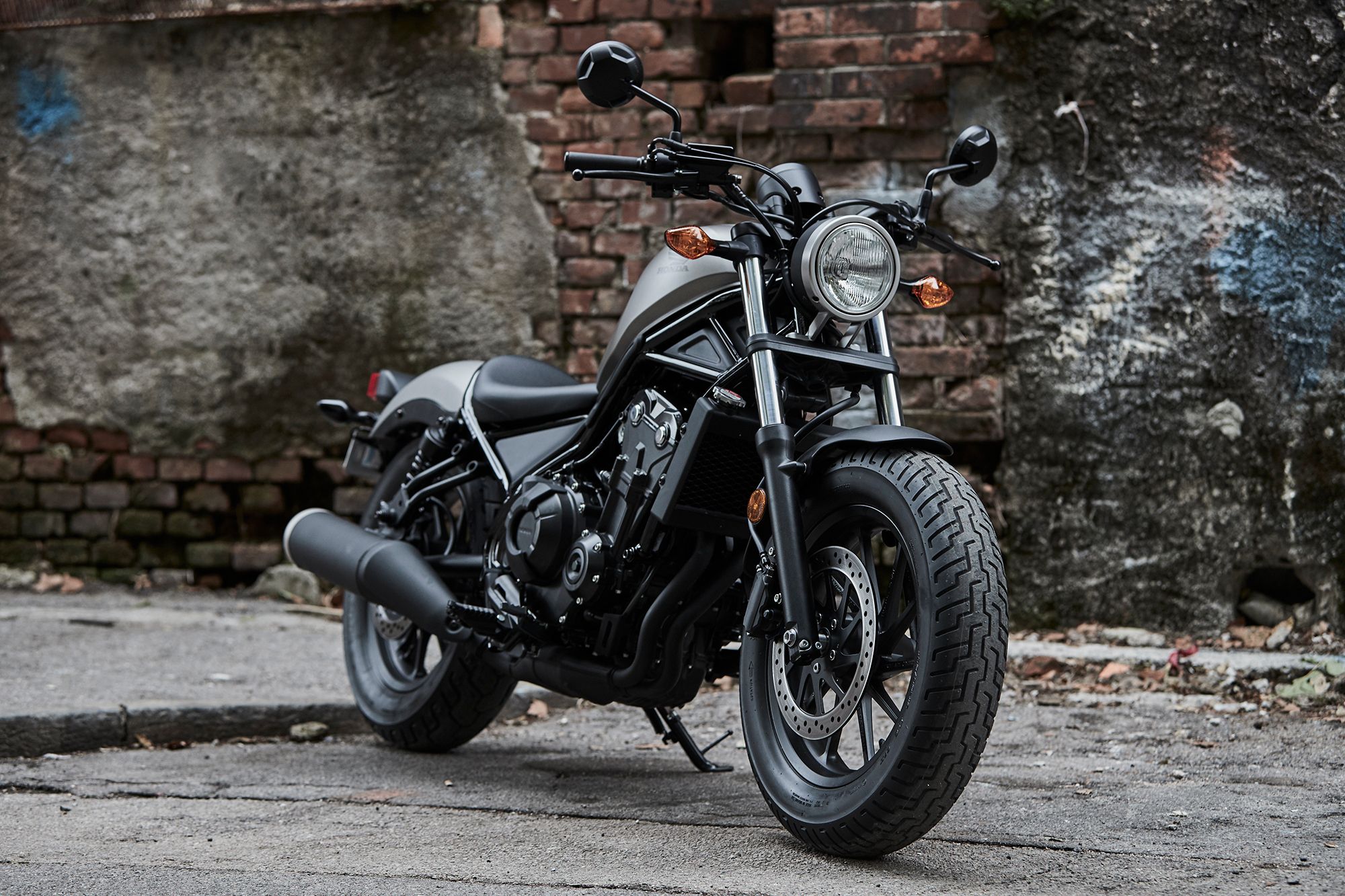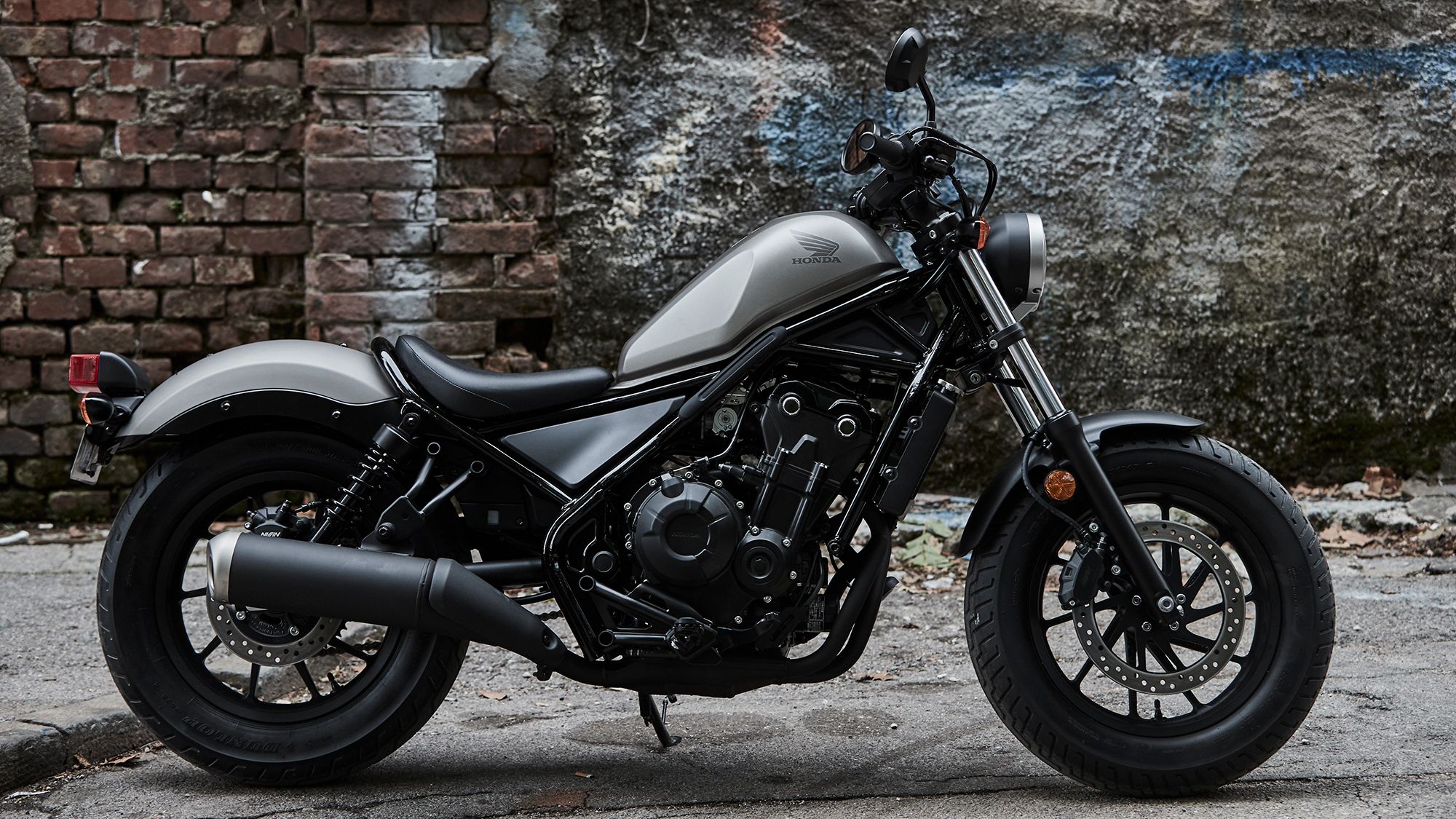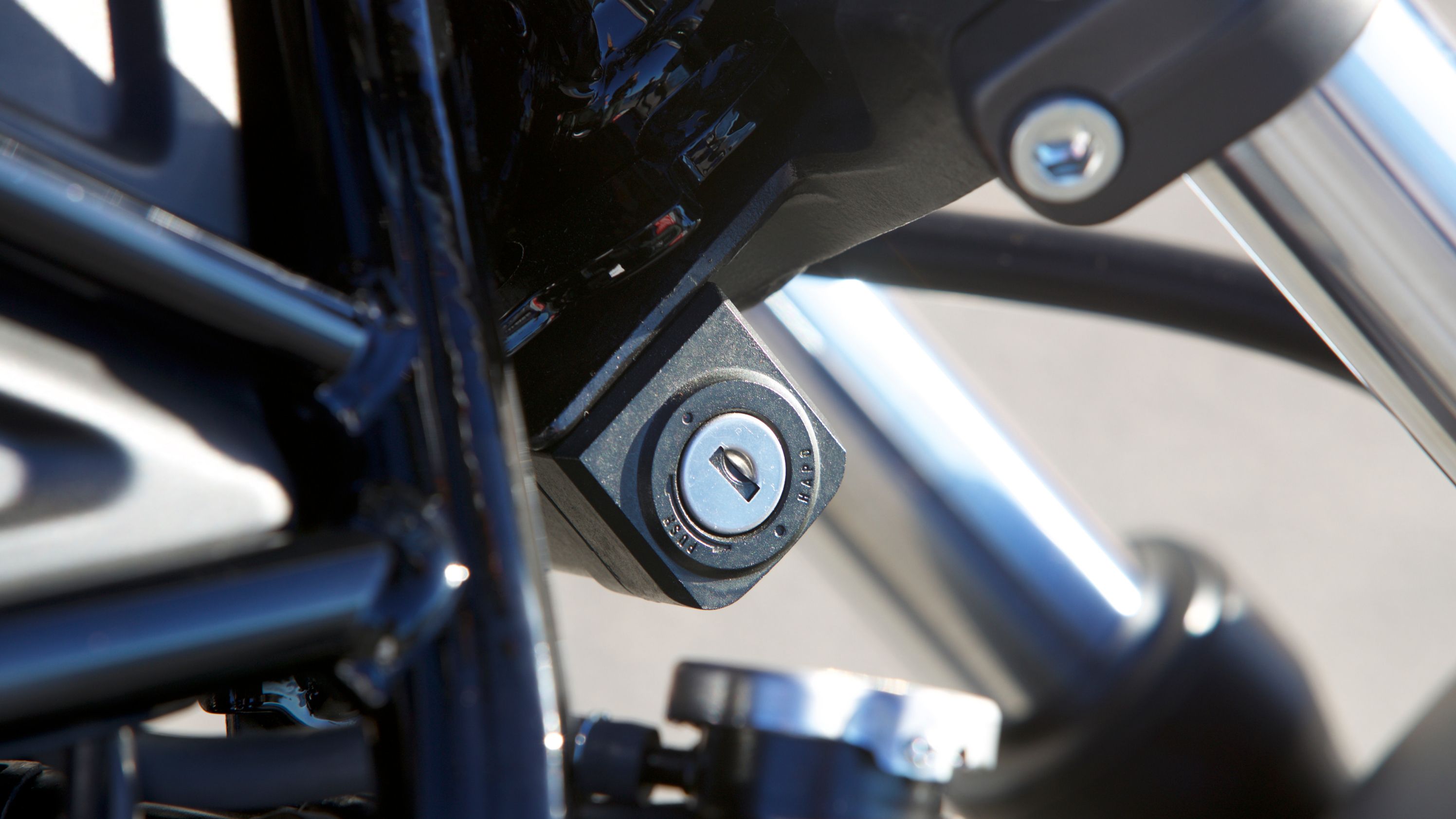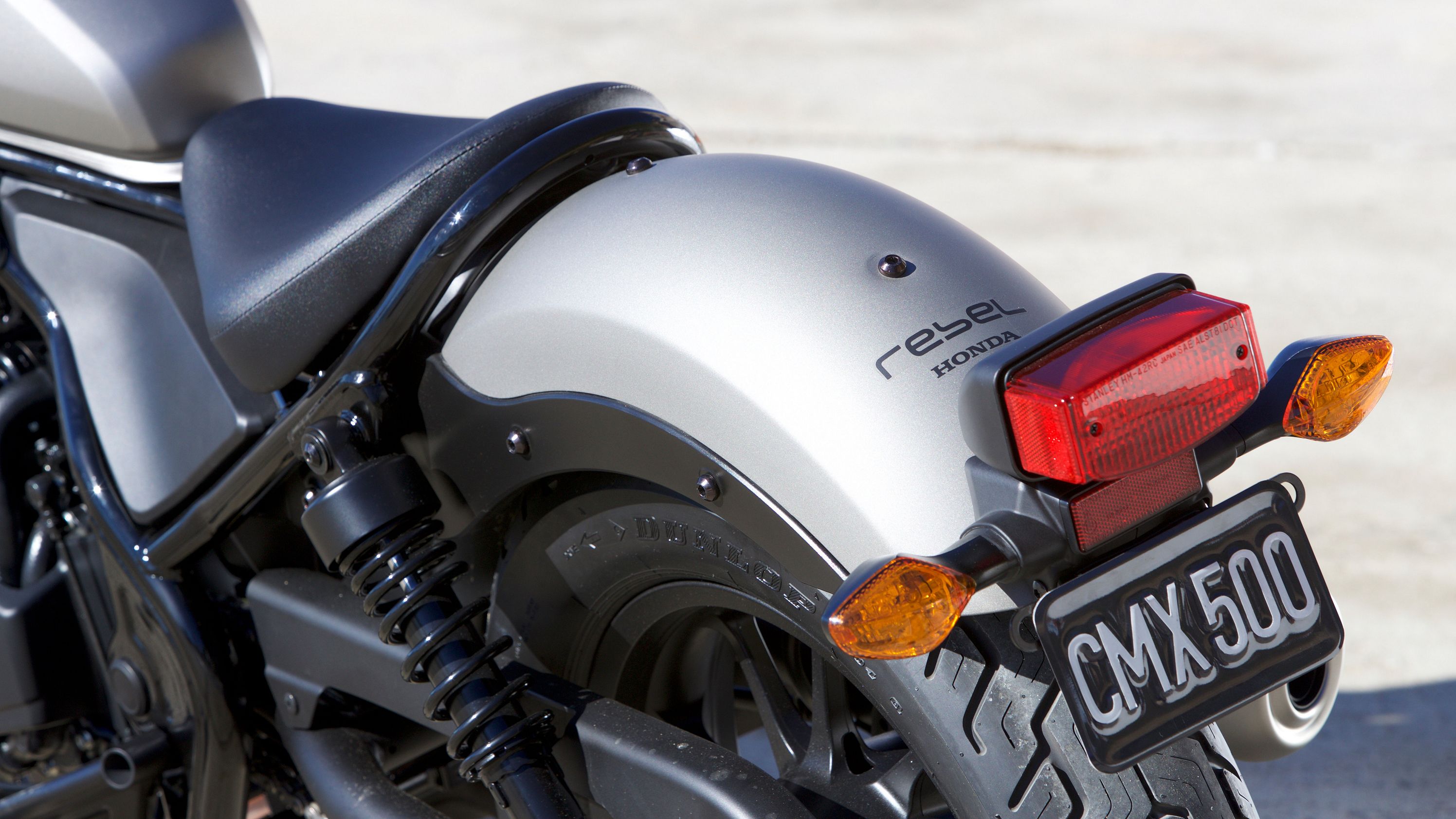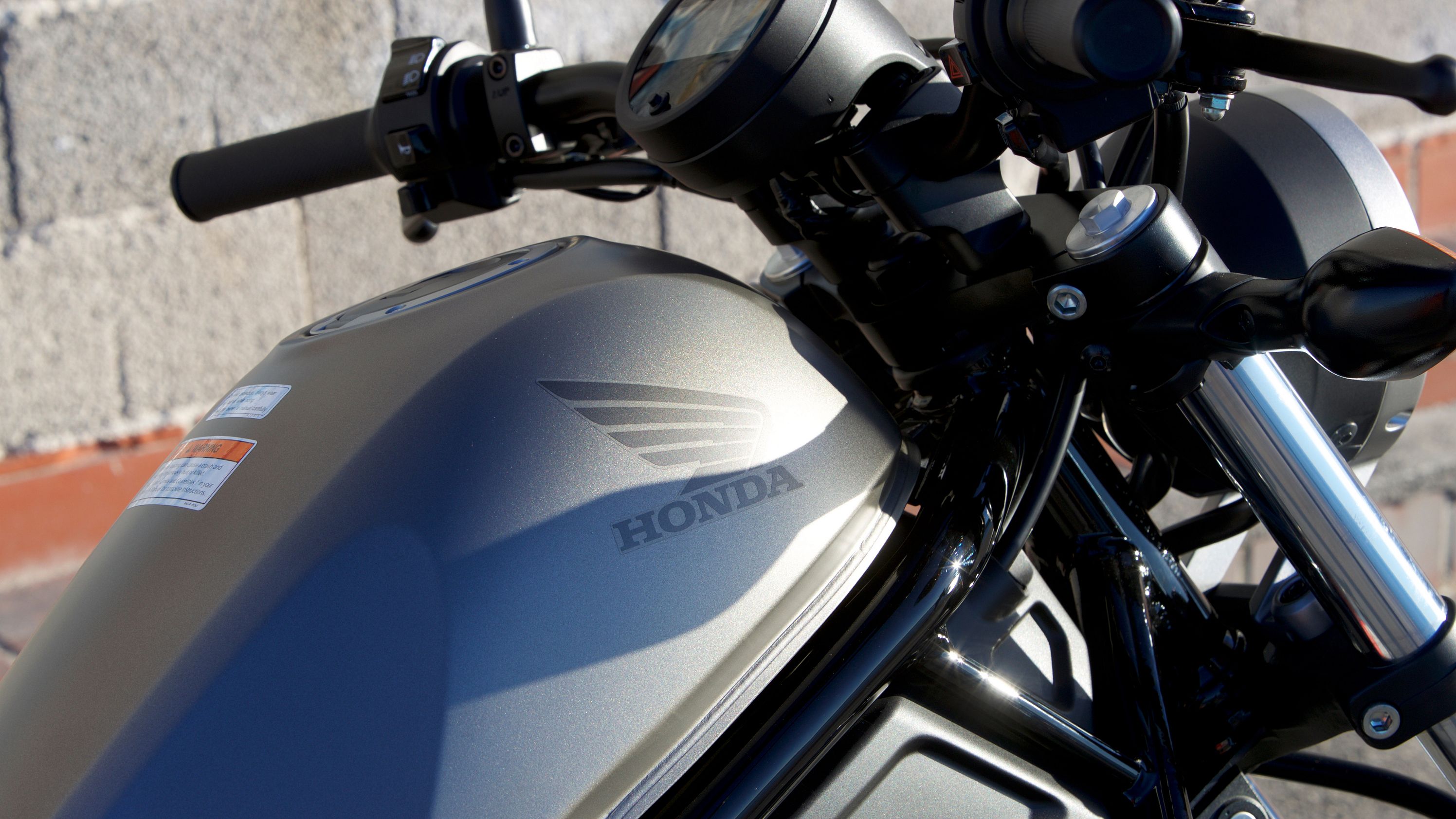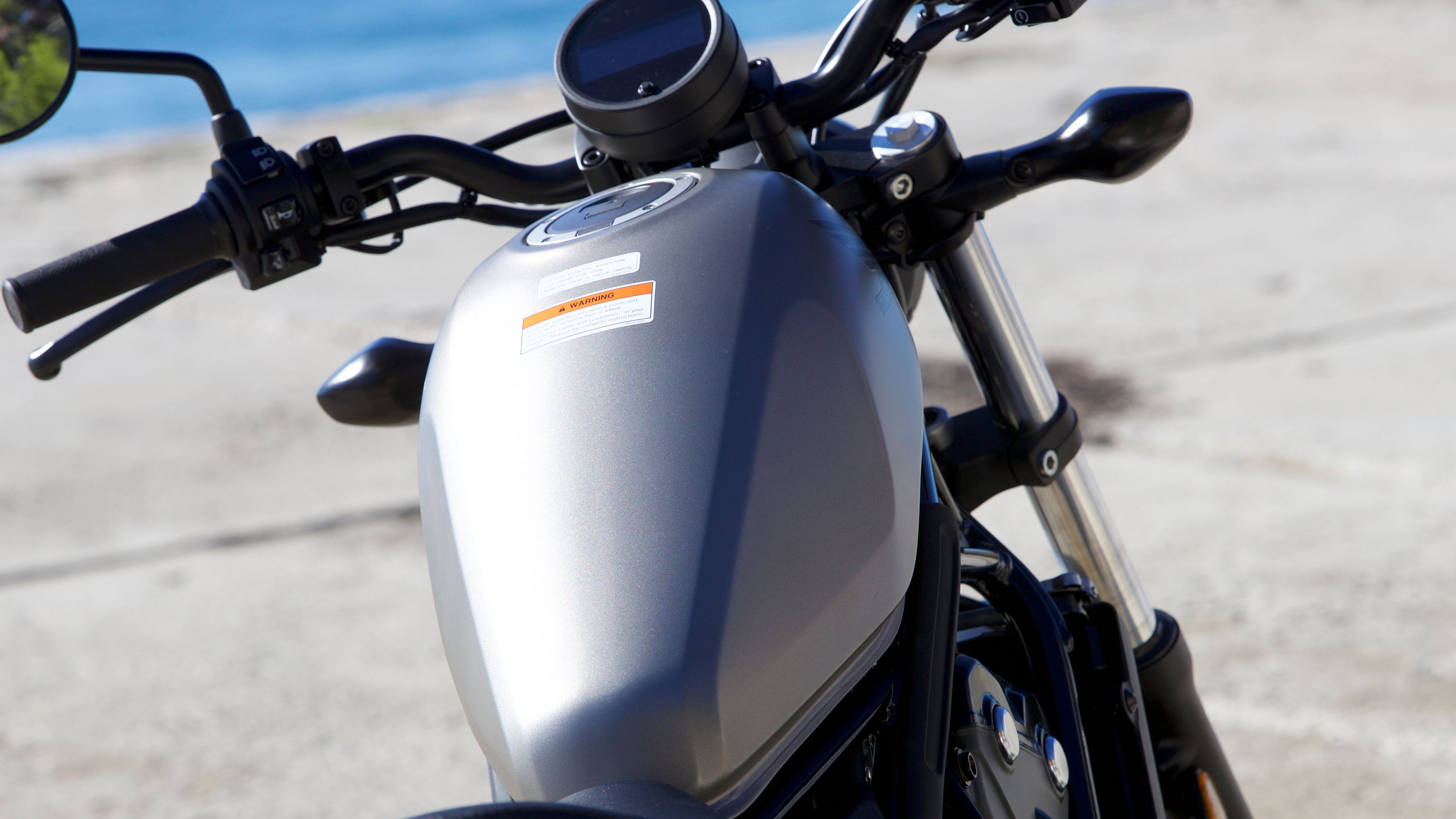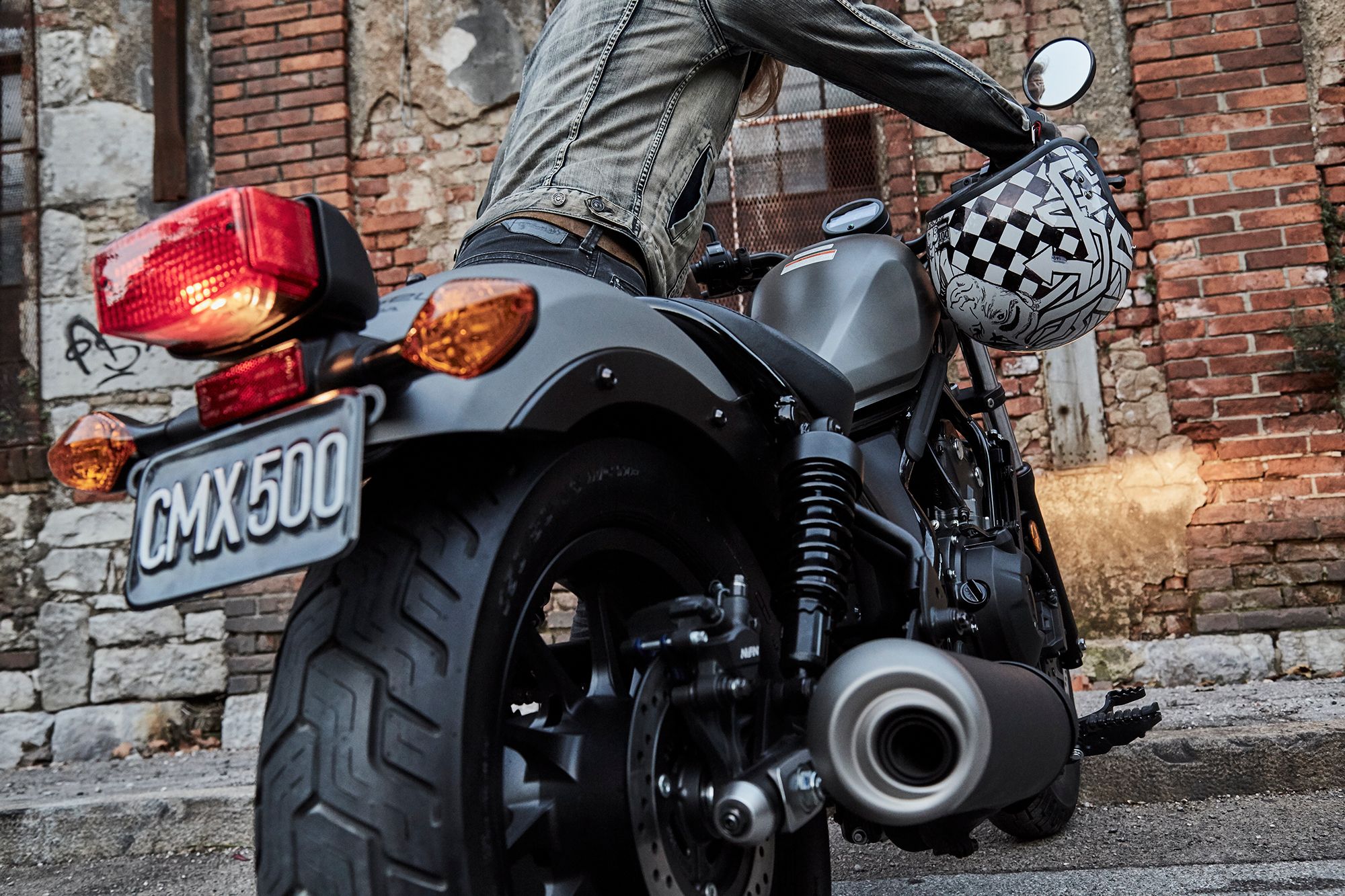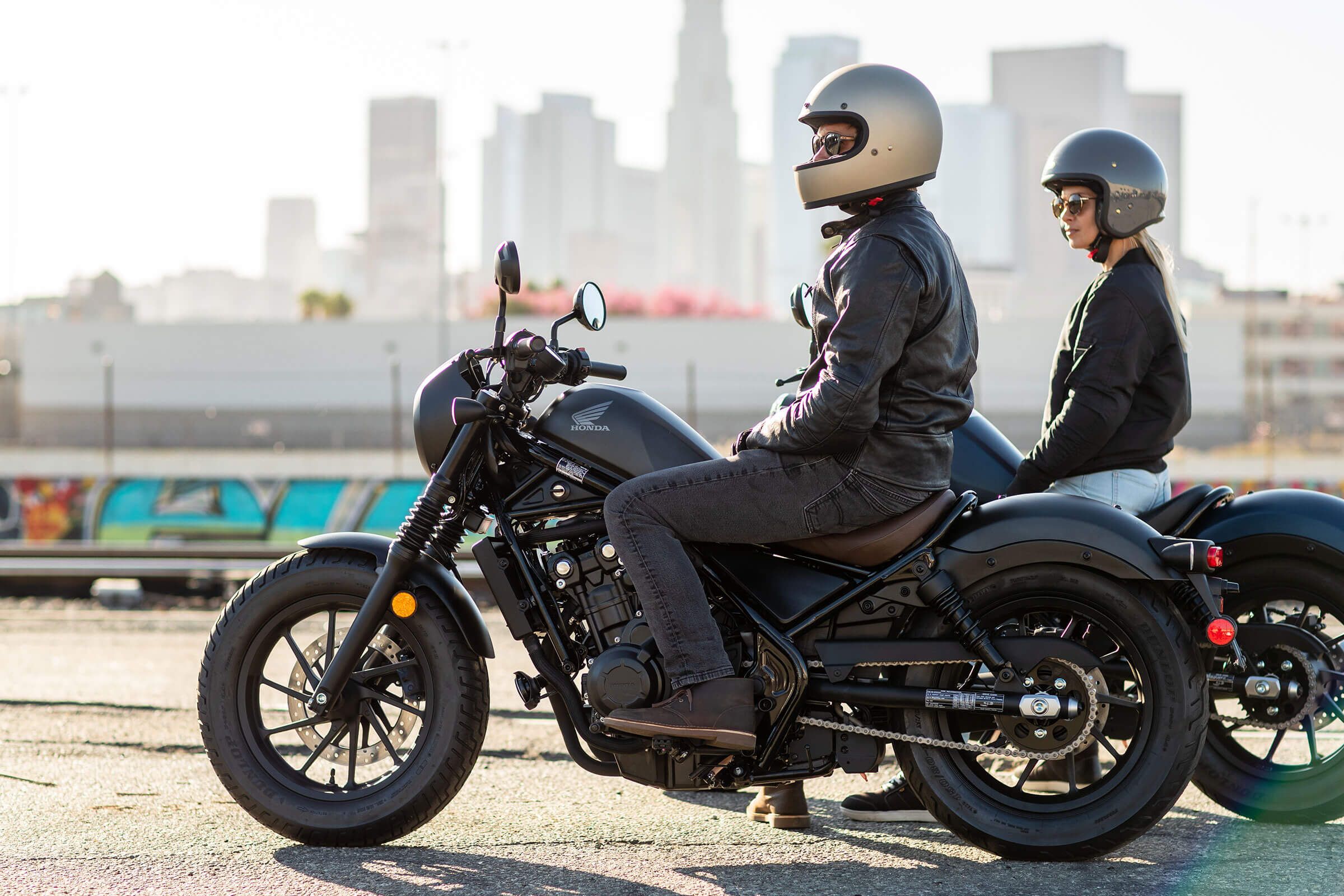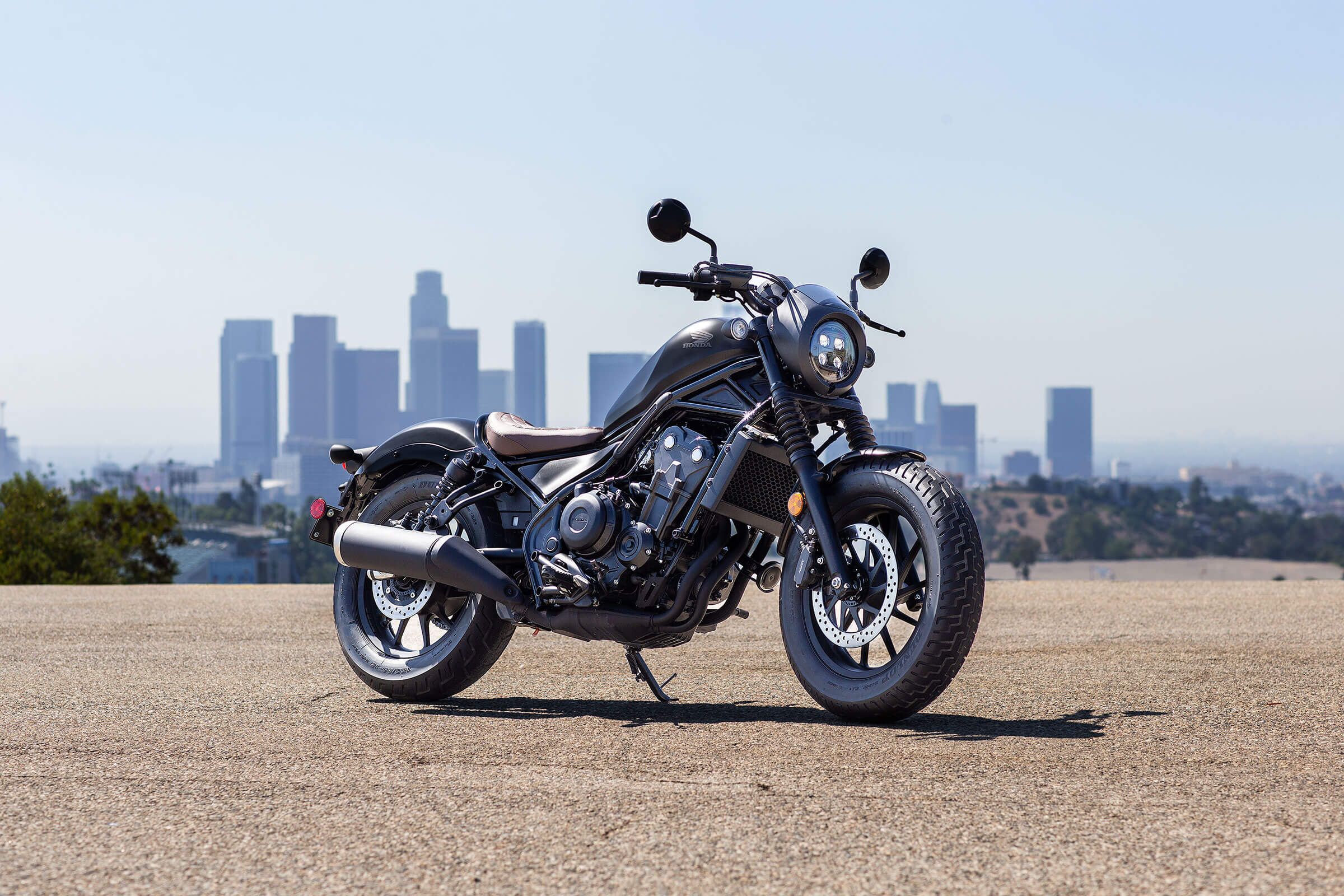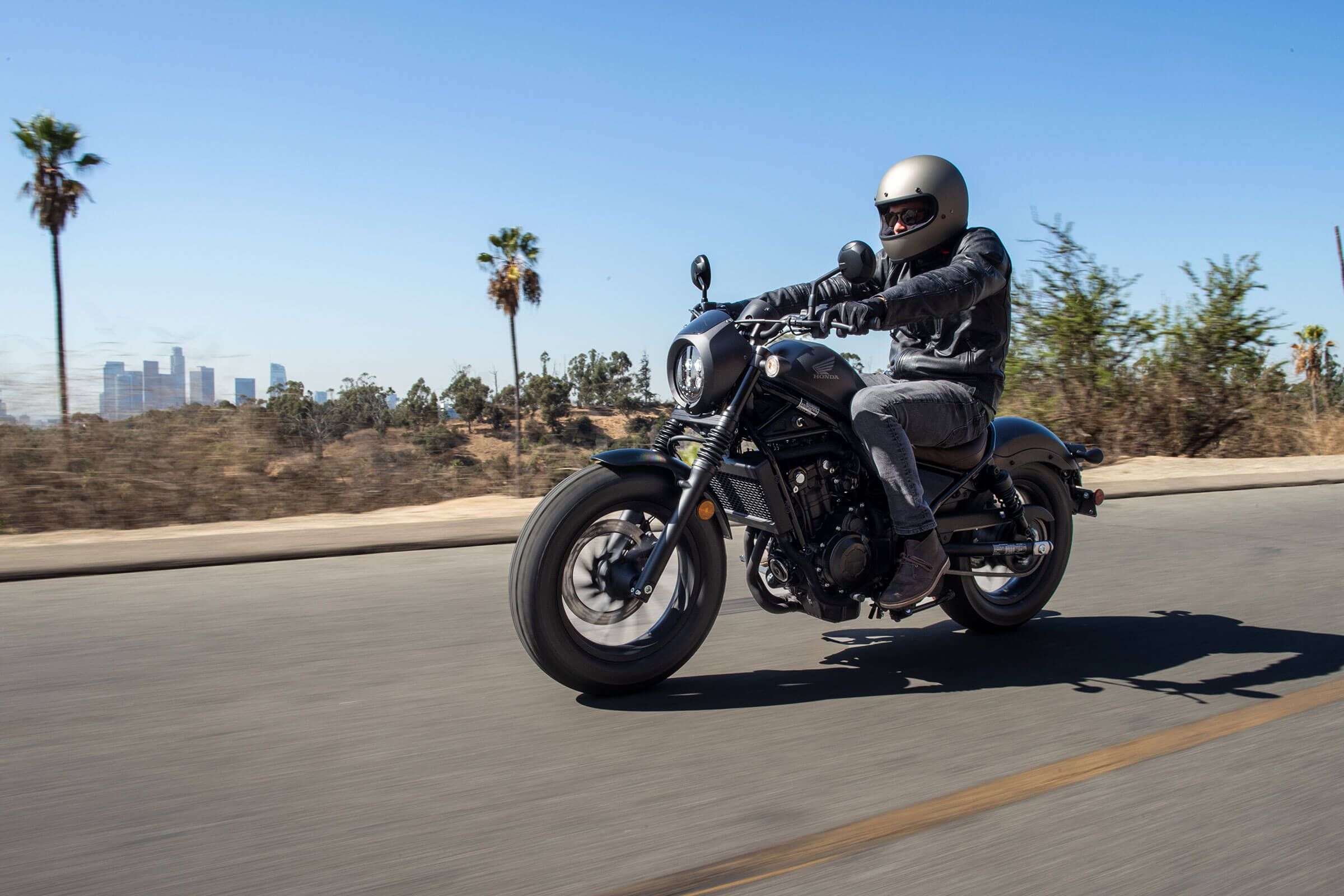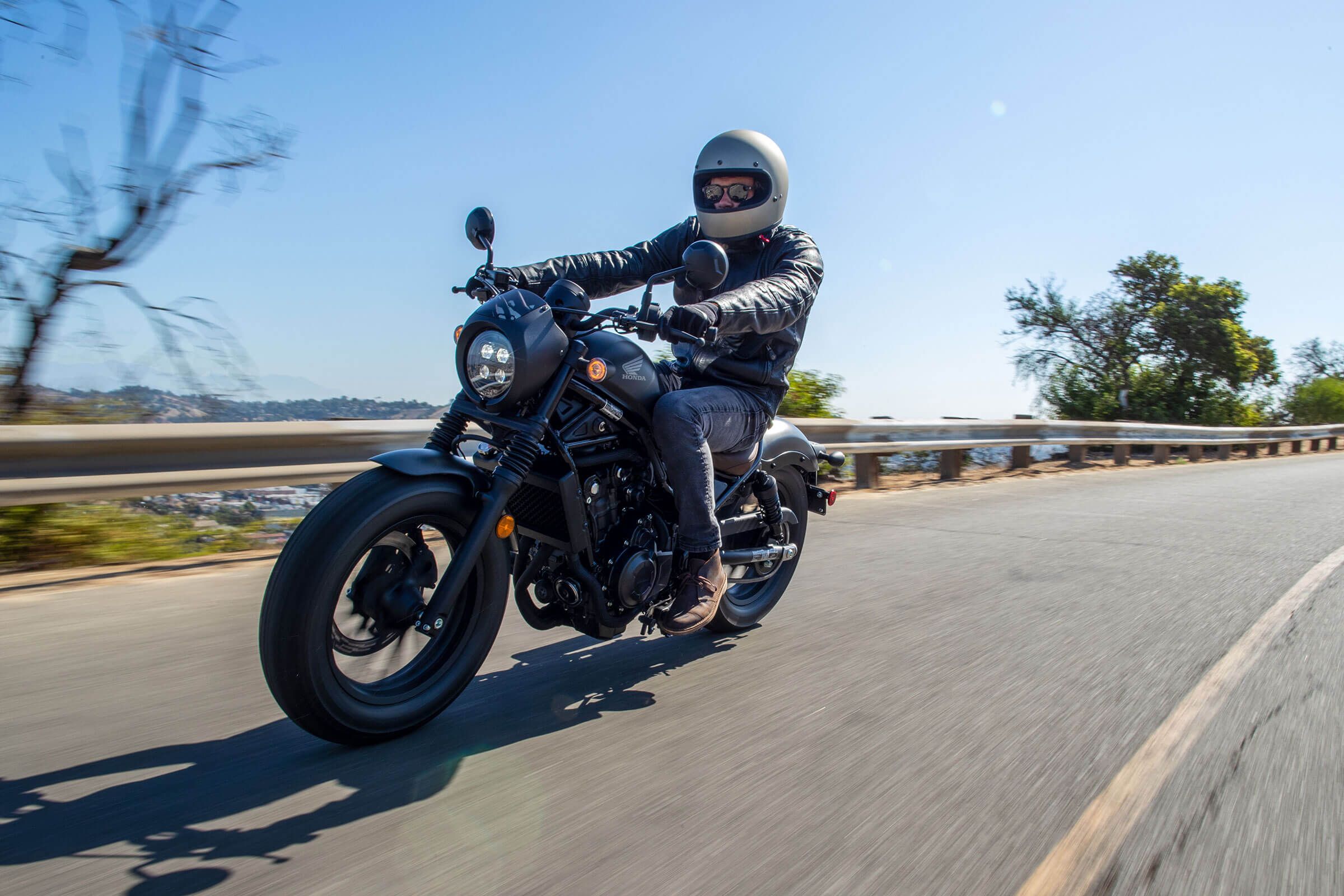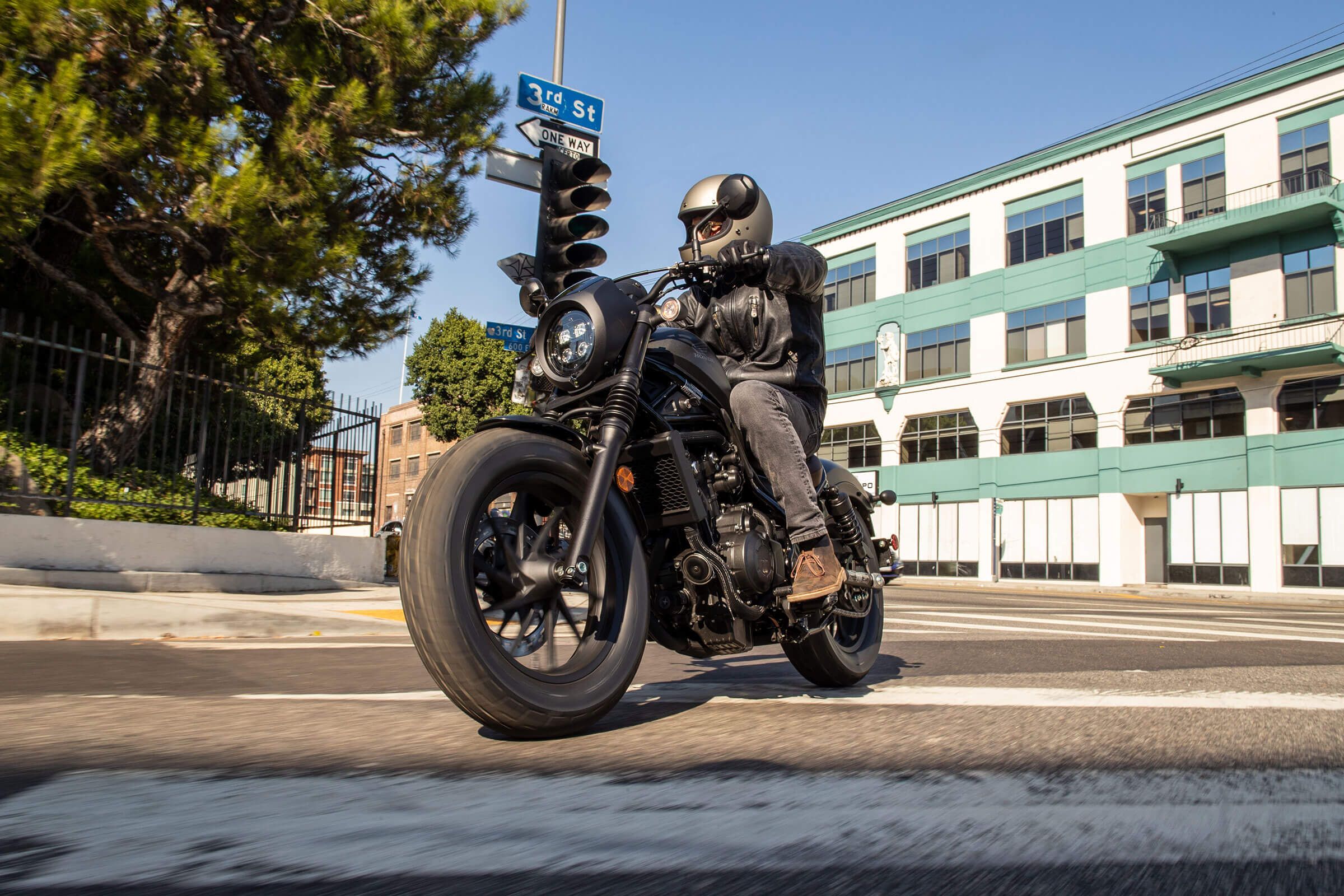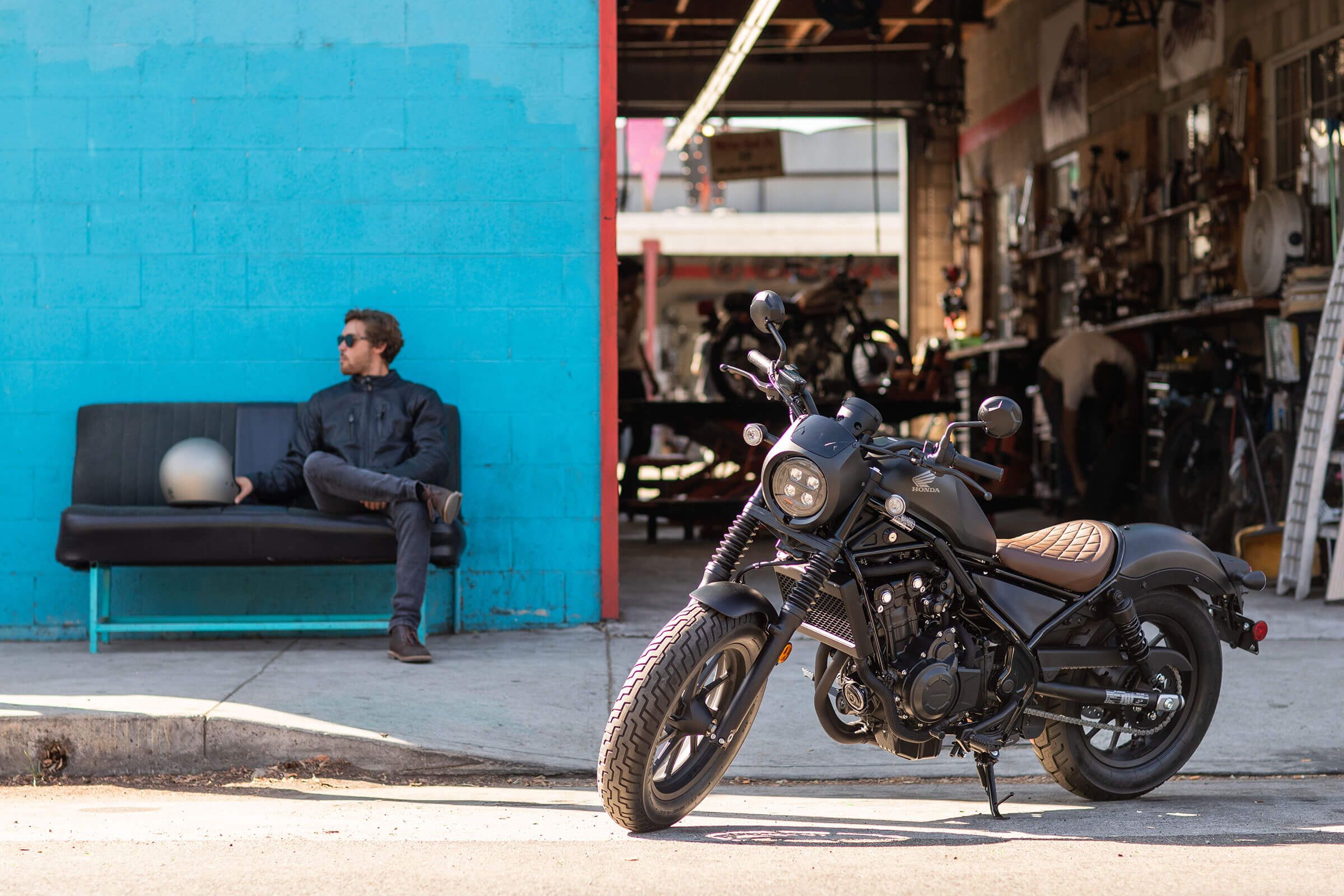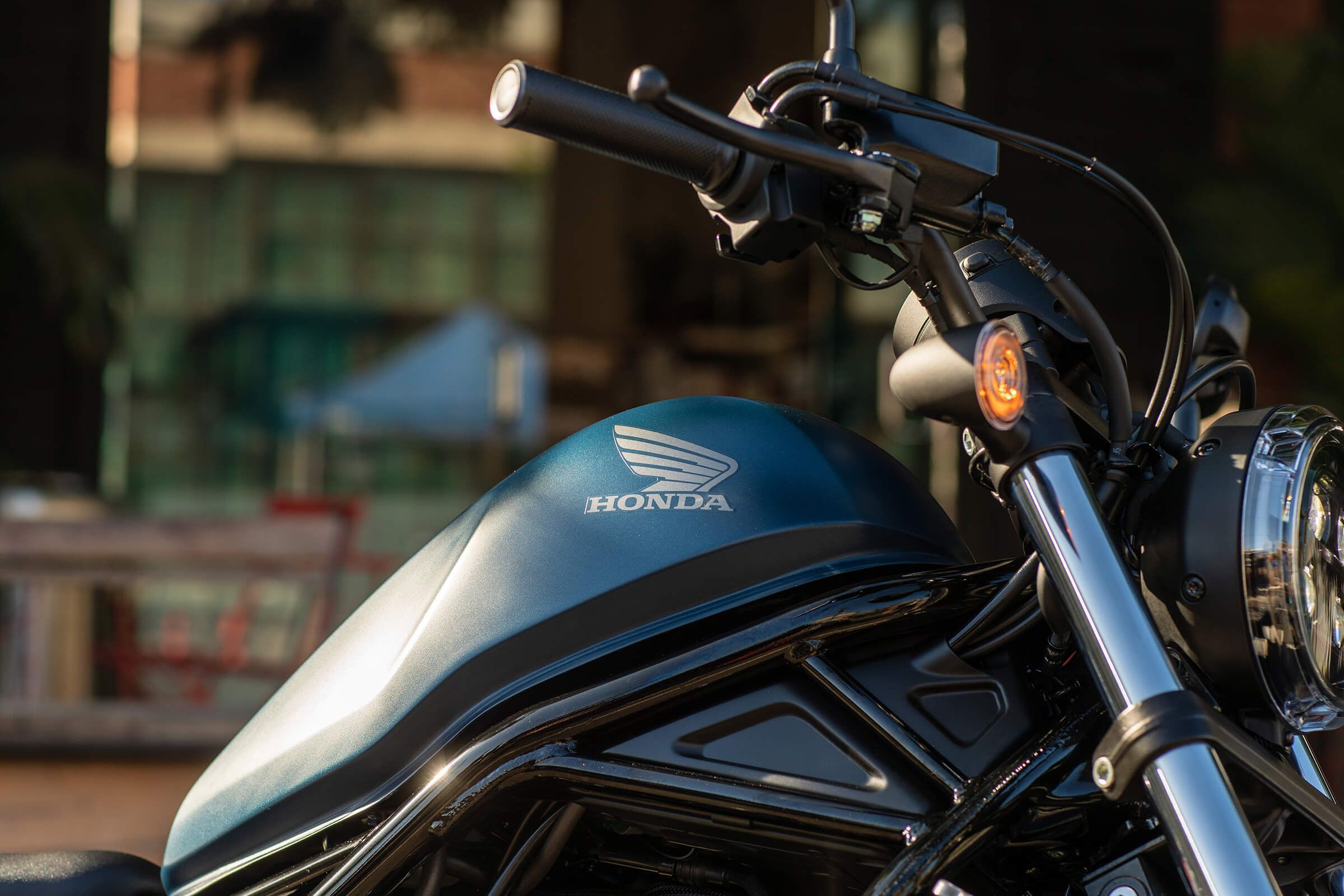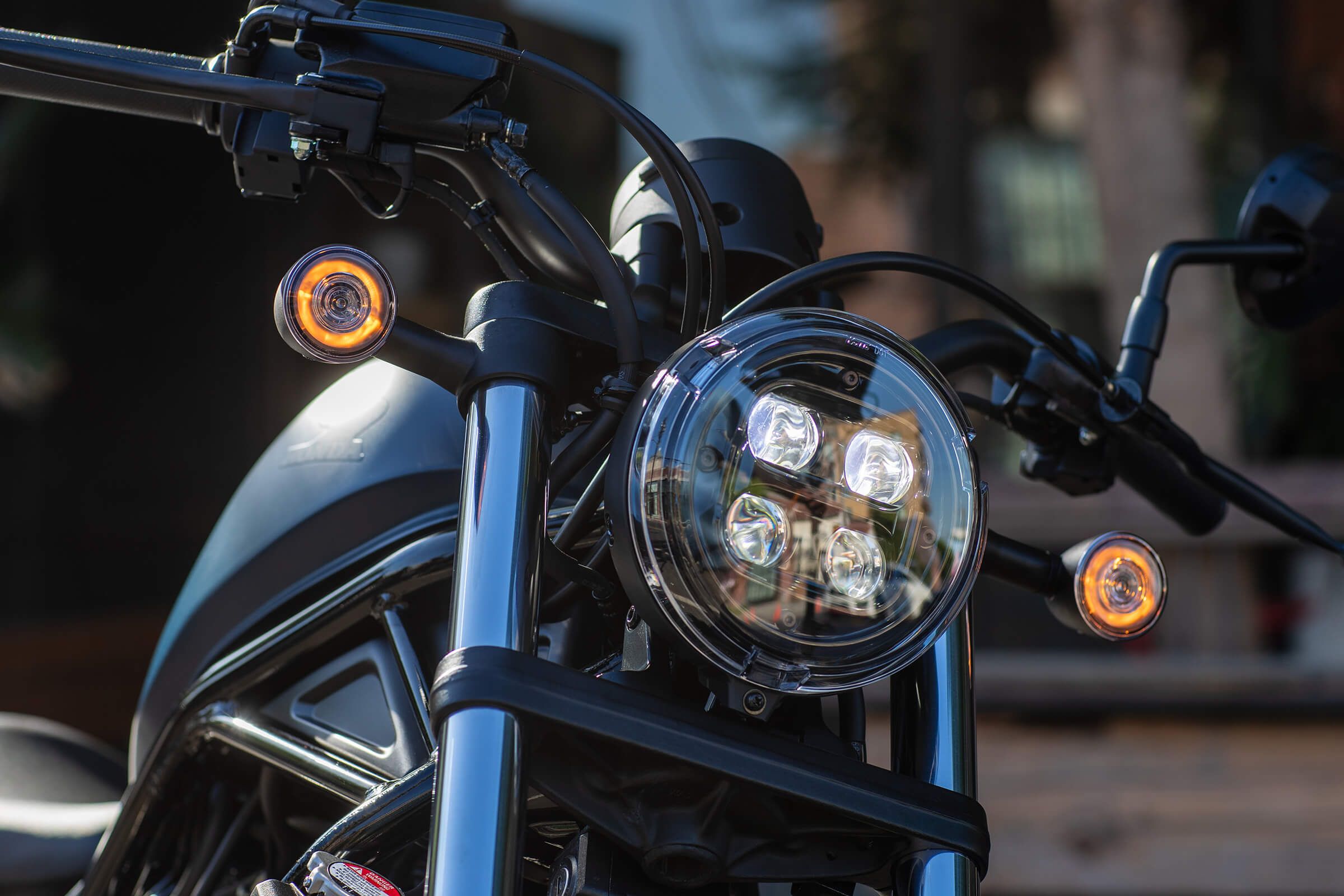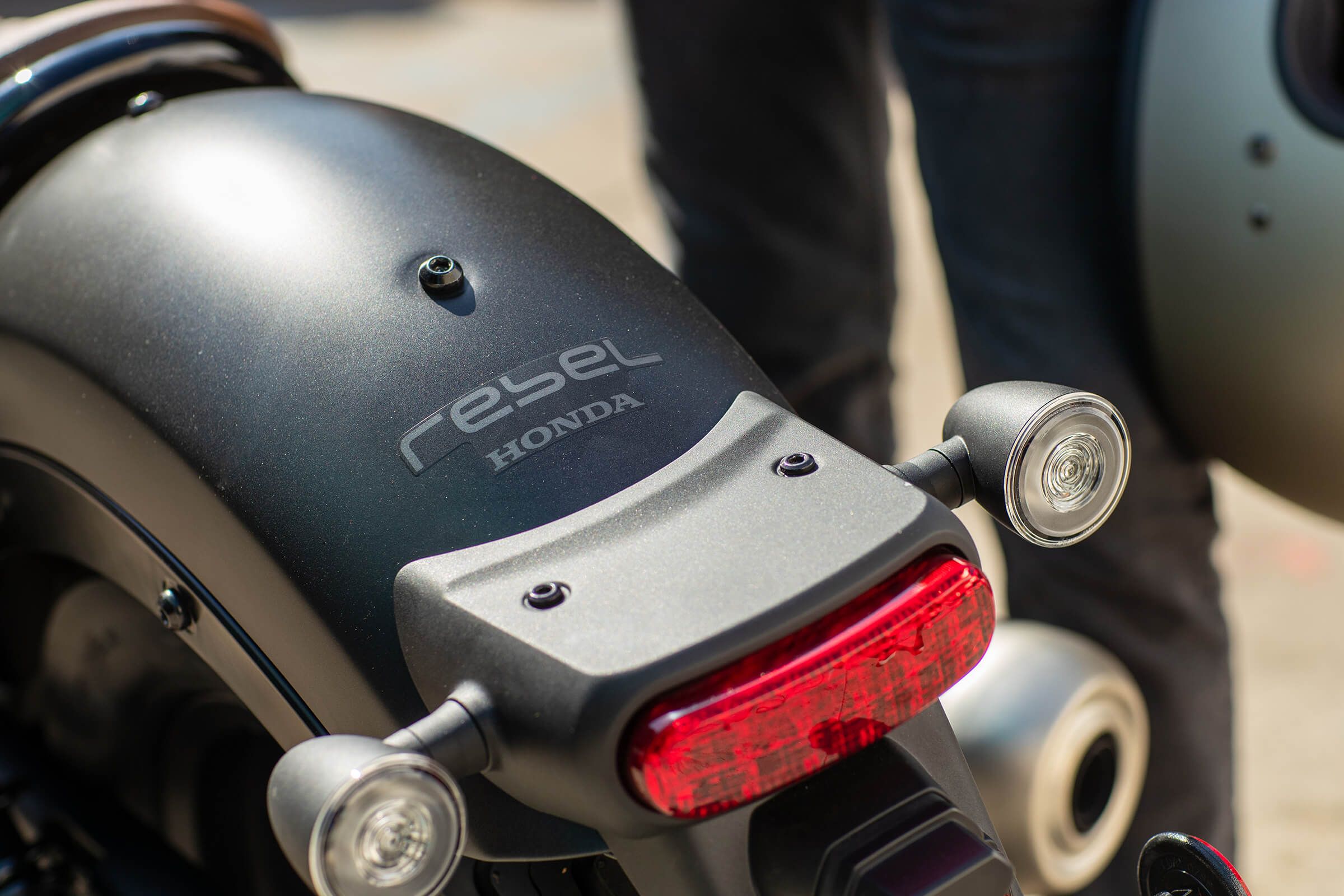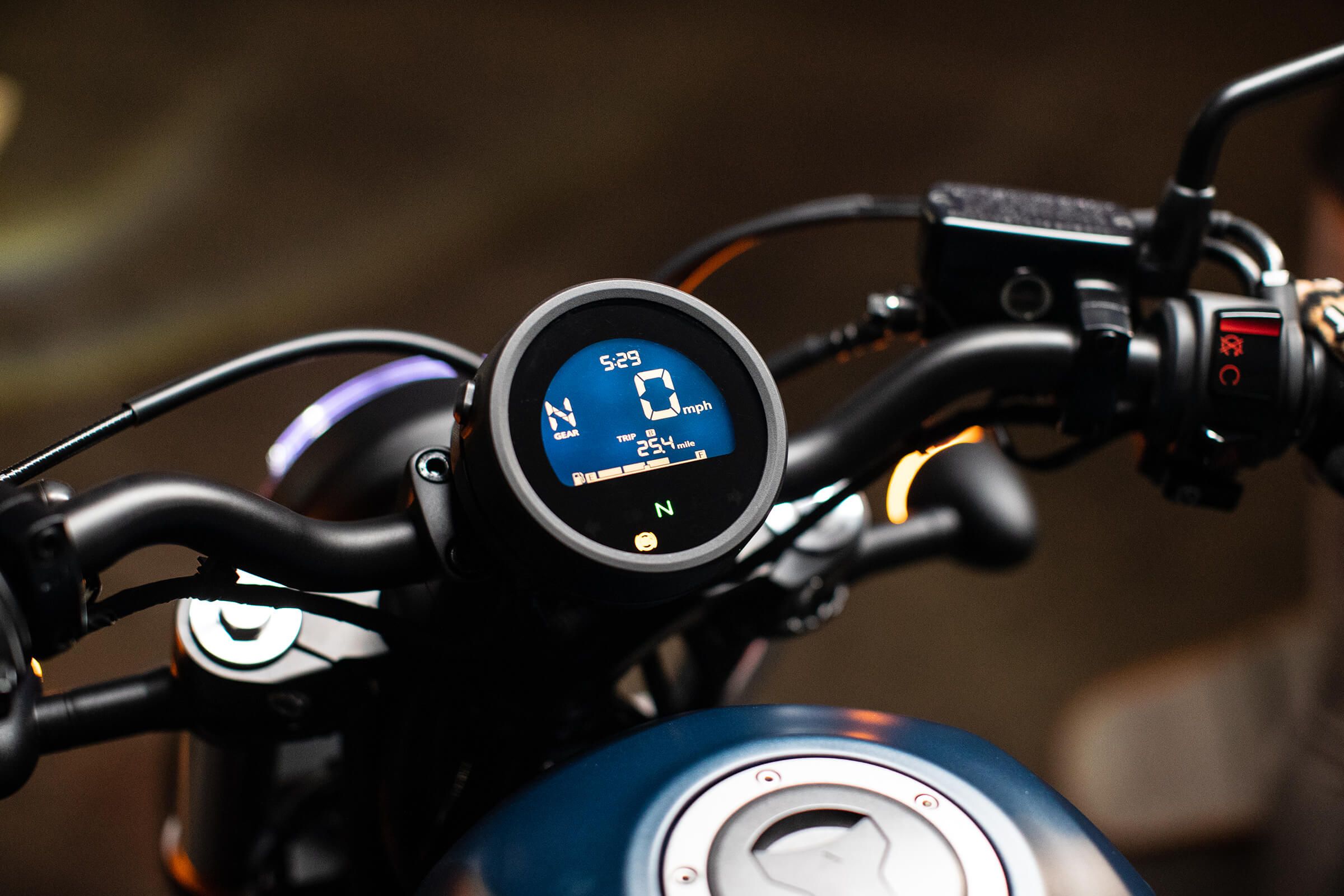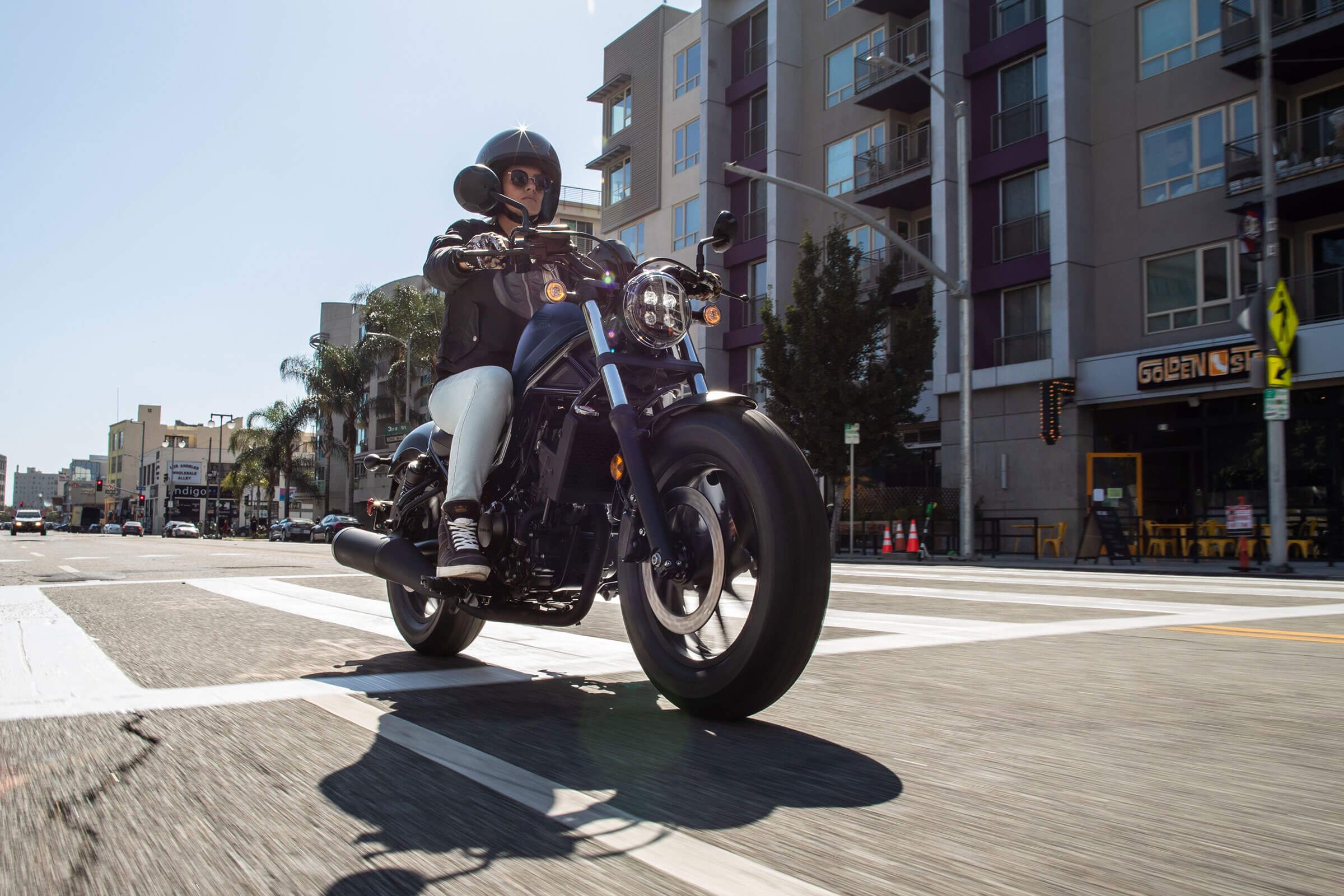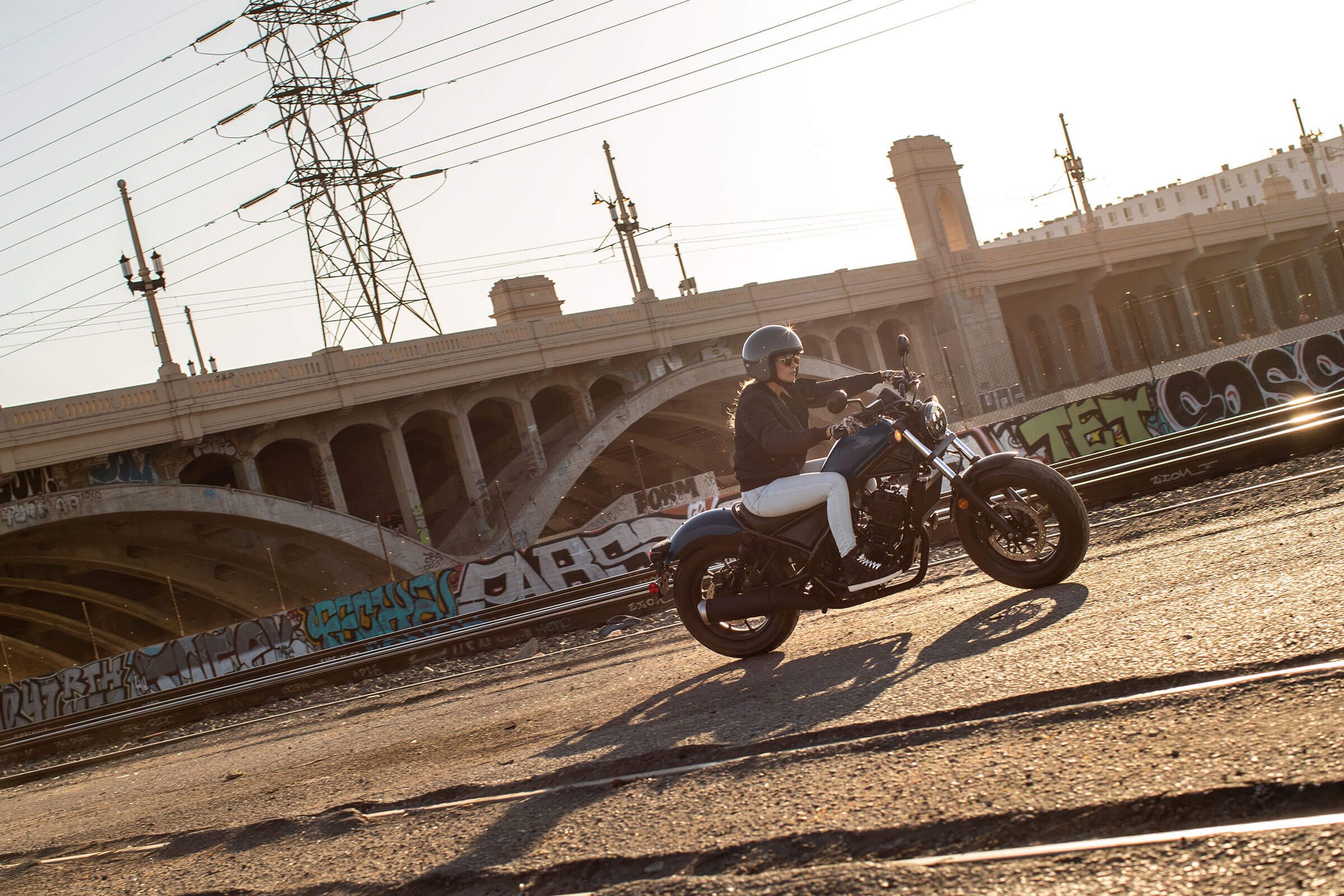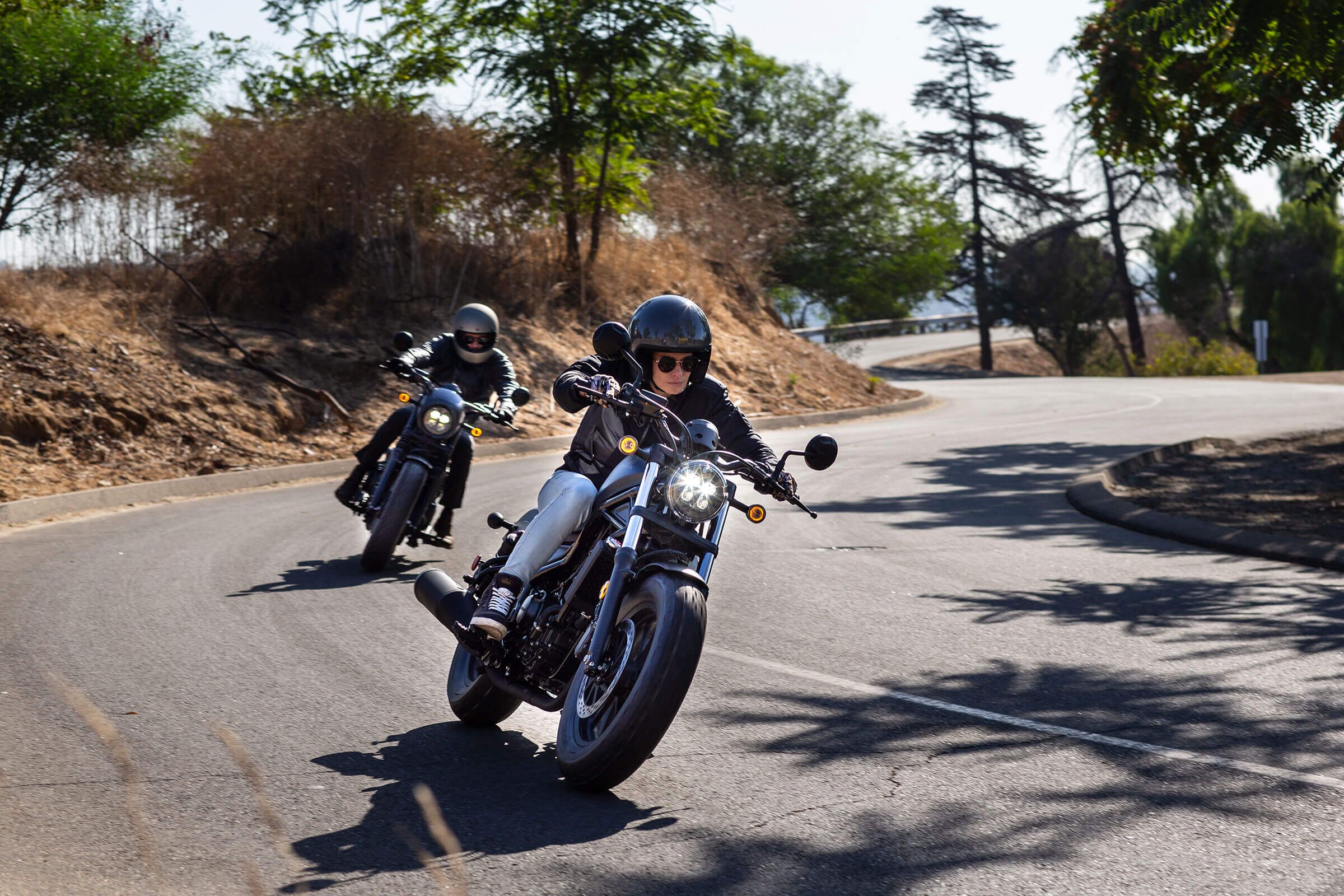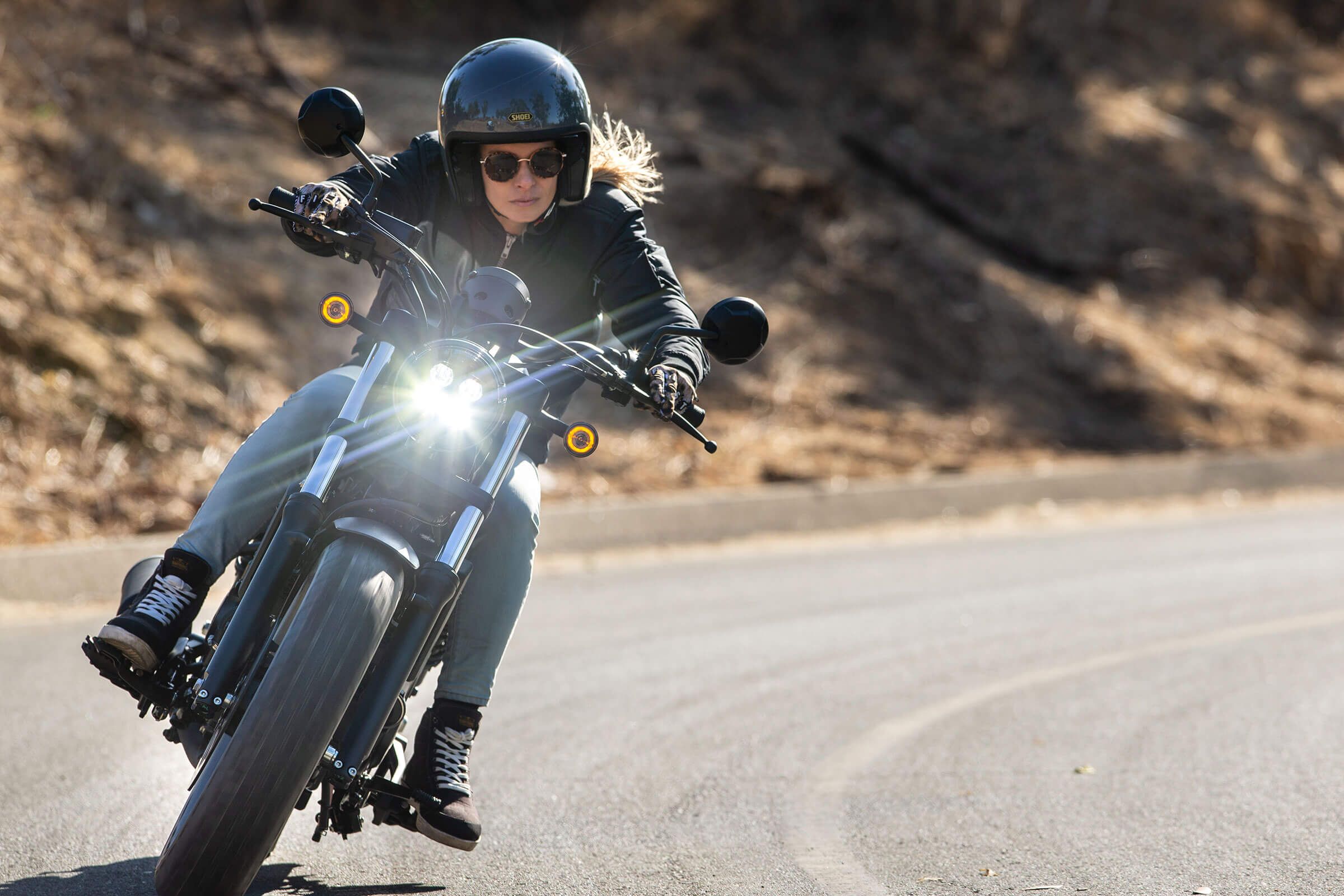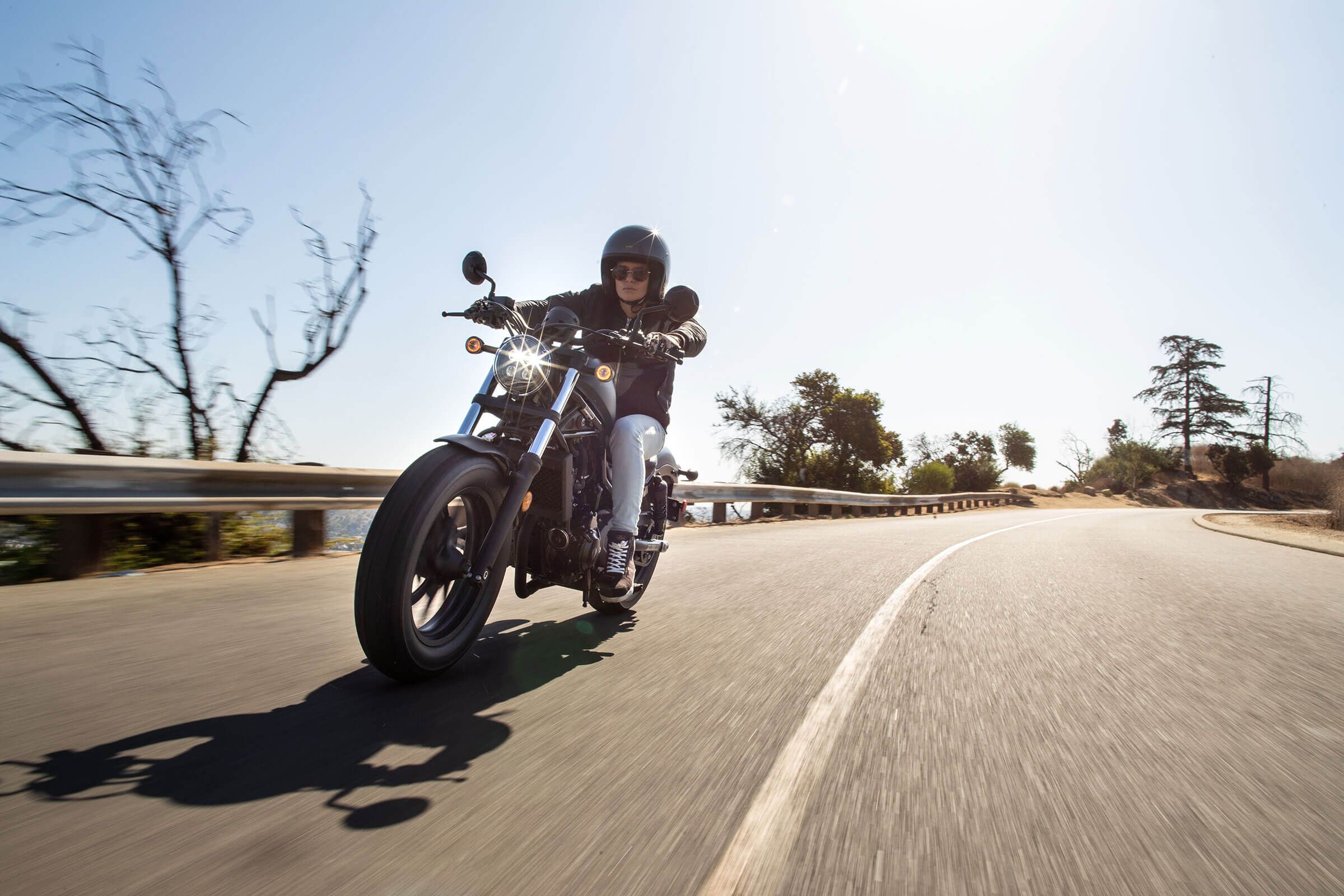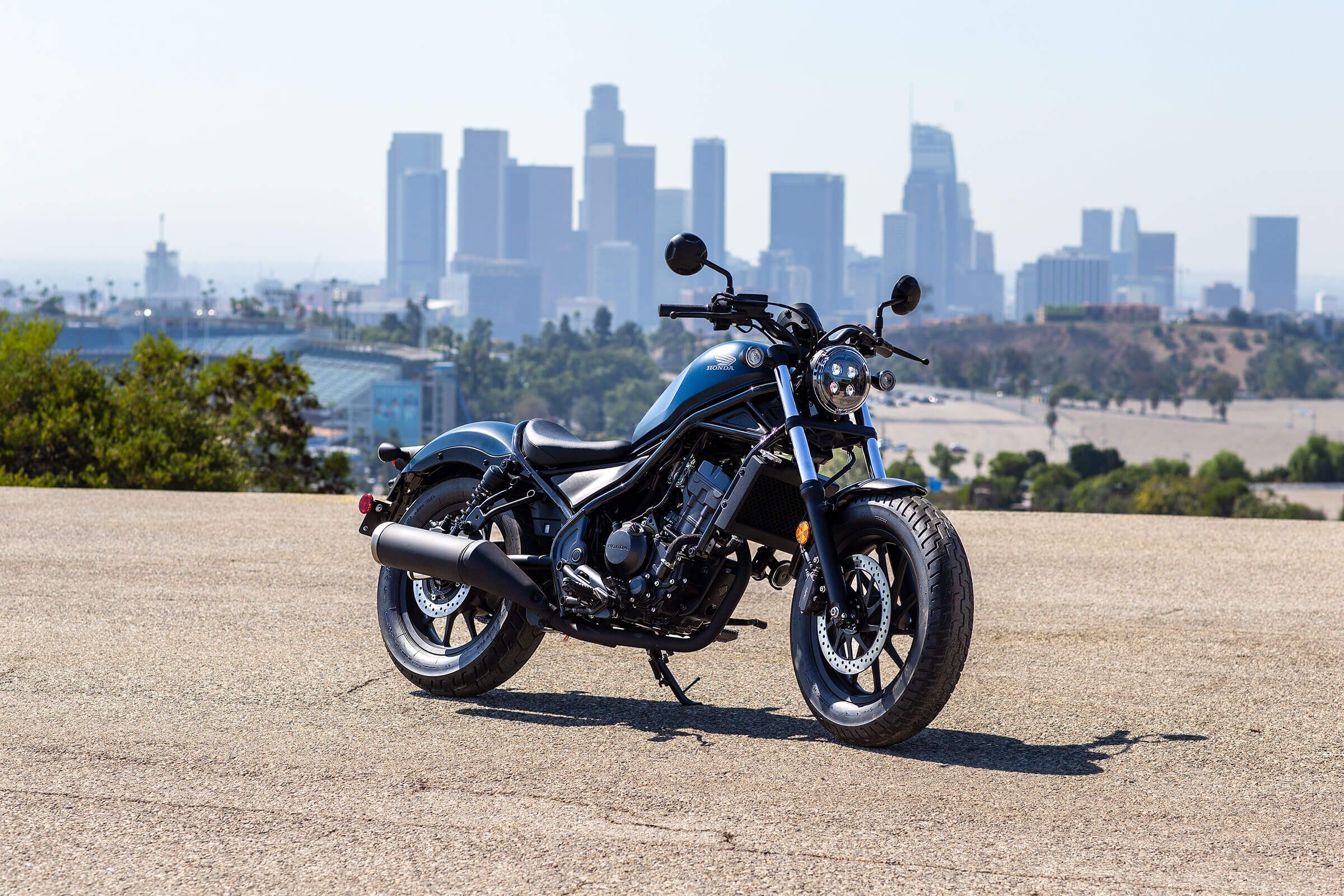Honda brought one of its most recognized model families into the 21st century with a complete overhaul of the much celebrated Rebel range in 2017. Available as the Rebel 300 and 500, this reworked line features water-cooled mills and fuel-injection induction control to meet modern and near-future emissions standards. A sportier look greets the eye this time around, though the Rebel still targets the same small-, entry-level market.
2017 - 2019 Honda Rebel 300 / Rebel 500
- Make: Array
- Model: 2017 - 2019 Honda Rebel 300 / Rebel 500
- Engine/Motor: Parallel-Twin
- [do not use] Vehicle Model: Array
Honda Rebel Design
The original Rebel was released in 1985, and was designed to reflect the custom culture popular among cruiser riders at that time, and the bobbed fenders, low seat height, and buckhorn handlebars struck a chord with the riding public. As popular as it was then, the design was getting rather dated as years went by. Enter the new-from-2017 Rebels that retain the same small-cruiser stance but with a bit of a nouveau-bobber finish. An experienced eye will pick out the similar flylines between this gen and the previous one, but everything below that point are as chalk to cheese.
A fat front tire leads the way beneath the cut-down front fender, and the fuel tank looks cut back as well over the exposed frame members. Unlike the originals, this new generation comes with a solo seat instead of a two-up saddle with an unusual loop behind it that closes off the frame and acts as a mount for the canted-forward shock absorbers. One can only hope the seat is more comfortable than the original, 'cause I can tell you from personal experience that my '87 Rebel was softer than a cinderblock, but not much. Overall, we have a much more modern look with elements borrowed from the sportbike sector that don't look at all out of place on these pocket cruisers, but instead gives them an edgy, modern appeal.
Honda Rebel Chassis
A tubular-steel frame connects to the engines at three points with a pair of downtubes that mount the radiator up under the steering head. Instead of the old backbone-style frame, this new set of bones has an external structure similar to a Trellis frame, and a die-cast aluminum subframe mounts the rear fender struts while keeping things light at the ass end. A tubular swingarm completes the standing rigging with a pair of coil-over shocks on damping duties.
The 28-degree steering head angle and 4.3 inches of trail gives the Rebels a stable demeanor that helps keep the ride from feeling too squirrely, but depending upon which model you choose you are looking at something between 364- and 414-pounds curb weight so that will only help so much. You're still going to feel every gust of wind and pressure wave from the surrounding traffic.
At 41 mm, the front forks are rather beefy for such a small bike and they provide a fairly plush ride with 4.8 inches of travel at the axle, but come with nothing in the way of adjustments. In back, the dual coil-over shocks give up 3.8 inches of travel and come with the usual (read: minimal) preload adjuster but nothing else. One thing that hasn't changed much is seat height; at 27.2-inches tall the new gen is only around a half-inch taller than the original. I gotta say that if that's too tall for you, perhaps the two-wheel life isn't in your cards.
Cast 16-inch wheels mount the 130/90 front and 150/80 rear hoops, and I'm happy to announce that Honda finally abandoned the rear drum brake on the Rebel family. A single-pot caliper binds the 240 mm rear and 296 mm front disc, and both the 300 and 500 have ABS as an available option.
|
Model: |
Rebel 500 |
Rebel 300 |
|
Front Suspension/Travel: |
41mm telescopic fork/ 4.8 in. |
41mm telescopic fork/ 4.8 in. |
|
Rear Suspension/Travel: |
Twin shock/ 3.8 in. |
Twin shock/ 3.8 in. |
|
Rake (Caster Angle): |
28º |
28º |
|
Trail: |
110mm (4.3 in) |
110mm (4.3 in) |
|
Brakes, Front: |
Single 296 mm disc w/ hydraulic calipers; (ABS model W/ABS) |
Single 296 mm disc w/ hydraulic calipers; (ABS model w/ ABS) |
|
Brakes, Rear: |
Single 240 mm disc w/ hydraulic calipers; (ABS model w/ ABS) |
Single 240 mm disc w/ hydraulic calipers; (ABS model w/ ABS) |
|
Tire, Front: |
130/90-16 |
130/90-16 |
|
Tire, Rear: |
150/80-16 |
150/80-16 |
Honda Rebel Drivetrain
Everything up to this point has been consistent across the range, but naturally we have some differences when we get to the engines (hence the ingeniously clever names). At the bottom of the scale we have a 286 cc thumper that breathes through a 38 mm throttle body with electronic fuel injection to meter the juice. This one-lung mill runs a 76 mm bore and 63 mm stroke with a somewhat warm 10.7-to-1 compression ratio.
The larger of the two engines doubles up with a twin-cylinder layout, and the 67 mm bore and 66.8 mm stroke measures out to a total of 471 cc with 34 mm throttle bodies feeding the mill. Dual over-head cams time the four-valve heads across the board, and liquid cooling manages the waste heat for the whole family.
A six-speed gearbox keeps the rpm in the usable range for both models, and unsurprisingly, we have a standard clutch with no slipper or hydraulic-assist in evidence. As usual, Honda is keeping its cards close to the vest, but the engines are close in power delivery to the CBR-R models of similar displacement. The CBR300R puts out 30 horsepower and 20 pounds of grunt, and the CBR500R cranks out 46.9 horses and 31 pounds of torque, so you can consider the Rebels to be plenty strong enough for a pocket cruiser.
|
Model: |
Rebel 500 |
Rebel 300 |
|
Model: |
471 cc liquid-cooled parallel-twin four-stroke, DOHC; four valves per cylinder |
286 cc liquid-cooled single-cylinder four-stroke, DOHC; four valves per cylinder |
|
Rebel 500 |
67.0 mm x 66.8 mm |
76.0 mm x 63.0 mm |
|
Rebel 300 |
10.7:1 |
10.7:1 |
|
Engine: |
PGM-FI; 34mm throttle bodies |
PGM-FI; 38mm throttle bodies |
|
Bore x Stroke: |
Computer-controlled digital transistorized w/ electronic advance |
Computer-controlled digital transistorized w/ electronic advance |
|
Compression Ratio: |
Six-speed |
Six-speed |
|
Induction: |
Chain; 15T/40T |
Chain; 14T/36T |
Honda Rebel Pricing
These models retain the affordability factor of the originals with reasonable price tags. For 2019, the Rebel 300 rolls for $4,499 without ABS and $4,749 with. MSRP on the 500 is $6,199. ABS adds $300 to the price. As of this writing, price has yet to be announced for 2020, but it's going to be in that ballpark.
|
Model: |
Rebel 500 |
Rebel 300 |
|
Model: |
CMX500 |
CMX300 |
|
Rebel 500 |
Transferable, unlimited-mileage limited warranty; extended coverage available with a Honda Protection Plan |
Transferable, unlimited-mileage limited warranty; extended coverage available with a Honda Protection Plan |
|
Rebel 300 |
||
|
└ 2017: |
Matte Silver, Bright Yellow, Black, Red (ABS: Black) |
Matte Silver, Matte Pearl White, Black, Red (ABS: Black) |
|
└ 2018: |
Candy Lightning Blue, Matte Silver Metallic, Black, Red (ABS: Matte Silver Metallic) |
Candy Lightning Blue, Matte Silver Metallic, Black, Red (ABS: Matte Silver Metallic) |
|
└ 2019: |
Matte Fresco Brown, Candy Orange, Matte Gray Metallic |
Pearl Gray, Matte Gray Metallic, Candy Orange |
|
└ 2020: |
Matte Armored Silver, Matte Blue Jeans Metallic, Graphite Black |
Matte Blue Jeans Metallic, Matte Fresco Brown, Graphite Black |
|
Model ID: |
||
|
└ 2017: |
$5,999 |
$4,399 |
|
└ 2018: |
$6,099 |
$4,449 |
|
└ 2019: |
$6,199 (w/ABS:$6,499) |
$4,499 (w/ABS: $4,749) |
|
└ 2020: |
TBD |
TBD |
Honda Rebel Competitors
The usual suspects just didn't seem appropriate anymore since they are all so last century, so instead I looked for another sporty pocket-cruiser and found a likely competitor in the Harley-Davidson Street 750. Both are built for a younger market, and as such carry features and looks that somewhat blur the line between sport and cruise. Granted, the Rebel carries more of an Asian/Euro sport flavor blended with its cruise-tastic ingredients and the Street reaches for more of a cafe' racer look that is equally as sporty, just with a healthy dose of Americana mixed in.
ABS is optional across the board, but Harley adds a security option that has no equivalent on the Honda side. In one of the few times Harley didn't exactly wow us by offering only red, blue, and two shades of black on the palette in 2017; it was a let-down from the King of Paint, but it allowed for a competitive comparison with the plain-Jane offerings that is usual from Honda. For 2018, Honda lost that foothold when Harley expanded the palette for the Street 750 to its more usual plethora of eye-catching paint.
At 750 cc, the H-D mill has quite a few cubes on the Honda's 471 cc displacement, and that shows up in the power figures with a claimed 43.5 pound-feet of torque from the H-D twin against Honda's 31 pounds o' grunt. Honda picks up a win at the till with a price of $6,199 for its non-ABS Rebel 500, while Harley asks $7,599 for its Vivid Black model, and jacks it up to $8,094 for the top shelf, two-tone package.
In the end, they are comparable, and folks who have to have a Harley won't bat an eye at the price difference, but folks not Hell bent for leather are going to find the new Rebel an attractive alternative.
He Said
“As much as I liked the original Rebel, I gotta say the new one is pretty boss. The design is modern, but not overly so, and while it doesn't look much like the original it does enjoy a certain charm all its own. Having said that, the previous gen enjoys a rather devout following with a whole custom culture built around it, and only time will tell if the new gen will draw the same kind of fanbase. “
She Said
My wife and fellow motorcycle writer, Allyn Hinton, says, "When I first saw the new Rebel, I said 'Wow!' But now that the initial surprise has worn off, I'm not sure what to think about it. Yes, it is more modern and it will attractive some new folks to the fan-base, but I wonder what the die-hard Rebel fans are going to say. I think I prefer the old Rebel look, but I do like the technology on the new model, if for nothing else, at least for the rear disc brake."
Honda Rebel Specifications
|
Model: |
Rebel 500 |
Rebel 300 |
|
Model: |
||
|
Engine: |
471 cc liquid-cooled parallel-twin four-stroke, DOHC; four valves per cylinder |
286 cc liquid-cooled single-cylinder four-stroke, DOHC; four valves per cylinder |
|
Bore x Stroke: |
67.0mm x 66.8mm |
76.0mm x 63.0mm |
|
Compression Ratio: |
10.7:1 |
10.7:1 |
|
Induction: |
PGM-FI; 34mm throttle bodies |
PGM-FI; 38mm throttle bodies |
|
Ignition: |
Computer-controlled digital transistorized w/ electronic advance |
Computer-controlled digital transistorized w/ electronic advance |
|
Transmission: |
Six-speed |
Six-speed |
|
Final Drive: |
Chain; 15T/40T |
Chain; 14T/36T |
|
Rebel 500 |
||
|
Front Suspension/Travel: |
41mm telescopic fork/ 4.8 in. |
41mm telescopic fork/ 4.8 in. |
|
Rear Suspension/Travel: |
Twin shock/ 3.8 in. |
Twin shock/ 3.8 in. |
|
Rake (Caster Angle): |
28º |
28º |
|
Trail: |
110 mm (4.3 in) |
110 mm (4.3 in) |
|
Brakes, Front: |
Single 296 mm disc w/ hydraulic calipers; (ABS model W/ABS) |
Single 296 mm disc w/ hydraulic calipers; (ABS model w/ ABS) |
|
Brakes, Rear: |
Single 240 mm disc w/ hydraulic calipers; (ABS model w/ ABS) |
Single 240 mm disc w/ hydraulic calipers; (ABS model w/ ABS) |
|
Tire, Front: |
130/90-16 |
130/90-16 |
|
Tire, Rear: |
150/80-16 |
150/80-16 |
|
Rebel 300 |
||
|
Seat Height: |
27.2 in. |
27.2 in. |
|
Ground Clearance: |
5.4 in. |
5.9 in. |
|
Wheelbase: |
58.7 in. |
58.7 in. |
|
Fuel Capacity: |
2.96 gal. |
2.96 gal. |
|
Fuel Economy: |
67 mpg |
78 mpg |
|
Curb Weight: |
408 lbs.(ABS: 414 lbs.) |
364 lbs. (ABS: 370 lbs.) |
|
Top Speed: |
95 mph (est) |
85 mph (est) |
|
Engine & Drivetrain: |
||
|
Model ID: |
CMX500 |
CMX300 |
|
Warranty: |
Transferable, unlimited-mileage limited warranty; extended coverage available with a Honda Protection Plan |
Transferable, unlimited-mileage limited warranty; extended coverage available with a Honda Protection Plan |
|
Color: |
||
|
└ 2017: |
Matte Silver, Bright Yellow, Black, Red (ABS: Black) |
Matte Silver, Matte Pearl White, Black, Red (ABS: Black) |
|
└ 2018: |
Candy Lightning Blue, Matte Silver Metallic, Black, Red (ABS: Matte Silver Metallic) |
Candy Lightning Blue, Matte Silver Metallic, Black, Red (ABS: Matte Silver Metallic) |
|
└ 2019: |
Matte Fresco Brown, Candy Orange, Matte Gray Metallic |
Pearl Gray, Matte Gray Metallic, Candy Orange |
|
└ 2020: |
Matte Armored Silver, Matte Blue Jeans Metallic, Graphite Black |
Matte Blue Jeans Metallic, Matte Fresco Brown, Graphite Black |
|
Price: |
||
|
└ 2017: |
$5,999 |
$4,399 |
|
└ 2018: |
$6,099 |
$4,449 |
|
└ 2019: |
$6,199 (w/ABS:$6,499) |
$4,499 (w/ABS: $4,749) |
|
└ 2020: |
TBD |
TBD |
Further Reading
Harley-Davidson Street 500 / 750
See our review of the Harley-Davidson Street 500 / 750.
Honda CBR300R
See our review of the Honda CBR300R.
Honda CBR500R
See our review of the Honda CBR500R.
Honda
Read more Honda news.


